- Articles and Guides

11 Best Small Sailboat Brands: How to Choose Your Next Daysailer or Pocket Cruiser
12th oct 2023 by samantha wilson.

Sailing is a relaxing, invigorating pastime that allows you to harness wind and waves in a unique and historic way without requiring a 50-foot yacht to enjoy what’s special about the experience. In fact, small sailboats allow a delightful back-to-basics experience that often gets lost on larger, systems-heavy sailboats.
On a small sailboat you can connect with the sea, feeling the boat move beneath you. The boat is typically easy to rig, simple to sail, and can even be sailed solo. Small sailboats give you the freedom to trailer your or car-top your boat and go anywhere, and they’re perfect for learning the nuances of sailing. There are many excellent brands and models of small sailboat, each with their own appeal, and here we narrow down some of our favorite in the daysailer and pocket cruiser categories under 30 feet.
Difference Between a Daysailer and a Pocket Cruiser
While there are many different types of sailboat on the market and there is no single definition of either a daysailer or a pocket cruiser, they are used in a particular way, as the names imply. The term daysailer covers a huge array of sailboats, smaller and sometimes larger, and is generally defined as any day boat used for local sailing, with a simple rig, and easy to get underway. A pocket cruiser typically offers a cabin and head, and adequate accommodations for an overnight stay and sometimes longer cruises. Having said that, there is a large overlap between the two in many instances, so the lines may become blurred.
What Size is a Small Sailboat?
Small is a relative term of course, but in general—and for the purposes of this article—a small sailboat is one that could be sailed by a small crew, often with one or two people aboard. It will have a simple rig and be trailerable, and it might be either a daysailer or pocket-cruiser style vessel as above. Within those categories, there are many models and styles, but when it comes to length we consider a sailboat as small when it’s under 30 feet in overall length.
The Best Sailboats Under 30 Feet
Pocket cruiser: Beneteau First 27. The Beneteau First 27 is a modern example of a pocket cruiser, earning Cruising World ’s Boat of the Year award in the Pocket Cruiser category in 2022. With space for up to six people accommodated in a separated bow-cabin and open saloon, it offers families the chance to go farther, explore more, and cruise in comfort. There is a galley with freshwater and a head, adding to the interior home comforts. The sailboat itself is modern, fast, and stable, designed by Sam Manuard, and has been designed to be incredibly safe and almost unsinkable thanks to its three watertight chambers. The handling is also refreshingly intuitive, with a well-designed cockpit, simple deck controls, and double winches allowing it to be sailed solo, by two people, or a small crew.

Photo credit: Beneteau
Daysailer: Alerion 28. You’ll certainly turn heads cruising along in an Alerion 28, a daysailer whose forerunner by the same name was designed by Nathanael Herreshoff in 1912 and then updated with a modern underbody for fiberglass production by Carl Schumacher in the late 1980s. This pretty daysailer manages to combine a traditional silhouette and classic feel, with very modern engineering creating an excellent package. Over 470 of these sailboats were built and sold in the past 30 years, making it one of the most popular modern daysailers on the water. With a small cabin and saloon, complete with miniature galley area, it offers respite from the sun or wind and the option for a night aboard. The cockpit offers a beautiful sailing experience, with plenty of space for the whole family.

Photo credit: Alerion Yachts
The Best Sailboats Under 25 Feet
Pocket cruiser: Cornish Crabber 24. British manufacturer Cornish Crabber has been producing beautiful, traditional style small sailboats for decades, ensuring they honor their heritage both in the construction style and appearance of their boats. The Cornish Crabber 24 is the most iconic of their range and dates back to the 1980s. It offers a simple yet surprisingly spacious interior layout with cabin, galley, and head, and a good sized cockpit, as well as seating for up to six people. It’s the perfect family sailboat, with clever use of storage as well as just under 5000 pounds of displacement providing stability and easy tacking. Aesthetically the 24 is simply beautiful, with a traditional silhouette (combined with modern engineering), finished in hardwood trims.

Photo credit: Cornish Crabber
Daysailer: Catalina 22 Capri. Catalina sailboats need little introduction, and are one of the world’s best-known, most-respected brands building small sailboats. The Catalina 22 Capri (also available in a sport model) is a great example of what Catalina does so well. While we’ve classified it as a daysailer, it could easily cross into the pocket cruiser category, as it offers excellent sailing performance in almost all conditions as well as having a small cabin, galley, and head. Loved for its safety, stability, ease of handling and simple maintenance, it makes for a good first family boat for getting out onto the bay or lake.

Photo credit: Catalina
The Best Sailboats Under 20 Feet
Pocket cruiser: CapeCutter 19. This is another model that combines the beauty of the traditional silhouettes with modern-day advancements. The design originates from the classic gaff cutter work boats, but today offers excellent performance—in fact it’s one of the fastest small gaffers in the world. The interior is cleverly spacious, with four berths, two of which convert into a saloon, as well as a simple galley area. With quick rigging, it can be sailed solo, but is also able to accommodate small groups, making it a capable and hugely versatile pocket cruiser.

Photo credit: Cape Cutter 19
Daysailer: Swallow Yachts’ BayRaider 20. Classic looks with modern performance are combined in Swallow Yachts’ beautiful BayRaider 20. This is one of the most capable and safest daysailers we’ve seen, but also incredibly versatile thanks to the choices of ballast. Keep the ballast tank empty and it’s light and fast. Fill the tank up and you’ve got a stable and safe boat perfect for beginners and families. While it’s got an eye-catching traditional style, the engineering is modern, with a strong carbon mast and construction. While this is a true daysailer, you can use the optional spray hood and camping accessories to create an overnight adventure.

Photo credit: Swallow Yachts
The Best Sailboats Under 15 Feet
Pocket Cruiser: NorseBoat 12.5. Can we truly call the NorseBoat 12.5 a pocket cruiser? Yes we can! The sheer versatility of this excellent little sailboat has convinced us. These beautiful hand-crafted sailboats offer exceptional performance and are described by the manufacturer as ‘the Swiss Army Knives of sailboats’. The traditionally styled 12.5 can be sailed, rowed, and motored. It can be trailered, easily beached, and even used as a camp cruiser, allowing for overnight adventures. There is no end to the fun that can be had with this easy-to-sail and easy-to-handle boat, which makes it a dream to learn in. With positive flotation, lots of clever storage, and a full-size double berth for camp cruising, it really is the perfect mini pocket cruiser.

Photo credit: NorseBoats
Daysailer: Original Beetle Cat Boat 12: All across the bays of the US east coast cat boats have long been part of the ocean landscape. Able to access shallow rocky coves yet also withstand the strong coastal winds, these traditional New England fishing boats have an iconic shape and gaff-rigged mainsails. Beetle Cat have been producing elegant wooden cat boats for over 100 years – in fact they’ve made and sold over 4,000 boats to date. Their 12 foot Cat Boat 12 is one of their finest models, offering lovely daysailing opportunities. It has a wide beam and centerboard that lifts up, allowing it to access shallow waters, as well as a forward mast and single sail gaff rig in keeping with the traditional cat boats. To sail one of these is to be part of the heritage of New England and Cape Cod, and to honor the ancient art of hand-made boat building.
Beetle Cat official website

Photo credit: Beetle Cat
The Best Small Sailboats for Beginners
When it comes to learning to sail, it’s important to have a boat that is easy to handle. There’s no quicker way to put yourself or your family off sailing than to start off with a boat that is either too big or too complicated. When choosing your first boat we recommend the following characteristics:
- Small: The benefits of starting off with a small boat are many, as we’ve seen above. They’re easier to control as well as to moor, and they react more quickly to steering and sails. They can be trailered and launched easily, and the loads generated are much lower than on bigger, heavier boats.
- Easy to sail: You want a boat that is stable and forgiving of mistakes, doesn’t capsize easily, and isn’t too overpowered in a stronger breeze. Keep things simple and learn as you go.
- Simple sail configuration: Choosing a boat that can be rigged by one person in a few minutes, and easily sailed solo, makes it easier to take along inexperienced crews. With regards to the rig, all you need are a halyard to hoist the mainsail and a sheet to control the mainsail.
- Tiller steering: We recommend boats with tiller steering over wheel steering when starting out. The tiller allows you to get a real feel for the boat and how the rudder works as it moves through the water.
For more information on choosing the best beginner sailboat check out our full guide. There are many popular brands of beginner boats including Sunfish, Laser, and Hunter Marlow. Some of our favorites include;
Hobie 16: The classic Hobie catamaran has been a well-loved beginner sailboat for years, and the Hobie 16 started life back in 1969. Since then they’ve made and sold over a staggering 100,000 of the 16s. It has twin fiberglass and foam hulls, a large trampoline, and a pull-up rudder so it can be sailed straight onto the beach. The basic package comes with an easy to handle main and jib with plenty of extras available too such as a spinnaker and trailer. The Hobie 16 promises a great learning experience and lots of fun in a very nifty and inexpensive package.

Photo credit: Hobie
Paine 14: You’ll immediately fall in love with sailing when you step into a beautiful Paine 14. Made from seamless epoxy cold-molded wood, the P-14 is simply beautiful and offers the classic sailing experience with the design and innovation of a more modern hull and rig. Two people will be able to enjoy getting out on the water together and learning the ropes. The Paine 14 has a lead ballast keel that accounts for nearly half her weight, giving her the feel of a much larger boat, but is still trailerable and easy to manage offering the best of both worlds.

Photo credit: Chuck Paine
High-Performance Small Sailboats
Small sailboats generally become high performers if they are light, have a lot of sail area, or they have more than one hull. More recently, some of have been designed with foiling surfaces, as well. For the purposes of this article, we’d like to close by pointing out one model that is super fast and has versatile pocket-cruising capabilities.
Corsair 880 trimaran : The Corsair 880 trimaran is the grandchild of the company’s F27, a model that launched the popularity of trailerable leisure trimarans about 40 years ago. The 880 has taken the model to new heights and exemplifies the incredible space benefits you can achieve in a 29-foot sailboat. We’re talking an aft cabin, room to sleep 5 people, an enclosed head, and standing headroom in the galley and main saloon. It brings many of the opportunities that a much larger yacht plus the ability to cruise in extremely shallow water. Whether you want to cruise to the Bahamas or enjoy a high-adrenaline race, the Corsair 880 offers incredible performance and unlimited adventures in a truly pocket size.

Photo credit: Corsair
Written By: Samantha Wilson
Samantha Wilson has spent her entire life on and around boats, from tiny sailing dinghies all the way up to superyachts. She writes for many boating and yachting publications, top charter agencies, and some of the largest travel businesses in the industry, combining her knowledge and passion of boating, travel and writing to create topical, useful and engaging content.

More from: Samantha Wilson
Related Articles and Guides
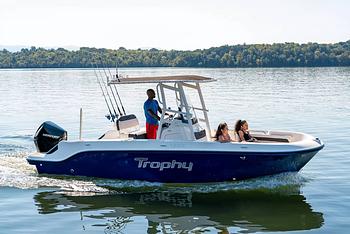
7th Apr 2024
Best Cheap Fishing Boat Brands, Affordable to Cheapest of All
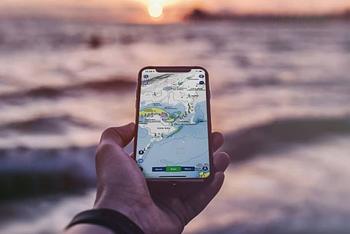
30th Mar 2024
Best Boat Navigation Apps for Smartphones
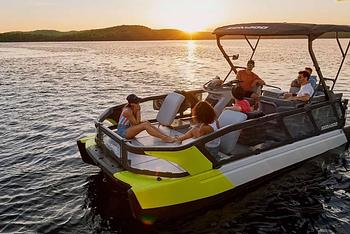
29th Mar 2024
Best Jet Boat Brands Among All Types of Small Craft

26th Mar 2024
Best Sport Fishing Boats, Convertible and Express to Center Console
- Explore Rightboat
- Boats for Sale
- Boating Articles
- Buyers Guide
- About RightBoat
- Sell Your Boat
- Boat Selling Advice
Enter your email to keep up to date with the latest news
Join for free
Sign up now for free and discover how easy it is to keep up to date with THE latest boats for sale. Find your right boat, and tailor your voyage to finding your next boat.
Benefits of becoming a member:
- Set up tailored alerts
- Personalise your experience
- Download full specifications and broker details
- Keep tabs on your favourite boats
Are you a broker? Join as a Broker
Rightboat - join for free.
Do you have an account already? Login
Save this search
Save your search and receive new boats in your email..
You can unsubscribe from your alerts whenever you like. By pressing the button you accept the Legal Terms and conditions
Small Sailboat Types: Choose the Perfect One For You
A boat's weight, draft, and sail area often affect its performance in different wind and water conditions. For this reason, sailors often prefer small sailboats because they are easy to handle, have simple rigging and sail plans, and are also more affordable. In this article, we'll help you choose the perfect type of small sailboat that fits your experience and budget.
The most common types of small sailboats include dinghies, daysailers, sloops, and catamarans. Dinghies are small, lightweight boats that are easy to launch and sail, while daysailers are slightly larger but more comfortable. Sloops are characterized by a single-mast rig, while a catamaran has two hulls, which provide stability.
To choose the right small sailboat for your needs, there are three important factors to keep in mind: your skill level, the intended use of the boat, and your budget limits. Let's find out how each of these factors can affect your choice.
- Dinghies are lightweight and easy to transport, but they can capsize easily, have limited space, and are not suitable for long distances or overnight trips.
- Daysailers are more spacious than dinghies, but they are heavier and less maneuverable.
- Small sloops are more spacious and comfortable than dinghies or daysailers; however, they are heavier and more expensive and require a larger vehicle or trailer for transport.
- Small catamarans are fast and fun to sail but may require more maintenance and are less comfortable than sloops for overnight trips.
- If you plan to race, you may want a boat that is lightweight and fast, such as the J/70 or the Melges 24, but for day sailing, opt for small sailboats like the Hobie 16 or the Flying Scot.
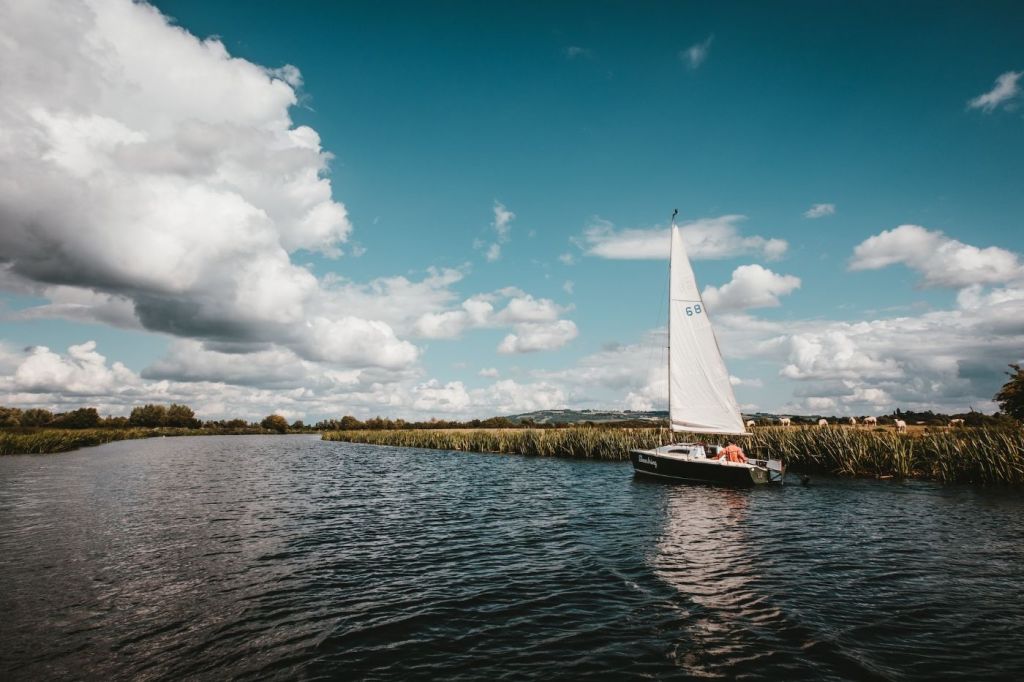
Types of Small Sailboats
Below is a table showing the different types of small sailboats and a short list of popular sailboats under each one:
Dinghy is a common type of small sailboat
A dinghy is a small sailboat that is typically used for racing or sailing in shallow water. It can be sailed by one or two people, and they are usually very lightweight and easy to handle.
They also cost less compared to other types of small sailboats. If you're curious as to how much a dinghy costs , here's an article for you.
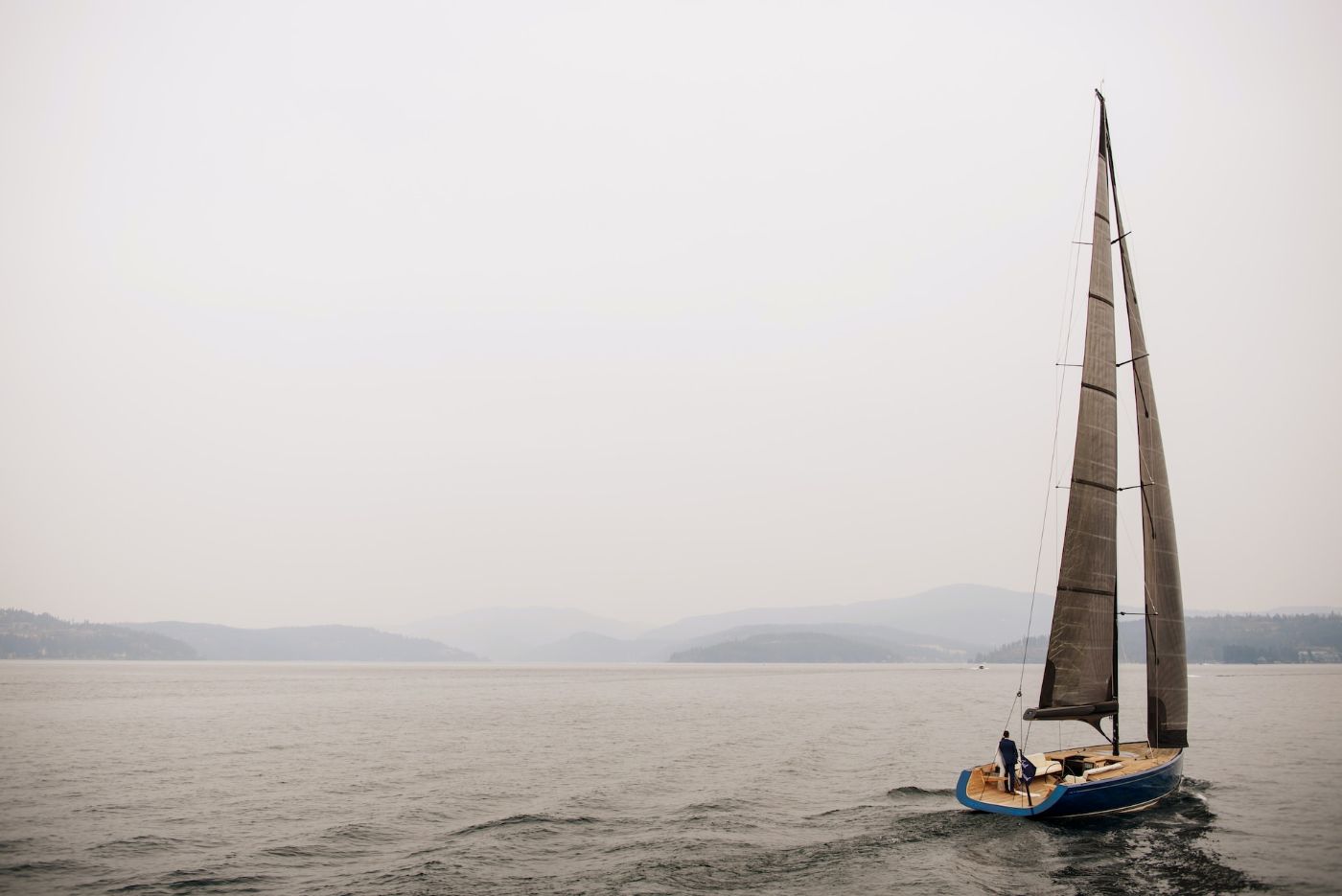
They are also very versatile and can be used for a variety of different sailing activities. Here are the pros and cons of choosing a dinghy:
- Pros: Lightweight and easy to transport, great for racing, maneuverable, good for learning basic sailing skills.
- Cons: Can capsize easily, limited space for passengers, not suitable for long distances or overnight trips.
To know which type of dinghy suits you best , you can read this article.
Daysailers are another popular small sailboat choice
Daysailers are slightly larger than dinghies and are designed for day sailing. They are usually between 16 and 20 feet in length and can be sailed by two or more people.
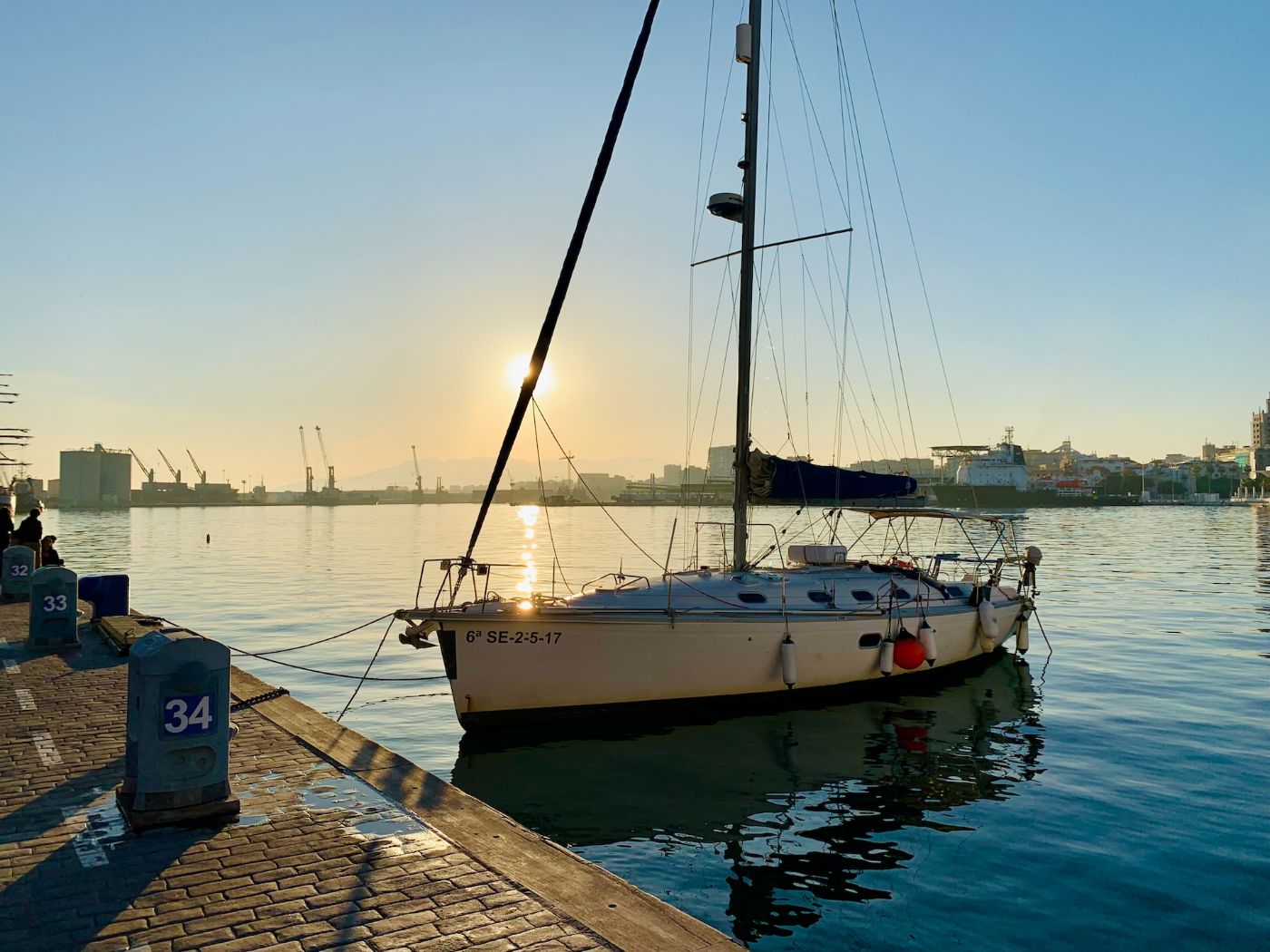
Daysailers are designed for comfort and ease of use, with features such as a small cabin or cockpit for shelter and storage. They are also often equipped with amenities such as a small galley or a portable toilet.
- Pros: More spacious than dinghies, can accommodate small groups, good for day trips and weekend outings, stable and easy to handle.
- Cons: Heavier and less maneuverable than dinghies, may require a trailer for transport, not suitable for long distances or overnight trips.
Small sloop is a classic and versatile small sailboat option
A sloop is a type of sailboat that has a single mast and a fore-and-aft rig. This means that the sails are set parallel to the centerline of the boat.
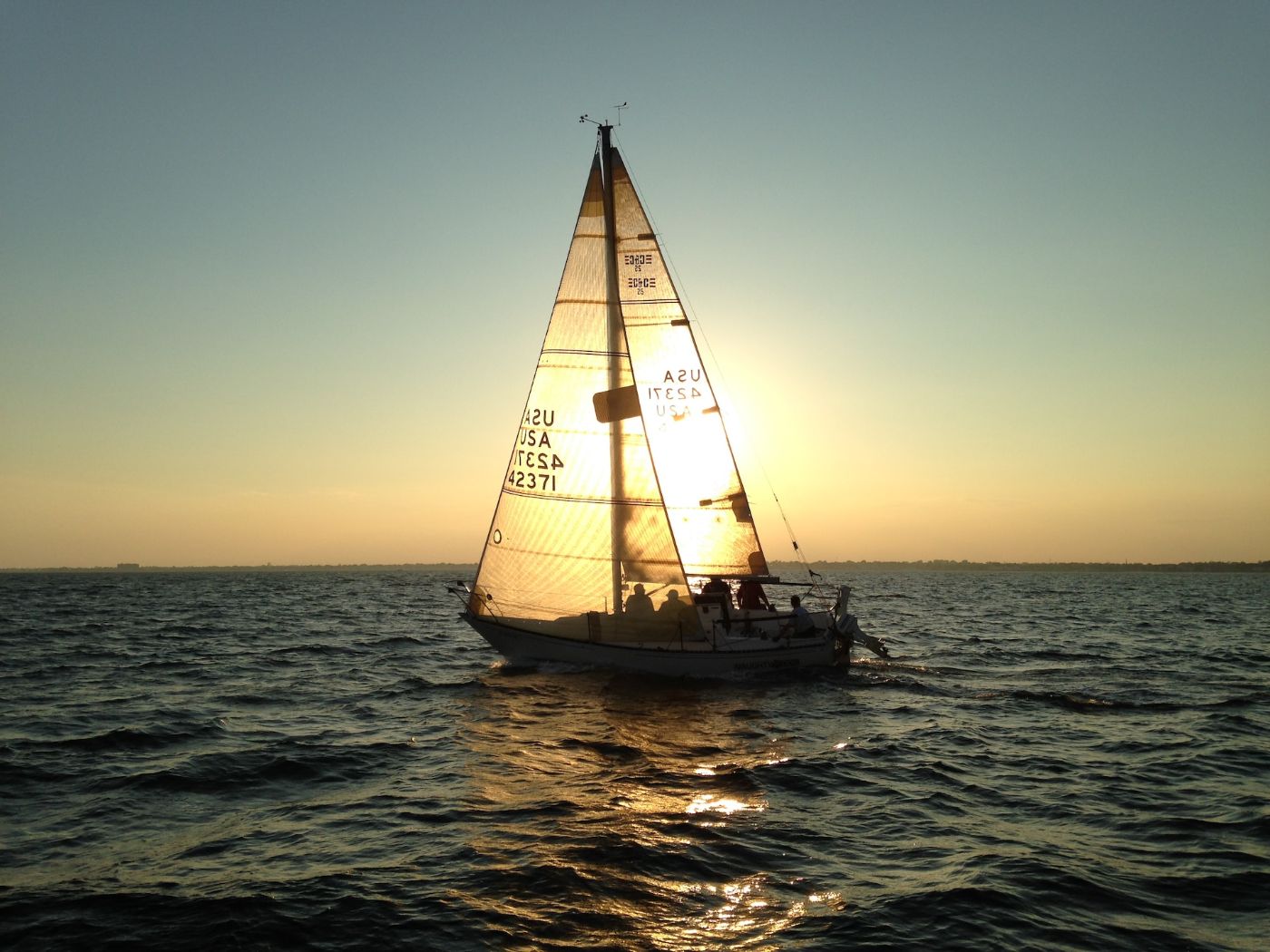
Sloops are one of the most popular types of sailboats because they are easy to handle and can be sailed by just one person. They are also very versatile and can be used for racing or cruising.
- Pros: More spacious and comfortable than dinghies or daysailers, can accommodate small groups, good for day trips and overnight trips, good for learning intermediate sailing skills.
- Cons: Heavier and more expensive than dinghies or daysailers, may require a larger vehicle or trailer for transport, may require more maintenance.
Small catamarans are a lightweight and stable small sailboat option
A catamaran is a type of sailboat that has two hulls instead of one. The hulls are connected by a trampoline, which provides a stable platform for sailing.
Catamarans are very fast and can be used for racing or cruising. They are also very spacious and can accommodate a lot of people.
- Pros: Fast and fun to sail, can accommodate small groups, good for day trips and weekend outings, stable and easy to handle.
- Cons: More expensive than dinghies or daysailers, may require a larger vehicle or trailer for transport, may require more maintenance, less comfortable than sloops for overnight trips.
If you want to know the costs of buying and owning a catamaran , either new or used, you might find this article helpful.
Small Sailboats for Different Skill Levels, Intended Use, And Budget
Below is a table showing how to choose a specific small sailboat model based on skill level, intended use, and budget:
Choosing the perfect small sailboat based on skill level
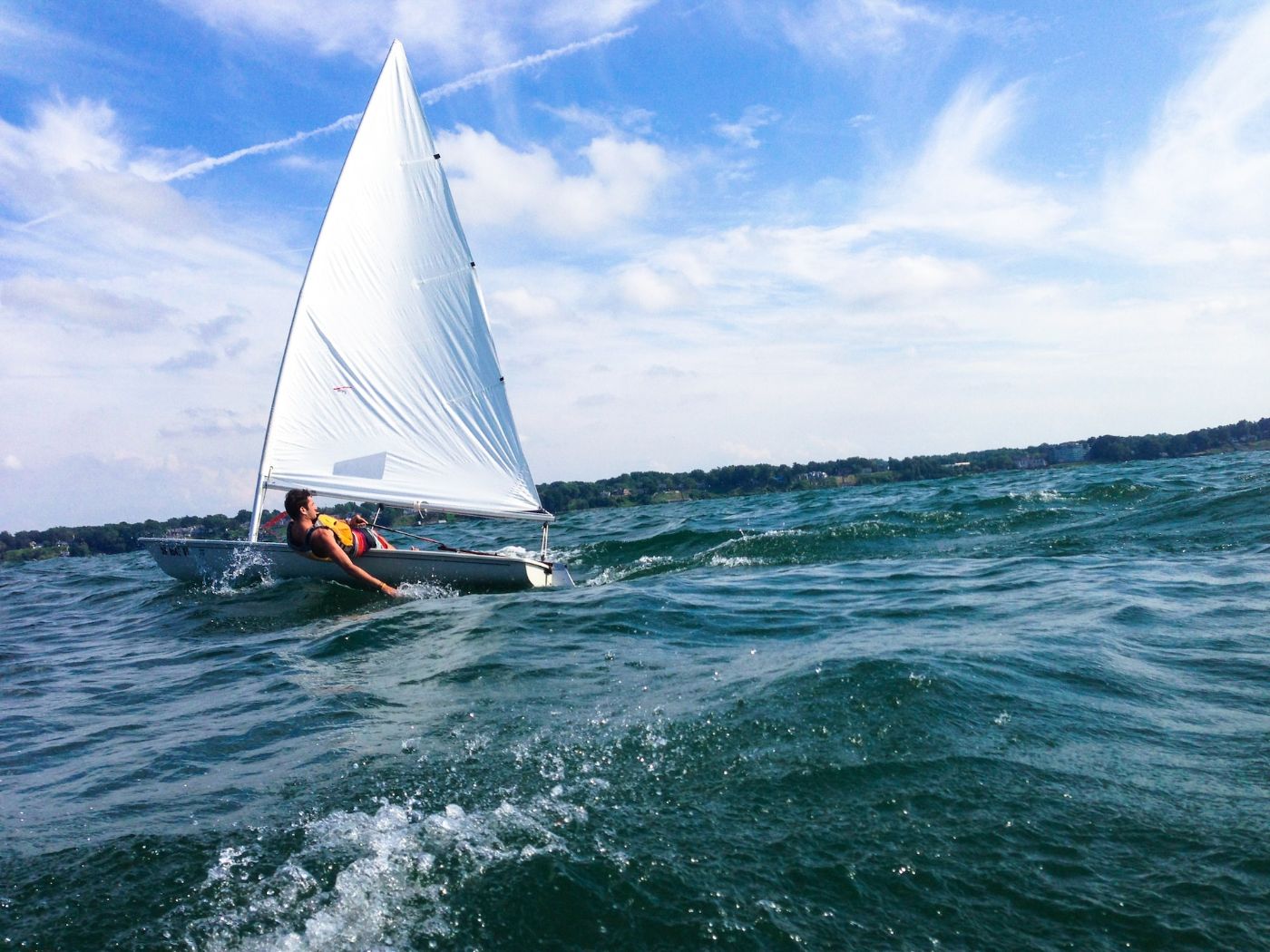
When choosing the perfect sailboat for you, try to choose a boat that matches your skill level so that you can enjoy sailing safely and comfortably.
Small sailboat for beginner sailors
If you are new to sailing, you may want to choose a small dinghy or daysailer that is easy to handle and control. Boats like the Sunfish or the Laser are popular choices for beginners, as they are lightweight and simple to rig.
These boats are also relatively forgiving, which means that they are less likely to capsize or cause injury if you make a mistake.
Small sailboat for intermediate sailors
If you have some sailing experience but are not yet an expert, you may want to consider a slightly larger boat that can handle more wind and waves.
Boats like the Catalina 22 or the Hunter 26 are popular choices for intermediate sailors, as they are larger and more stable than dinghies, but still relatively easy to handle. These boats also offer more amenities, such as a small cabin or a head, which can make them more comfortable for longer trips.
Small sailboat for advanced sailors
If you are an experienced sailor, you may want to choose a larger boat that can handle more challenging conditions. Boats like the J/105 or the J/120 are popular choices for advanced sailors, as they are designed for racing and cruising in open waters. These boats are more complex to rig and operate, but offer greater speed, stability, and control in high winds and waves.
Choosing the perfect small sailboat based on intended use
Are you planning to use the boat for day sailing, racing, or cruising? Different boats are designed for different purposes, so choose a boat that is well-suited for your intended use.
Small sailboat for day sailing
If you plan to use your boat for day sailing, you may want to consider a small dinghy or daysailer that is easy to launch and retrieve. Boats like the Hobie 16 or the Flying Scot are popular choices for day sailing, as they are fast and fun to sail in open waters. These boats are also relatively easy to rig and maintain, which makes them a great choice for recreational sailing.
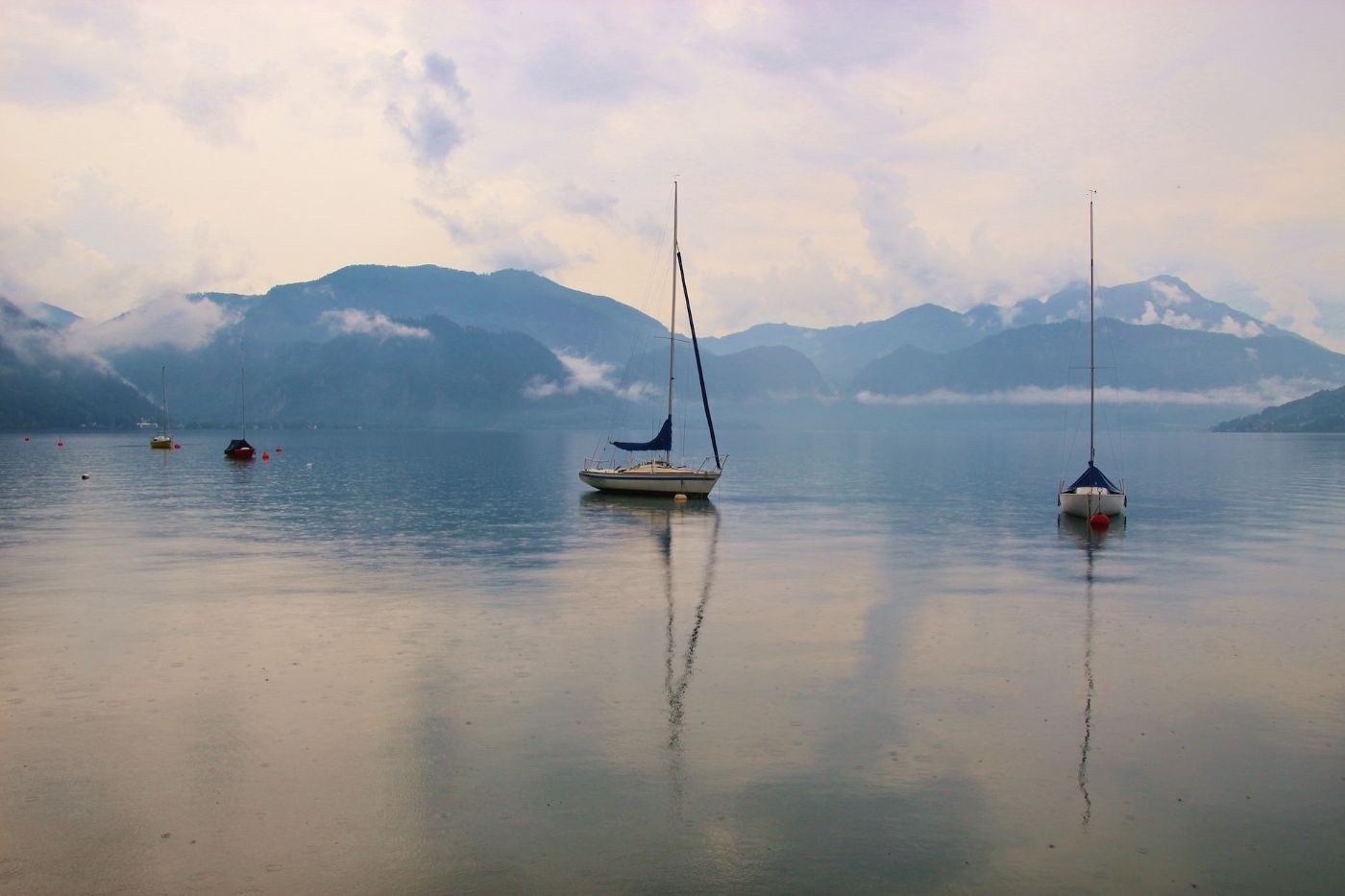
Small sailboat for racing
If you plan to use your boat for racing, you may want to consider a lightweight and fast boat that is designed for speed and agility. Boats like the J/70 or the Melges 24 are popular choices for racing, as they are designed to be fast and responsive in all conditions. These boats are also highly maneuverable, which makes them a great choice for competitive sailing.
Small sailboat for cruising
If you plan to use your boat for cruising, you may want to consider a boat that is more comfortable and has more amenities. Boats like the Catalina 27 or the Hunter 31 are popular choices for cruising, as they offer more space, storage, and comfort than smaller boats. These boats are also designed to be stable and seaworthy, which makes them a great choice for longer trips.
Choosing the perfect small sailboat depending on your budget
Consider choosing a boat that fits within your budget so that you don't overspend and end up with a boat that you can't afford to maintain or use. The price for used dinghies ranges from $1,000 to $5,000.
For used sailboats within 20–40 feet, the prices range from $5,000 to $50,000 . Keep in mind that there are also additional costs to consider, such as storage, maintenance, and repairs.
To get an idea of the pricing for used sailboats , you can use this article as a reference. Meanwhile, for the annual maintenance costs for sailboats , here's an article you can refer to.
Leave a comment
You may also like, how much does a dinghy cost (with 14 examples).
Once we bought our first real "overnight" boat, we had a wake-up call when we realized that we weren't done with the spending. If we wanted to go anywhere but a …

Types of Dinghies: How to Pick the Right One For You

Average Cost of Buying & Owning a Catamaran (With 4 Examples)
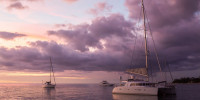
Cost of Catamaran vs. Monohull: Which is more expensive?
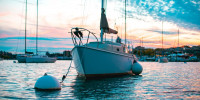
Average Sailboat Insurance Cost in 2023 (13 Examples)
Own your first boat within a year on any budget.
A sailboat doesn't have to be expensive if you know what you're doing. If you want to learn how to make your sailing dream reality within a year, leave your email and I'll send you free updates . I don't like spam - I will only send helpful content.
Ready to Own Your First Boat?
Just tell us the best email address to send your tips to:
- The Ultimate Guide to Small Sailboats: From Dinghies to Ocean Cruisers
Ahoy there, maritime enthusiasts! Are you tired of being a landlubber and ready to take on the open waters? Have you ever caught yourself daydreaming about sailing into the sunset but thought that owning a sailboat was only for the wealthy or the experienced? The good news is that small sailboats are here to prove you wrong. Easy to maneuver, affordable, and incredibly fun, these little vessels offer a world of possibilities for novices and veterans alike. So, why not set sail on this journey and explore what small sailboats have to offer?
Types of Small Sailboats
Dinghies are like the hatchbacks of the sailing world—compact, practical, and surprisingly versatile. Usually measuring under 15 feet, they are the go-to boats for sailing newbies to cut their teeth on. Why? Because they're affordable and easy to manage. Think of a dinghy as your first bicycle—sure, you'll fall a few times, but the lessons learned are invaluable.
If a dinghy is a hatchback, then a daysailer would be your sporty coupe—ideal for a fun day out but not really for a week-long journey. These boats are a bit larger, typically ranging from 15 to 25 feet, and can comfortably accommodate 4 to 6 people. They're perfect for sailing close to shore, having a picnic on the water, or enjoying a beautiful sunset.
Looking for something a bit unique? The catboat could be your feline friend on the water. These boats are known for their single mast and mainsail, making them easier to handle. They’re the sort of boat that likes to lounge lazily in shallow waters but can also pick up the pace when needed.
Features to Consider When Buying
Hull material.
The hull is like the foundation of a house—if it's not strong, everything else fails. Generally, you'll find hulls made of fiberglass, wood, or even aluminum. Each material has its pros and cons. For instance, fiberglass is durable and low-maintenance but can be expensive. Wood offers a classic look but requires more upkeep.
Would you prefer manual or automatic transmission in a car? Similarly, the rig type of your sailboat affects your sailing experience. You might opt for a simple sloop with one mast and two sails or maybe a cutter with an additional headsail for better balance. The choice is yours.
Length and Beam
Here's where size really matters. The length and beam (width) of your boat will significantly impact its stability, storage capacity, and how it handles in different water conditions. It's not always that smaller is easier to handle; sometimes, a slightly larger boat offers better stability and amenities.
Advantages of Small Sailboats
Affordability.
Let's face it—owning a boat isn't cheap. But small sailboats make the dream more accessible. Not only are the upfront costs generally lower, but ongoing maintenance expenses like docking fees, cleaning, and repairs are also more manageable. It's the difference between owning a high-end sports car and a reliable sedan—both can be fun, but one is undoubtedly easier on the wallet.
Maneuverability
Remember the first time you parallel parked a car? Now, imagine doing that with a 40-foot boat! Small sailboats shine when it comes to maneuverability. They're easier to steer, quicker to respond, and a breeze to dock, making them perfect for navigating through narrow channels or crowded marinas.
Low Maintenance
Less is more when it comes to boat maintenance. Smaller surface area means fewer places for dirt and grime to hide, making cleaning easier. Not to mention, smaller engines (if your boat has one) mean less complicated mechanical problems to solve. It's like owning a plant that only needs water once a week—low commitment, high reward.
Popular Small Sailboats
Remember the Volkswagen Beetle of yesteryears? Compact, easy to manage, and immensely popular—that's what Sunfish is to the world of small sailboats. Whether you want to race or just sail leisurely, this boat is a versatile choice that won't disappoint.
For those who crave a bit more adrenaline, the J/22 is like the sports bike of small sailboats. Known for its speed, agility, and performance, this boat is a favorite in racing circles. It's agile enough to make quick turns yet sturdy enough to handle a variety of sea conditions.
Catalina 22
If you're looking for the minivan of small sailboats—functional, family-friendly, and reliable—the Catalina 22 is for you. Ideal for weekend trips with the family, this boat offers a cabin for shelter, a cooking space, and even a small toilet. It's a floating home away from home.
Small Sailing Yachts for Sale
Where to buy.
Buying a boat can be like buying a car; there are various avenues available. You can go through dealerships, check out classified ads, or even explore online platforms like Boat Trader or YachtWorld. Just like you wouldn't buy a car without a test drive, make sure to do a sea trial before making a purchase.
Price Range
The cost of your new aquatic venture can vary widely depending on the size, brand, and features. You might find a used dinghy for as low as $1,000 or a top-of-the-line daysailer that costs over $20,000. Therefore, it's crucial to budget not just for the initial purchase but also for the ongoing costs like maintenance, insurance, and docking fees.
(To be continued...)
Read our top notch articles on topics such as sailing , sailing tips and destinations in our Magazine .
Small Bluewater Sailboats
Definition and features.
When it comes to small sailboats, not all are built for the big leagues, aka open-ocean sailing. However, some compact beauties are fully capable of taking on the mighty seas, and these are commonly referred to as "bluewater sailboats." These boats generally have reinforced hulls, deep keels for added stability, and more robust rigging systems. They also often come with advanced navigation and safety features like radar and autopilot systems.
If you're serious about open-ocean sailing but don't want a massive boat, brands like Nor'Sea and Pacific Seacraft have some excellent offerings. These boats might be small in size (often under 30 feet), but they are big on features and sturdiness, designed to withstand challenging sea conditions.
Boats for Cruising
Characteristics.
A cruiser is like a comfortable sedan equipped for a cross-country road trip. Similarly, cruising boats are designed for longer journeys and typically feature amenities like sleeping cabins, cooking facilities, and even bathrooms. However, small cruising sailboats make these comforts available in a compact form, ensuring you don't have to compromise on luxury while also enjoying the benefits of a small boat.
The market offers various models to suit different cruising styles. If you prefer a classic, vintage look, the Bristol series offers some wonderful choices. Those who want a more modern flair might gravitate towards Hunter or Beneteau models. No matter your preference, there's likely a small cruising sailboat that fits the bill.
Very Small Sailing Boats
What makes them unique.
We're talking about boats usually under 10 feet, often even as small as 6 or 7 feet. These are the "motorbikes" of the sailing world—quick, nimble, and perfect for a joyride, albeit on water. What they lack in amenities, they make up for in sheer fun and the ability to go places bigger boats can't.
Very small sailing boats are perfect for specific types of water activities. You can use them for fishing, exploring secluded inlets, or just enjoying a peaceful day on the water. They are also excellent for teaching kids the basics of sailing due to their simplicity and ease of handling.
Small Ocean Sailboats
Ocean-capable small boats.
Yes, you read that right—there are small sailboats designed for ocean sailing. Unlike their cousins confined to more tranquil waters, these boats have features that make them seaworthy. However, don't assume that any small boat can be taken on an ocean voyage. Specific design features are essential for this kind of challenging adventure.
Essential Features
So what makes a small sailboat ocean-worthy? For starters, a strong hull designed to take on challenging sea conditions. You'd also want a deep keel for stability, a robust rigging system to withstand high winds, and multiple fail-safes like backup navigation systems.
Small Ocean Cruisers
Adaptability.
Ocean cruisers in a small size offer the best of both worlds—they are versatile enough for both coastal cruising and open-ocean voyages. These boats are like your all-terrain vehicles, capable yet compact.
Pros and Cons
While adaptable, small ocean cruisers may lack some of the luxury or speed that larger yachts can offer. However, their versatility and ease of handling often make them a popular choice for those who like a variety of sailing experiences.
Small Cruising Sailboats
Ideal for beginners.
If you're a rookie in the world of sailing, a small cruising sailboat could be your best bet. These boats are typically easy to handle, straightforward to maintain, and offer enough amenities for short trips—making them an ideal starting point.
Popular Models
If you're new to cruising, a couple of models might catch your attention. The Compac 16, known for its easy handling and classic look, is often recommended for beginners. Another excellent option is the Catalina 18, which offers a bit more room without compromising ease of use.
Setting sail on a small sailboat opens up a world of opportunities—whether you're a seasoned sailor looking for a weekend thrill or a beginner aiming for a long-term commitment to the sea. Understanding the types, features, advantages, and options in the small sailboat market will help you make an educated choice. The sea is vast and welcoming, offering adventures and tranquility alike, and a small sailboat can be your perfect vessel for exploration.
So what are you waiting for ? Take a look at our range of charter boats and head to some of our favourite sailing destinations .
Faqs: more about small sailboats, what's the best small sailboat for beginners, can small sailboats be used for ocean sailing, how much does a small sailboat cost, what features should i consider when buying a small sailboat, do small sailboats have sleeping accommodations.

What Is a Small Sailboat? (A Comprehensive Guide)

Have you ever dreamed of owning and sailing your own sailboat? If so, a small sailboat could be the perfect option for you.
In this comprehensive guide, well discuss the different types of small sailboats, the benefits of owning one, and what to consider when shopping for one.
Well also provide step-by-step instructions on how to rig, launch, and sail a small sailboat, as well as how to maintain and care for it.
Finally, well provide some tips for beginners to help them get started.
So, if youre eager to get out on the open water in your own sailboat, read on!
Table of Contents
Short Answer
A small sailboat is a type of sailboat that is typically smaller than other sailboats and usually requires fewer crew members to operate.
It is typically used for leisure and recreational activities such as fishing, cruising, and racing.
Small sailboats are typically easier to maneuver and require less maintenance than larger sailboats.
Types of Small Sailboats
Small sailboats come in a variety of shapes and sizes, depending on the intended use. There are three main types of small sailboats to consider when selecting the right one for your needs: dinghies, keelboats, and catamarans. Dinghies are the most common type of small sailboat and are typically lightweight and easy to maneuver. They are usually 10-20 feet in length and powered by a single sail. Keelboats are larger than dinghies, typically between 20-30 feet in length, and have a keel to help them stay on course. They are powered by a variety of sail configurations, from a single sail to a complex rig with multiple sails. Lastly, catamarans are two-hulled vessels that are known for their stability and speed. They are typically between 20-30 feet in length and can be powered by a variety of sails, from a single sail to a complex rig with multiple sails. No matter what type of small sailboat you choose, they are all easy to maneuver and relatively inexpensive, making them a great choice for those looking to get out on the water and enjoy a relaxing day.
Benefits of Small Sailboats

Small sailboats offer a variety of benefits that make them a great option for those looking to enjoy a day out on the water.
These vessels are lightweight and easy to maneuver, making them the perfect choice for those looking to relax and enjoy the scenery.
They are also relatively inexpensive, so they can be an affordable option for those just starting out with sailing.
Additionally, these boats can be powered by a variety of sail configurations, from a single sail to a complex rig with multiple sails, giving sailors the ability to customize their boat to their individual needs.
In addition to the convenience and affordability of small sailboats, they also offer a unique experience that cant be matched by other types of boats.
With their lightweight hulls, they provide an exhilarating ride that is both exciting and relaxing at the same time.
This makes them a great option for those looking to explore different waterways without the worry of being overpowered by the wind or waves.
Additionally, the maneuverability of these boats allows them to explore areas that may be inaccessible to larger vessels.
Finally, small sailboats are ideal for those who want to learn the basics of sailing.
With their lightweight construction and ease of use, they make it easy for beginners to learn the ropes without becoming overwhelmed or frustrated.
As sailors become more comfortable in their boats, they can gradually add more sails and other features to customize their experience.
All in all, small sailboats are an excellent choice for those looking to explore the water and enjoy a day out on the open sea.
Considerations When Shopping for a Small Sailboat
When shopping for a small sailboat, it’s important to consider a few key factors.
First, you’ll want to think about the size of the sailboat you need.
Small sailboats typically range from 10 to 20 feet in length and come in a variety of designs and styles.
If you’re looking for a boat that’s easier to maneuver, you might want to look for one on the smaller side.
If you’re looking for something with more room and storage, you’ll want to look at larger boats.
Another important factor to consider when shopping for a small sailboat is the type of sail configuration you want.
Small sailboats typically use either a sloop or a cat rig configuration, with the sloop being the more common choice.
A sloop has one large sail that provides propulsion, while a cat rig has two or more sails that provide additional power and stability.
The type of sail configuration you choose will depend on your preferred sailing style and the type of sailing conditions you expect to encounter.
Finally, you’ll want to think about the type of materials used in the construction of the small sailboat you’re considering.
Small sailboats are typically made of either fiberglass or aluminum, both of which offer durability and strength.
Aluminum is more lightweight and less expensive, while fiberglass is more durable and more expensive.
You’ll want to choose the material that best fits your budget and sailing needs.
With these considerations in mind, you’ll be able to find the perfect small sailboat for your needs.
Whether you’re looking for a boat that’s easy to maneuver or one that can handle all types of sailing conditions, a small sailboat can be the perfect choice for your next outing.
How to Rig a Small Sailboat

Rigging a small sailboat is an important part of owning and sailing one.
A small sailboat’s rigging includes the sails, masts, booms, and other hardware and lines used to control the sails.
Setting up a boat’s rig properly can make a huge difference in its performance, safety, and comfort while sailing, so it’s important to understand how it works.
When rigging a small sailboat, the first step is to choose the right sails and mast.
Typically, most small sailboats use a sloop or cutter rig, which involves a single or double mast with one or two sails.
The size of the boat and the type of sailing you plan to do will determine which type of rig is best for your boat.
Next, you’ll need to attach the hardware to the boat.
This includes the mast step, cleats, sheaves, blocks, halyards, and other items that are necessary for sailing.
The hardware is typically bolted or riveted to the boat and must be installed correctly in order for the boat to sail safely and efficiently.
Once the hardware is installed, it’s time to attach the sails.
The sails can be attached to the mast using halyards and sheets, depending on the type of sails.
Small sailboats typically use a mainsail and a headsail, and the sails must be rigged correctly in order to provide the most efficient and safe sailing experience.
Finally, it’s important to make sure all the lines and hardware are properly tensioned and adjusted.
This will ensure that the boat is safe to sail and that the sails are able to provide the most power and control.
It’s a good idea to consult a professional rigger for advice and assistance in setting up the boat’s rig correctly.
Setting up a small sailboat’s rig correctly can be a complex process, but it’s essential for the safe and efficient operation of the boat.
By taking the time to research and install the correct hardware and sails, you can ensure that your boat is well-equipped for a safe and enjoyable sailing experience.
How to Launch and Sail a Small Sailboat
Launching and sailing a small sailboat may seem intimidating, but with proper instruction and practice, anyone can become a confident and successful sailor.
Before launching, it is essential to make sure that all safety equipment is on board and in good working condition.
This includes a life jacket, a bailer, flares, and a first aid kit.
Additionally, it is important to make sure the boat is equipped with the necessary rigging, including a mainsail, jib, and spinnaker, as well as the appropriate lines for controlling the sails.
Once the boat is ready to launch, it is important to pay attention to the current wind conditions.
These will dictate which side of the boat should be facing the wind for optimal sail performance.
Once the boat is in the water and the sails are up, the boat should be trimmed correctly for the most efficient and comfortable ride.
This involves adjusting the sails and the rudder to ensure that the boat is pointed in the direction you wish to travel.
In order to sail successfully, it is important to understand the principles of sailing, such as points of sail, heeling, and tacking.
Points of sail refer to the direction that the boat is moving relative to the wind direction.
Heeling is the term for when the boat leans to one side due to the force of the wind.
Tacking is the process of turning the boat in the opposite direction from the wind in order to sail in a different direction.
Finally, it is important to know when and how to reef the sails.
Reefing is the process of reducing the amount of sail area exposed to the wind in order to reduce the amount of heeling and increase the stability of the boat.
Knowing when and how to reef the sails will help to ensure a safe and comfortable sailing experience.
Now that you know the basics of launching and sailing a small sailboat, it’s time to get out on the water and enjoy the wind in your sails! With proper instruction and practice, anyone can become a confident and successful sailor and enjoy the freedom of the open waters.
Maintenance and Care of a Small Sailboat

Maintaining and caring for a small sailboat is essential to ensuring a safe and enjoyable experience on the water.
To keep your boat in top condition, it is important to regularly inspect and maintain the hull, sails, rigging, and other components.
This includes inspecting the hull for cracks or abnormalities, making sure the sails and rigging are in good condition, and ensuring that the boat is properly balanced and equipped with the necessary safety equipment.
Additionally, it is important to keep the boat clean and free of debris or fouling, as this can cause problems with the boats performance.
In addition to regular maintenance, it is also important to store the boat properly when not in use to ensure that it stays in good condition.
This includes covering the boat with a tarp or other suitable cover, keeping the rigging and other components indoors or in a cool, dry place, and making sure the boat is securely moored when not in use.
Taking the time to properly care for and maintain your small sailboat will ensure that it will provide years of enjoyable sailing experiences.
Tips for Beginners
For those just starting out with small sailboats, there are a few tips to keep in mind to ensure a safe and enjoyable experience.
First, be sure to take a sailing course before attempting to take your boat out on the water.
This will ensure that you have the knowledge and skills necessary to safely handle the vessel.
Additionally, it is important to wear a lifejacket at all times while on the water, as this can save your life should anything go wrong.
Additionally, it is important to inspect your boat before every outing, checking for any damage or wear and tear that could affect its performance.
Additionally, be sure to check the forecast and be aware of any weather patterns that could affect your sailing experience.
Lastly, be sure to bring along plenty of food and water, as well as any necessary safety and navigation equipment.
With these tips in mind, you’ll be sure to have a fun and safe sailing experience.
Final Thoughts
For those who want to get out on the water and enjoy a relaxing day of sailing, a small sailboat is the perfect choice.
With their lightweight, easy to maneuver design, these vessels offer a variety of sail configurations to suit a range of sailing abilities.
From considering the type of boat to learning how to rig, launch, and sail it, this comprehensive guide has covered all the basics of small sailboat ownership.
Now that you know the ins and outs of small sailboat ownership, it’s time to get out there and explore the open water!
James Frami
At the age of 15, he and four other friends from his neighborhood constructed their first boat. He has been sailing for almost 30 years and has a wealth of knowledge that he wants to share with others.
Recent Posts
Does Your Boat License Expire? Here's What You Need to Know
Are you a boat owner looking to stay up-to-date on your license requirements? If so, youve come to the right place! In this article, well cover everything you need to know about boat license...
How to Put Skins on Your Boat in Sea of Thieves? (Complete Guide)
There is a unique sense of pride and accomplishment when you show off a boat you customized to your exact specifications. With Sea of Thieves, you can customize your boat to make it look like your...
- BOAT OF THE YEAR
- Newsletters
- Sailboat Reviews
- Boating Safety
- Sailing Totem
- Charter Resources
- Destinations
- Galley Recipes
- Living Aboard
- Sails and Rigging
- Maintenance
20 Best Small Sailboats for the Weekender
- By Mark Pillsbury
- Updated: August 4, 2021
In order to go cruising, most of us require a sailboat with a head, a galley, and bunks. The boat, likely a 30-footer and more often a 40-footer, will have electronics for navigation and entertainment, refrigeration if the trip is longer than a coastal hop, an engine for light wind, and, depending on our appetites for food and fun, perhaps a genset to power our toys and appliances.
To go sailing , however, all we really need is a hull, mast, rudder, and sail. To experience the pure joy of sheeting in and scooting off across a lake, bay, or even the open ocean, there’s nothing better than a small sailboat – we’re talking sailboats under 25 feet. You can literally reach out and touch the water as it flows past. You instantly feel every puff of breeze and sense every change in trim.
Some of the boats in this list are new designs, others are time-tested models from small sailboat manufacturers, but every one is easy to rig, simple to sail, and looks like a whole lot of fun either for a solo outing on a breezy afternoon or to keep family and friends entertained throughout your entire sailing season. This list is made up of all types of sailboats , and if you’re looking for a list of some of the best small sailboats for beginners, you’ll find exactly that here.
Any one of these popular boats could be labeled as a trailerable sailboat, daysailer, or even a weekender sailboat. And while most would be labeled as a one or two person sailboat, some could comfortably fit three or even four people.
Marblehead 22 Daysailer
If you have an eye for elegant lines and your heart goes pitter-patter over just the right amount of overhang beneath a counter transom, the Marblehead 22 daysailer, designed by Doug Zurn and built by Samoset Boatworks in Boothbay, Maine, will definitely raise your pulse. Traditional-looking above the waterline and modern beneath, the cold-molded hull sports a deep bulb keel and a Hall Spars carbon-fiber mast with a wishbone rig and square-top main. The 11-foot-9-inch cockpit can seat a crowd, and a small cuddy forward will let you stow your friends’ gear for the day. samosetboatworks.com
Catalina 22 Sport
Many a harbor plays host to an active fleet of Catalina 22s, one of the most popular small sailboats over the years, given its basic amenities and retractable keel, which allows it to be easily trailered. Recently, the company introduced the Catalina 22 Sport, an updated design that can compete with the older 22s. The boat features a retractable lead keel; a cabin that can sleep four, with a forward hatch for ventilation; and a fractional rig with a mainsail and a roller-furling jib. Lifelines, a swim ladder, and an engine are options, as are cloth cushions; vinyl cushions are standard. The large cockpit will seat a crowd or let a mom-and-pop crew stretch out and enjoy their sail. It’s clear why the Catalina 22 is one of the best sailboats under 25 feet. catalinayachts.com
With its large, open-transom cockpit and sloop rig, the Hunter 22 makes a comfortable daysailer for family and friends. But with its cuddy cabin, twin bunks, optional electrical system, opening screened ports, and portable toilet, a parent and child or a couple could comfortably slip away for an overnight or weekend. Add in the optional performance package, which includes an asymmetric spinnaker, a pole, and a mainsheet traveler, and you could be off to the races. The boat features a laminated fiberglass hull and deck, molded-in nonskid, and a hydraulic lifting centerboard. Mount a small outboard on the stern bracket, and you’re set to go. marlow-hunter.com
Not sure whether you want to race, cruise or just go out for an afternoon sail? Since 1958, sailors have been having a ball aboard the Uffa Fox/George O’Day-designed Daysailer. Fox, who in the 1950s was on the cutting edge of planning-dinghy design, collaborated with Fall River, Massachusetts boatbuilder O’Day Corp. to build the 16-foot Daysailer, a boat that features a slippery hull and a small cuddy cabin that covers the boat roughly from the mast forward. Thousands of Daysailers were built by various builders, and they can be found used for quite affordable prices. There are active racing fleets around the US, and new Daysailers are still in production today, built by Cape Cod Ship Building. capecodshipbuilding.com
BayRaider from Swallow Boats
Easy to rig and trailer, the BayRaider from England’s Swallow Yachts is a relative newcomer to the small-boat market in the United States. Nearly all of its 19 feet 9 inches is open cockpit, though a spray hood can be added to keep the forward sections dry. The BayRaider is ketch-rigged with a gunter-style mainmast. The topmast and mizzen are both carbon-fiber, which is an option for the mainmast as well. The BayRaider can be sailed with a dry hull in lighter conditions or with 300 pounds of water ballast to increase its stability. With the centerboard and hinged rudder raised, the boat can maneuver in even the thinnest water.
$28,900, (904) 234-8779, swallowyachts.com
Big fun can come in small packages, especially if your vessel of choice happens to be the 12 ½-foot Beetle Cat. Designed by John Beetle and first built in 1921, the wooden shallow draft sailboat is still in production today in Wareham, Massachusetts at the Beetle Boat Shop. With a draft of just 2 feet, the boat is well-suited for shallow bays, but equally at home in open coastal waters. The single gaff-rigged sail provides plenty of power in light air and can be quickly reefed down to handle a blow. In a word, sailing a Beetle Cat is fun. beetlecat.com
West Wight Potter P 19
With berths for four and a workable galley featuring a cooler, a sink, and a stove, West Wight Potter has packed a lot into its 19-foot-long P 19. First launched in 1971, this is a line of boats that’s attracted a true following among trailer-sailors. The P 19′s fully retractable keel means that you can pull up just about anywhere and go exploring. Closed-cell foam fore and aft makes the boat unsinkable, and thanks to its hard chine, the boat is reportedly quite stable under way. westwightpotter.com
NorseBoat 17.5
Designed for rowing and sailing (a motor mount is optional), the Canadian-built NorseBoat 17.5—one of which was spotted by a CW editor making its way through the Northwest Passage with a two-man crew—features an open cockpit, a carbon-fiber mast, and a curved-gaff rig, with an optional furling headsail set on a sprit. The lapstrake hull is fiberglass; the interior is ply and epoxy. The boat comes standard with two rowing stations and one set of 9-foot oars. The boat is designed with positive flotation and offers good load-carrying capacity, which you could put to use if you added the available canvas work and camping tent. NorseBoats offers a smaller sibling, the 12.5, as well; both are available in kit form.
$19,000, (902) 659-2790, norseboat.com
Montgomery 17
Billed as a trailerable pocket cruiser, the Montgomery 17 is a stout-looking sloop designed by Lyle Hess and built out of fiberglass in Ontario, California, by Montgomery Boats. With a keel and centerboard, the boat draws just under 2 feet with the board up and can be easily beached when you’re gunkholing. In the cuddy cabin you’ll find sitting headroom, a pair of bunks, a portable toilet, optional shore and DC power, and an impressive amount of storage space. The deck-stepped mast can be easily raised using a four-part tackle. The builder reports taking his own boat on trips across the Golfo de California and on visits to California’s coastal islands. Montgomery makes 15-foot and 23-foot models, as well. If you’re in search of a small sailboat with a cabin, the Montgomery 17 has to be on your wish list.
With long overhangs and shiny brightwork, the CW Hood 32 is on the larger end of the daysailer spectrum. Designers Chris Hood and Ben Stoddard made a conscious decision to forego a cabin and head in favor of an open cockpit big enough to bring 4 or 5 friends or family out for an afternoon on the water. The CW Hood 32 is sleek and graceful through the water and quick enough to do some racing, but keeps things simple with a self-tacking jib and controls that can be lead back to a single-handed skipper. A top-furling asymmetrical, electric sail drive and Torqeedo outboard are all optional. The CW Hood 32 makes for a great small family sailboat. cwhoodyachts.com
Sun Cat from Com-Pac
Shallow U.S. East Coast bays and rock-strewn coasts have long been graced by cat boats, whose large, gaff-rigged mainsails proved simple and powerful both on the wind and, better yet, when reaching and running. The 17-foot-4-inch Sun Cat, built by Com-Pac Yachts, updates the classic wooden cat with its fiberglass hull and deck and the easy-to-step Mastender Rigging System, which incorporates a hinged tabernacle to make stepping the mast a one-person job. If you want a personal sailboat ideal for solo sailing, the Sun Can is a great choice. Belowdecks, the twin 6-foot-5-inch berths and many other features and amenities make this cat a willing weekender.
$19,800, (727) 443-4408, com-pacyachts.com
Catalina 16.5
The Catalina 16.5 sits right in the middle of Catalina Yachts’ line of small sailboats, which range from the 12.5 to the 22 Capri and Sport, and it comes in both an easy-to-trailer centerboard model and a shoal-draft fixed-keel configuration. With the fiberglass board up, the 17-foot-2-inch boat draws just 5 inches of water; with the board down, the 4-foot-5-inch draft suggests good windward performance. Hull and deck are hand-laminated fiberglass. The roomy cockpit is self-bailing, and the bow harbors a good-sized storage area with a waterproof hatch. catalinayachts.com
No roundup of best small sailboats (trailerable and fun too) would be complete without a mention of the venerable Hobie 16, which made its debut in Southern California way back in 1969. The company has introduced many other multihulls since, but more than 100,000 of the 16s have been launched, a remarkable figure. The Hobie’s asymmetric fiberglass-and-foam hulls eliminate the need for daggerboards, and with its kick-up rudders, the 16 can be sailed right up to the beach. Its large trampoline offers lots of space to move about or a good place to plant one’s feet when hanging off the double trapezes with a hull flying. The boat comes with a main and a jib; a spinnaker, douse kit, trailer, and beach dolly are optional features. hobiecat.com
Novice sailors or old salts looking for simplicity could both enjoy sailing the Hunter 15. With a fiberglass hull and deck and foam flotation, the boat is sturdily built. The ample freeboard and wide beam provide stability under way, and the heavy-duty rubrail and kick-up rudder mean that you won’t have to worry when the dock looms or the going grows shallow. Both the 15 and its slightly larger 18-foot sibling come standard with roller-furling jibs.
$6,900/$9,500 (boat-show prices for the 15 and 18 includes trailers), (386) 462-3077, marlow-hunter.com
Super Snark
Under various owners, the Snark brand of sailboats, now built by Meyers Boat Co., has been around since the early 1970s. The Super Snark, at 11 feet, is a simple, easily car-topped daysailer that’s fit out with a lateen rig and sail. Billed as unsinkable, the five boats in the company’s line are built with E.P.S. foam, with the external hull and deck vacuum-formed to the core using an A.B.S. polymer. The Super Snark weighs in at 50 pounds, and with a payload capacity of 310 pounds, the boat can carry two.
$970, (800) 247-6275, meyersboat.com
Norseboat 21.5
Built in Canada, the NorseBoat 21.5 is a rugged looking craft that comes in a couple of configurations: one with an open cockpit and small doghouse, and another with a smaller cockpit and cabin that houses a double berth for two adults and optional quarter berths for the kids. Both carry NorseBoat’s distinctive looking carbon fiber gaff-rigged mast with main and jib (a sprit-set drifter is optional), and come with a ballasted stub keel and centerboard. Because of its lightweight design, the boat can be rowed and is easily trailered.
$36,000 (starting), 902-659-2790, norseboat.com
Flying Scot
Talk about time-tested, the 19-foot Flying Scot has been in production since 1957 and remains a popular design today. Sloop rigged, with a conventional spinnaker for downwind work, the boat is an easily sailed family boat as well as a competitive racer, with over 130 racing fleets across the U.S. Its roomy cockpit can seat six to eight, though the boat is often sailed by a pair or solo. Hull and deck are a fiberglass and balsa core sandwich. With the centerboard up, the boat draws only eight inches. Though intended to be a daysailer, owners have rigged boom tents and berths for overnight trips, and one adventurous Scot sailor cruised his along inland waterways from Philadelphia to New Orleans.
Known primarily for its line of racing dinghys, RS Sailing also builds the 16-foot, 4-inch Venture, which it describes as a cruising and training dinghy. The Venture features a large, self-draining cockpit that will accommodate a family or pack of kids. A furling jib and mainsail with slab reefing come standard with the boat; a gennaker and trapeze kit are options, as is an outboard motor mount and transom swim ladder. The deck and hull are laid up in a fiberglass and Coremat sandwich. The Venture’s designed to be both a good performer under sail, but also stable, making it a good boat for those learning the sport.
$14,900, 203-259-7808, rssailing.com
Topper makes a range of mono- and multihull rotomolded boats, but the model that caught one editor’s eye at Strictly Sail Chicago was the Topaz Taz. At 9 feet, 8 inches LOA and weighing in at 88 pounds, the Taz is not going to take the whole crowd out for the day. But, with the optional mainsail and jib package (main alone is for a single child), the Taz can carry two or three kids or an adult and one child, and would make a fun escape pod when tied behind the big boat and towed to some scenic harbor. The hull features Topper’s Trilam construction, a plastic and foam sandwich that creates a boat that’s stiff, light, and durable, and shouldn’t mind being dragged up on the beach when it’s time for a break.
$2,900 (includes main and jib), 410-286-1960, topazsailboats.com
WindRider WRTango
WRTango, a fast, sturdy, 10-foot trimaran that’s easy to sail, is the newest portable craft from WindRider International. It joins a line that includes the WR16 and WR17 trimarans. The Tango features forward-facing seating, foot-pedal steering, and a low center of gravity that mimics the sensation of sitting in a kayak. It weighs 125 pounds (including the outriggers and carbon-fiber mast), is extremely stable, and has single-sheet sail control. The six-inch draft and kick-up rudder make it great for beaching, while the hull and outriggers are made of rotomolded polyethylene, so it can withstand running into docks and being dragged over rocks.
$3,000, 612-338-2170, windrider.com
- More: 21 - 30 ft , Boat Gallery , day sailing , dinghy , Sailboat Reviews , Sailboats , under 20 ft
- More Sailboats
A Gem in New England
Thinking of a shift to power, tradewinds debuts 59-foot twe6 smart electric yacht, sailboat preview: dufour 44, good bread for good health, center of effort, the halfway point: sailing to bermuda.
- Digital Edition
- Customer Service
- Privacy Policy
- Email Newsletters
- Cruising World
- Sailing World
- Salt Water Sportsman
- Sport Fishing
- Wakeboarding

Small Sailboat Sizes: A Complete Guide

Last Updated by
Daniel Wade
October 30, 2022
Key Takeaways
- Small sailboats are easy to sail, rig, and are affordable
- They are usually under 20 feet to be considered small
- Might not fit a particular sailing goal
There are plenty of small sailboat sizes to accommodate any sailing experience. But what kinds of small sailboats are there?
Small sailboats are generally under 20 feet in length, come in a variety of designs, and have different hulls. These include monohulls, catamarans, and trimarans. As long as they have a mast, rudder, sail, and are under 20 feet, it is considered a small sailboat.
According to experienced sailors that use a smaller boat, it is best to have one that is easy to handle and accommodates their sailing goals. When searching for the best small sailboat, it will likely differ from one person to the next.
Table of contents
23 Small Sailboats to Compare
When looking at different types of small sailboats, it is important to see how they are designed. Depending on the sailing goals a person has will ultimately affect how they intend to sail.
If I have a Hobie catamaran, I am likely going to use it for recreational purposes like coastal cruising instead of racing. For shallow drafts, I would need something that can handle entering that territory and not risk damaging a keel on some monohulls.
Marblehead Daysailer
The Marblehead 22 daysailer is a traditional looking monohull perfect for everything related to small sailboats. Even though it is compact, there is enough room for guests on board.
It has almost a 12 foot cockpit to seat several people, along with a stowaway cuddy in the front to put some gear into. With its bulb keel, however, I would not take it into shallow waters.
A Laser is a great small sailboat that is commonly raced. In fact, they have been used in the Olympics every year since 1996.
Laser’s have a tendency to capsize if mishandled by inexperienced sailors in rough conditions, but are good to learn how to sail. I would recommend taking them out on lighter days and calmer conditions.
Catalina Sport
The Catalina 22 Sport has earned the reputation for the best small sailboat for years. It has simple amenities for different sailing goals, but also has a retractable keel to allow for shoal draft exploration.
For a boat this size, it can sleep four people and has a swim ladder in the back. Sailors that are used to simple designs will be happy that it has a roller furling jib, a fractional rig, and a mainsail. For a boat that is under 25 feet, it is arguably the epitome of small sailboats.
Cape Cod Daysailer
The Daysailer by Cape Cod was a first of its kind back in the 1950’s. It could travel however a sailor saw fit, with capabilities of racing, cruising, or simple pleasure.
Roughly a thousand were built by various shipyards, but Cape Cod still continues to produce them. For a 16 foot sailboat, it packs a punch with an affordable price and enough room for a few people.
The BayRaider from Swallow Yachts is another great example of a small sailboat that is easy to navigate and to put on a trailer for transport. What I love about it is that just about all of the 20 feet of the boat is an open cockpit.
If I were consistently using it in rougher waters, I would recommend adding a spray hood to help keep sections of the boat dry. In addition, I would look for the option to add stability with 300 pounds of water ballast.
For those that enjoy a solo ride, the Beetle Cat is one to consider. This boat has a draft of two feet and is roughly 12 feet long, which makes it perfect for coastal cruising or much tighter spaces.
With its single gaff-rigged sail, it offers tons of power even with lighter air. It is also nice to use when the conditions become rough and it is easy to reef down.
West Wight Potter
The West Wight Potter has a particular model, the P19, that is on many sailors’ lists of great small sailboats. A lot of sailors prefer this boat due to a variety of features for its size.
At just under 20 feet, it has four berths, galley, sink, stove, and even a cooler. This boat also has closed-cell foam on the fore and aft, making it virtually unsinkable.
The Norseboat 17.5 is the perfect sailboat in mind when it comes to rowing and sailing. Whether it has one or two people, there is plenty of room to sail comfortably.
While it is not the best boat to probably have in rough conditions, I would likely use this to find coastal areas with good camping spots. With its excellent load capacity, there are plenty of opportunities to bring all kinds of gear without fear of weighing the boat down.
Even though the Montgomery 17 is advertised as a trailerable pocket cruiser, it packs a punch for a smaller sloop rig. It even comes with a centerboard keel that can be retracted to make the boat draft just two feet. This is great for those that want to cruise along the coast or beach it and go exploring.
The cuddy cabin has plenty of headroom and two bunks for guests. There are other models that Montgomery offers such as the 15 and 23, but the 17 is arguably the most attractive for tighter spaces navigating and the best bang for buck scenario.
The CW Hood 32 is somewhat misleading for a small sailboat since it is roughly 32 feet in length. However, sailors will only use about half of the boat in the cockpit with seating and navigating.
This boat is specifically designed for day sailing in mind, with nothing on board to distract anyone from sailing. It is a perfect sailboat for a family without being too large to handle.
The 17 foot and half Sun Cat from Com-Pac Yachts is a great looking small sailboat. With its gaff-rigged mainsail, it powers easily with light conditions.
It can be for solo sailing or a small group that wants to share twin six foot berths. It has a handful of amenities to make this a great boat to have on the weekend or small trips.
There was a time that the Sunfish was the most popular small sailboat in existence. But price and competition flooded the market and other top names are pushing them away from the top.
However, this might be a good opportunity to find one at a discount. The Sunfish is excellent for those wanting to day sail or learn how to sail, meaning anyone can enjoy time on the water with this simple 14 foot setup.
The Catalina 16.5 is considered the middle child between its models of 12.5 and the 22. It can come in two different models, one with a centerboard or another with a shoal draft fixed keel.
At slightly over 17 feet, the centerboard model can draft as low as five inches on the water or a little over four feet with the board down. It also features plenty of room in the cockpit and a waterproof hatch for storage.
For those that want a taste of stability from a catamaran and a small sailboat that is easy to trailer, a Hobie 16 is the right boat. Since 1969, there have been plenty of models from that brand but over 100,000 have been made with the 16 alone.
All catamarans can be beached, but some might need some attention beforehand to ensure so. For example, this one will need rudders kicked up before beaching.
The Hunter 15 is the pinnacle of simplicity and functionality. This boat, whether an experienced sailor or newbie is navigating, is one of the best boats without having to think too much about while underway.
With its kick up rudder, any sailor can relax as they enter shoal drafts. This 15 footer is great for day sailing since there are not any special features on board.
Super Snark
The Super Snark has been around since 1970 and has proven to be successful at just 11 feet in length. It is easy to transport, either on a trailer or on top of a vehicle.
The boat weighs just 50 pounds and has a payload capacity of about 310 pounds. For those that want a small unsinkable boat built for two people, it is hard to pass up a Super Snark.
Flying Scot
The Flying Scot is another great small sailboat that is just under 20 feet in length. Not much has changed since it was produced in 1957 with its sloop rig and spinnaker.
Even though it is a good racer for just one or two people, it can comfortably be used as a family boat for up to eight people. It also has a centerboard keel that can be retracted to make it have an eight inch draft.
RS Sailing typically builds racing dinghies, but the Venture model is a 16 footer that is great for those newer to sailing. This boat is commonly used in training classes across the U.S.
The cockpit can comfortably hold a handful of people or a group of smaller kids. It also features an outboard motor mount and a swim ladder in case anyone wants to take a swim.
The RS Sailing brand needs one more mention due to the amount of small sailboats they put out. The RS Aero, for example, is an award winning racing dinghy just shy of 14 feet that has been used in competitions all over the world.
It is not a boat that can be easily learned for a newbie to reach top speeds, but experienced racers love the performance it offers. It only seats one, but it is perfect for those that have sailing experience, whether they are young or old.
Topaz makes a variety of smaller sailboats, but the one that is most popular is the Taz. At just under 10 feet in length, it is one of the smaller sailboats out there that can accommodate an adult and maybe a small child.
This could also be used for larger boats that need a dinghy to make it to shore. For the price point, it will be difficult to ignore for a compelling dinghy.
The WRTango by WindRider is a perfect trimaran at 10 feet that is easy to sail and to transport. It is the smallest edition of trimarans offered by this brand, just behind the WR 16 and 17.
Since it has forward facing seating, steering with a foot pedal, and a lower center of gravity, sailors will feel like they are sitting in a kayak. It has a six inch draft, a single sail, and heavy duty outriggers that are designed to take a beating.
Minicat has a special line of inflatable catamarans available in various sizes. These come equipped with a multi-piece mast and even a trampoline, along with the inflatable hulls of course.
It is arguably the easiest small sailboat to travel with, as it can be put away in one or two bags for transport. As for sailing, it rivals the speeds and handle of other popular small catamarans.
Vancouver 28
The Vancouver 28 is outside the range of what would be considered a dinghy, but it still offers a lot of value for being a smaller bluewater sailboat. At 28 feet, there is a little something for everyone.
This boat is considered a pocket cruiser that can essentially go anywhere. For those that are trying to downsize from other larger sailboats, they should strongly consider a change with the Vancouver 28.
Pros and Cons to Small Sailboats
Small sailboats have become more popular over the last few decades. Smaller bluewater sailboats have a lot to like, but also present some disadvantages that might not fit into a sailor’s category to sail.
It is important to figure out what sailing goals a sailor wants to take part in. Whether it is cruising, weekend sailing, or day sailing, small sailboats are potentially a good fit.
There are a handful of pros to look at for small sailboats. The key is to find one that fits specific to a sailing goal, such as racing or cruising.
It is easy to see why small sailboats are common, especially since they cost much less than larger ones. They are even less expensive models if a sailor can find a used one.
Depending on how long a boat is will determine how much it costs to build. It is easier and costs less to make repairs on smaller boats since the damaged areas are smaller as well. So finding a small, yet functional sailboat will be the most cost effective.
Simpler Systems
Small sailboats are easier to maintain and have a lot less issues than larger boats. This is simply because they have a lot less to offer, such as a watermaker or an electric anchor windlass.
Some are just bare bones when it comes to sailing, while others have galleys or berths. Depending on the model and brand will determine how easy it is to maintain.
Easy to Sail
Inexperienced sailors often gravitate to smaller sailors simply because they are easier to sail. Imagine the difference between raising a sail between an 18 footer and a 48 footer, or even the difference between one or a few sails.
These boats are also meant for solo sailing or for smaller groups, making it easier to handle functions on board. These are also used in training schools that teach how to sail. There is also less stress on the boat in general, making it easier to maintain.
Easy to Rig
Whether a sailor wants to put a small sailboat on a trailer or the top of their car, no one can deny how convenient it is to move around. No special tricks are needed for these types of boats, as they are simple to put up once they are done being used.
When looking at the inflatable catamaran for example, it is one of the easiest to set up and put away. Larger boats require to be parked at a dock or will be more difficult to pull out of the water.
Easy to Find Parts
Every sailboat will need something replaced or fixed at some point. For small sailboats, it will be easier to find parts or replacement items because these boats are often made in bulk.
Smaller boats can be found everywhere and a lot were made back in the early 1950’s and 60’s. Some will have compatible parts to newer ones and the other way around.
As good as small sailboats might be to some, sailors might choose to look elsewhere if their sailing goals do not fit what a small sailboat offers. If sailors are simply wanting to get out on the water and not have a lot of amenities, this could work for them. So depending on what a sailor is expecting to get out of a boat makes the biggest difference.
Much Slower
If sailors were to travel the same distance at the same time in different sized boats, more often than not the large boat will win. While some small sailboats are only meant for racing, a lot of them are not meant to travel very fast.
The hull speed is in conjunction with the square root of the length of the water, meaning you need more hull to go faster. This could become an issue when trying to evade a storm and get to safety quickly.
Larger boats tend to average between seven to 10 knots while small sailboats average less. Depending on how much the difference is in length and sail area will determine the speed.
Not as Much Space
Small sailboats under 20 feet are difficult to live aboard or travel long distances with a lack of gear or food. There are some that can cater to one or two people for full time sailing, but these have limited space as well.
Unless sailors are able to effectively downsize from larger boats to smaller boats, there will likely be some issues with the amount of gear or other items they are taking on board. In addition, it makes it difficult to travel with a crew or even a pet.
Not as Comfortable
There will be some debate between how comfortable small sailboats are, but the argument can be made that they are not as comfortable as larger sailboats. Generally, anything over 20 feet is recommended to live aboard or engage in bluewater sailing long term.
For those that want to be as comfortable as possible while sailing, smaller sailboats might lack in that regard. Since there is not as much seating and a lack of a galley or berth, sailors might pass on small sailboats for comfort.
Why A Small Sailboat Could Be Beneficial
A variety of factors will contribute to a sailor wanting to select a specific boat to sail in. These include budget, sailing goals, and availability nearby. Small sailboats have proven to be effective for a variety of purposes.
For newer sailors, small sailboats are definitely the way to go to learn how to sail without blowing tons of money on a larger setup. After sailors have developed a comfortable amount of experience with their small sailboat or if their sailing goals have changed, then it would be ideal to move onto a larger boat to fit their needs.
Small sailboats definitely have their place in today’s market. From racers to cruisers, or daysailers to weekenders, small sailboats can fit any category that a sailor could possibly want to experience.
It is ultimately up to the individual on how they want to approach a small sailboat and its capabilities. In the best scenario, one should find a boat that is in good condition, is affordable for their budget, and is easy to handle based on their sailing goals.
Related Articles
I've personally had thousands of questions about sailing and sailboats over the years. As I learn and experience sailing, and the community, I share the answers that work and make sense to me, here on Life of Sailing.
by this author
Learn About Sailboats
Most Recent

What Does "Sailing By The Lee" Mean?
October 3, 2023

The Best Sailing Schools And Programs: Reviews & Ratings
September 26, 2023
Important Legal Info
Lifeofsailing.com is a participant in the Amazon Services LLC Associates Program, an affiliate advertising program designed to provide a means for sites to earn advertising fees by advertising and linking to Amazon. This site also participates in other affiliate programs and is compensated for referring traffic and business to these companies.
Similar Posts

Affordable Sailboats You Can Build at Home
September 13, 2023

Best Small Sailboat Ornaments
September 12, 2023

Discover the Magic of Hydrofoil Sailboats
December 11, 2023
Popular Posts

Best Liveaboard Catamaran Sailboats
December 28, 2023

Can a Novice Sail Around the World?
Elizabeth O'Malley
June 15, 2022

4 Best Electric Outboard Motors

How Long Did It Take The Vikings To Sail To England?

10 Best Sailboat Brands (And Why)
December 20, 2023

7 Best Places To Liveaboard A Sailboat
Get the best sailing content.
Top Rated Posts
Lifeofsailing.com is a participant in the Amazon Services LLC Associates Program, an affiliate advertising program designed to provide a means for sites to earn advertising fees by advertising and linking to Amazon. This site also participates in other affiliate programs and is compensated for referring traffic and business to these companies. (866) 342-SAIL
© 2024 Life of Sailing Email: [email protected] Address: 11816 Inwood Rd #3024 Dallas, TX 75244 Disclaimer Privacy Policy

Earth and World 2024
8 types of small sailboats ─ a complete guide.
Are you ready to start your sailing adventures? Small sailboats make this dream possible, with the perfect combination of affordability and usability. Whether you’re a beginner or an experienced sailor, there are small sailboat models that will meet your needs. These boats come in a variety of sizes and shapes, from classic wooden skiffs to modern keelboats.
Small sailboats are generally boats under 20 ft long, they can come in a wide variety of designs, with different hulls. For any enthusiast, and lover of boats and open water such as you will find on MyCruiserLife.com , knowing which small sailboat is best for you, is very important.
Some models can include catamarans, monohulls, trimarans, and such. All they need is a mast, rubber, sail, and a size less than 20 ft, in order to be considered a small sailboat.
Small boats are believed to be one of the best types of boats for handling, they also tend to be better for sailing in general. However, when you are looking for the best sailboat for you, it will not be the same as the best sailboat for someone else.
About Small Sailboats
When considering types of small sailboats, note how they are designed. It depends on what your sailing goals are, but a person will ultimately choose based on how they intend on sailing.
If you had a Hobie catamaran, for example, you will probably be using it for recreational purposes. However, for shallow drafts, you would need something that can handle shallow waters without taking hull damage, such as a monohull.
Here are some small sailboats to consider.
1. Marblehead Daysailer
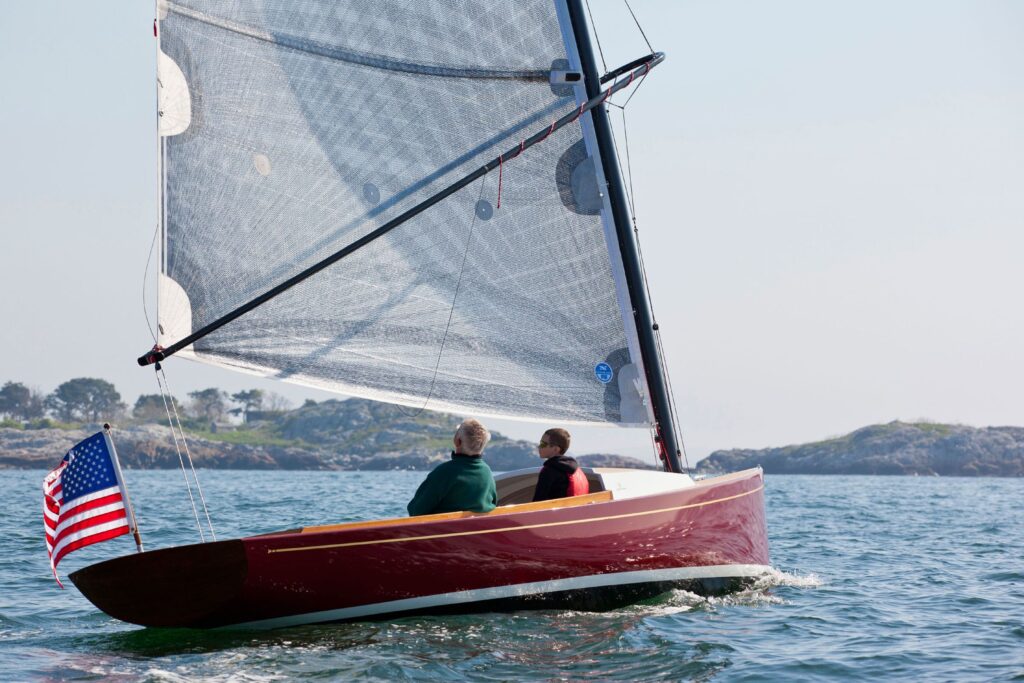
Source: cruisingworld.com
This is a traditional-looking monohull perfect for anything relative to small sailboats. Even though it is compact, there is still plenty of room for guests on board.
It’s got a cockpit almost 12ft, it can seat several people, and has a stowaway cuddy too. With a bulb keel, it still isn’t ideal in shallow water.
A laser is a small sailboat often raced. They’ve been used in the Olympics each year since’96. Lasers generally tend to capsize if they are not handled correctly. These are good beginner boats, however, they are best for calm conditions.
3. Catalina Sport
The Catalina 22 Sport has earned a reputation as one of the best small sailboats for many years. It has many simple amenities for different goals in sailing, however, it also has a retractable keel allowing for shoal draft exploration.
For boats of this size, it can sleep up to 4 people and even has a swim ladder in the back. Sailors which are used to simple designs will also appreciate its roller furling jib, mainsail, and fractional rig.
Under 25 feel, it is the queen of small sailing boats.
4. Cape Cod Daysailer
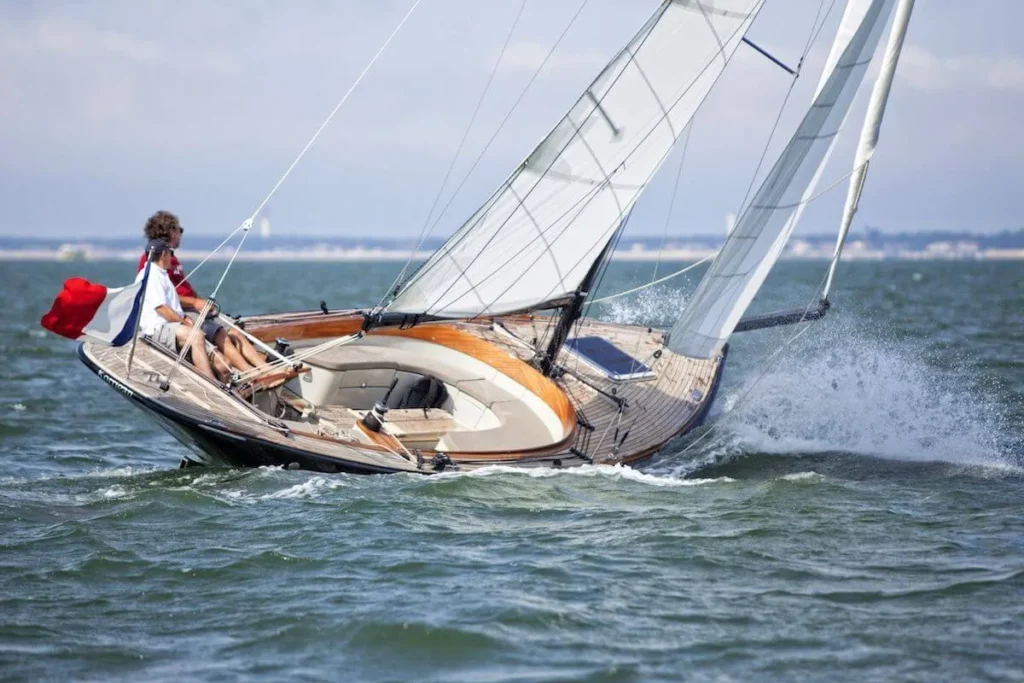
Source: rosewest.fr
This Daysailer was one of the first of its kind in the ‘50s, it could travel in many ways, from racing, cruising, or as a pleasure craft.
Around 1,000 were built by various shipyards, however, Cape Cod still produces them. For a 16 ft sailboat, it also packs a punch with affordable pricing and enough space for a small family.
5. Bay Raider
Bay Raiders are small sailboats that are easy to navigate and put on trailers for transport. What is great about them is that around the whole 20 ft is an open cockpit. However, on rough waters, it is ideal to add a spray hook which may add stability with 300 lbs of ballast.
6. Beetle Cat
For those who enjoy solo rides, this is a good ride, it’s got a 2 ft draft and is around 12 ft in length which makes it ideal for coastal cruising in tight spaces. It has a single gaff-rigged sail and has loads of power, even in light air. It is nice to use even in rough waters.
7. West Wight Potter
This has a specific model, the P19, which is one of the best small sailboats. It is only just under 20 ft and has a galley, dink, 4 berths, stove, and a cooler. It is also in a closed-cell form on the aft and fore which makes it nearly unsinkable.
8. Norseboat
These boats are 17.5 ft and are great for sailing and rowing. It is not ideal in rough waters, but it has amazing load capacity and many opportunities to bring gear with no fear of the boat getting weighed down.
How to Choose?

Source: sailreverso.com
First, it’s important to think about what kind of boat will best suit your needs. Consider your sailing skill level and the type of terrain that you plan to sail on. You may want a boat that is easily maneuverable for areas with shallow water or one that is built for larger bodies of water with more wind. Also consider size; if you plan on recreational cruising, then a small boat might suit your purposes better than a larger craft.
Next, make sure you choose a boat that meets local safety regulations and isn’t too expensive for your budget. The cost of repair, maintenance, insurance, docking fees, and so on can add up quickly, especially if you’re new to sailing. Research different brands and models online to see which ones are best recommended by experts in the field and what their costs are estimated for upkeep.
Thirdly, look at the features available with each model before making your selection. A good place to start is determining what kind of sails or rigging will work best based on where you’ll be sailing most often as well as whether you need additional storage space or other accessories such as GPS navigation systems or autopilots. Additionally, inspect the hull thoroughly for any cracks or weak spots before making any purchases so that you know it is safe to use in deep waters and other conditions.
Finally, when shopping around compare prices between stores since they could vary drastically depending on the availability and age of the sailboat in question. Before purchasing anything take time out for practice sessions to get accustomed to the particular model beforehand so even more informed decisions can be made afterward without any regrets later on down the line when its too late to do anything about it anymore after the investment has been done already due to poor planning in terms of gathering info prior deciding for purchase!
Honorable Mentions
- Super Snark
- Flying Scot
- Vancouver 28.
While these are not the only small sailboats out there, these are some of our favorites, and now you are ready to start your sailing adventures . Small sailboats can be really beneficial, however, always make sure that you choose the right one for your needs, as every small sailboat is different.
Related Posts:
- 10 Types of Small Parrots
- Traveling The World With Crypto In 2024 - A Complete Guide
- A Complete Tour Guide to Nusa Penida Island in Bali
- What is Biometric Verification? A Complete Guide
- Your Complete Guide On How To Buy Used Clothing Bales
- How To Complete An Essay When You Can’t Focus?

Recommended for you

Popular Posts

The Healing Power of Planting a Tree in Memory of a Loved One
Losing a loved one can be one of life’s most difficult experiences. In the...


Venture Through the Galapagos Islands on a Private Yacht In 2024
Going on a trip to the Galapagos Islands gives you an entry into a...

Exploring Gambling As Entertainment: Benefits & Risks
Gambling as a form of entertainment has taken top places in the popularity charts...

Why Bandhani Sarees Are the Epitome of Elegance in Summers
As the sun blankets the world in its radiant warmth, wardrobes undergo a seasonal...

The Timeless Appeal of Glass Splashbacks in Family Kitchens
The kitchen is in the heart of every home, where families gather, meals are...
Recent Posts

Beginner’s Guide For Studying Real Estate Online in AZ
Arizona, especially towns surrounding Phoenix, has always been appealing to real estate investors and...

8 Innovative Fencing Ideas to Elevate Your Garden’s Aesthetics
A Garden is a perfect place to build a deep connection with nature and...

In-House vs. Outsourced Receptionist Services ─ A Comparative Analysis
Who’s the first person you encounter when you enter an office? A receptionist, right?...

5 Must-Visit Destinations in The United States In 2024
The United States is a treasure trove of travel destinations catering to every kind...
- Skip to main content
- Skip to secondary menu
- Skip to primary sidebar
- Skip to footer
Crowsurvival
Experience the Best that RVs, RV Accessories, Campers, Boats, Camping, Hiking & Fishing has to offer.
12 Perfect Small Sailboats
Jonathan Holmes 5.0 Rated 5.0 out of 5 5.0 out of 5 stars (based on 40 reviews)
Thank you for reading our post, please rate this article at the end.
Last Updated on December 31, 2023 by Jonathan Holmes
Easy to rig, simple to toe, compact, manageable, maintainable, and affordable, all the perfect small sailboats have one thing in common: they always provide an adventurous tour in the sea.
So, either you are looking for something light on the pocket or just an adventure enthusiast wanting some safe daytime ride, the perfect small sailboats are the sole good means to fulfill your call.
After all, honestly, everybody does not need large 30 ft sailboats for cruising. However, large boats offer a lot of features like bunks, refrigeration , entertainment, and electronics. But are these features necessary for just boating? Well, I guess not.
When cruising, you only require a boat, a sail, a rudder, and a mast. Thus, nothing can offer you the ultimate adventures of coastal cruising better than small sailboats. Small sailboats not only provide you a breezy feel in the water but also offer you the opportunity to sense every change in trim instantaneously.
Table of Contents
12Best Small Sailboats
The market has a wide variety of small sailboats that measure less than 20 ft in size. Moreover, they are quite hit products as they offer great fun in the water.
With this guide, you may equip yourself with all the necessary information about the top 12 small sailboats. My top picks are just perfect as they’re simple to sail, easy to rig, and time-tested. Thus, if you were looking for a listing of the perfect small sailboats, you’re certainly on the right post.
Keep scrolling to read on for the best small sailboat picks.
Hunter 22 is a clever boat for a very fair price. It retains the hull of its predecessor- Hunter 216, featuring an open transom and a large cockpit. However, it is made of fiberglass with balsa-cored topsides and a solid bottom section.
Furthermore, the deck is a bit changed, having a 40 sq. ft. larger rig. Similar to Hunter 216, it, too, features a hydraulic ballast keel. The Hunter 22 is primarily designed to offer a thin line between “go-fast mini-sport boat” and “fun family daysailer and weekender”.
You can select between either half of them according to your requirements.
The cruising package features a simple electrical system, a portable toilet, and a V-berth in the small cuddy cabin. Whereas, the performance package offers an asymmetric spinnaker, a retractable bowsprit, mid-cockpit traveler, hiking grips, and straps in the cockpit.
- Hunter 22 is a daysailer.
- It offers a portable toilet.
- The manufacturers offer an optional electrical system with Hunter 22.
- The boat features a large cockpit and open transom.
- It offers a cuddy cabin and twin bunks.
- It features a hydraulic lifting centerboard and laminated fiberglass deck and hull.
- Comfortable
- Fair priced
- Easy for trailing
- Faster than most of the other boats available in the market
- Versatile and family-friendly
- Might need some replacement parts
Catalina 22 Sport
The retractable keel and basic amenities allow the Catalina 22 Sport to be trailered easily. Basically, the Catalina 22 Sport is an updated design of its predecessor Catalina 22.
The large cockpit is enough to seat a crowd. It offers a fractional rig with a mainsail and a roller-furling jib, a cabin that provides bedding for four with a forward hatch for ventilation, and a retractable lead keel.
In essence, the Catalina 22 Sport is more of a family-friendly racer. Also, it offers an alternative to choosing an older boat.
Besides, the Catalina 22 Sport offers the value and quality Catalina has come to expect since 1970. It is simple to rig and an excellent sail to step up from dinghy sailing to budget cruising.
- Catalina 22 Sport is a daysailer.
- It offers an adjustable outboard motor bracket.
- The boat features a comfortable cockpit with contoured coamings.
- It has an anodized aluminum mast and boom.
- It offers low stretch halyards and internal halyards.
- Catalina 22 offers a complete standing and running rigging.
- Many interior features, including Fiberglass Hull Liner, molded Headliner, and Low Glare Texture.
- Easy for trailing with its swing keel
- Family-friendly
- Simple to rig without a complicated setup
- Fast in speed
- Stability and reliability
- Features spacious cabin
- If you choose some old models, you will need some replacement parts.
- Not much trendy considering the interior and upholstery
Hobie Cat 16
The legendary Hobie Cat 16 has revolutionized boating . Firstly, it belongs to a proud watersports lineage, which within a few years of the foundation was loved by thousands.
Secondly, The Hobie Cat 16 is either used as a daysailer or a racer. The double banana-shaped hulls easily cut through the water, and the boat gets going fast even in light winds, as the aluminum alloy frame and two sails catch wind considerably.
Thirdly, there would certainly be no complete roundup of fun, trailerable, and small sailboats without any mention of the venerable Hobie Cat 16. The large trampoline provides a spacious platform to move about. Moreover, it offers many optional features, including a beach dolly, trailer, douse kit, a spinnaker, and a main and a jib.
In essence, it is a classic boat; enthusiasts and collectors covet it alike. Undoubtedly, it has the pedigree to prove that it is the red Ferrari in the world of cruising.
- The mast is 26 ft 6 inches tall and weighs about 320 pounds.
- The boat is 16 ft 7 inches in length and 7 ft 11 inches in width.
- Two color options are available.
- The dual-trapeze rig offers you harness its sheer power.
- The asymmetrical fiberglass hulls offer lift
- Low maintenance sailboat
- Reasonably priced
- Perfect for a Small Crew
- Easy to trailer
- Simple to rig
- Sailing may be hard when you’re alone.
Norseboat 21.5
In essence, the Norseboat 21.5 offers everything an expensive trailer-sailer does. It features a sensible centerboard arrangement, contemporary, good fit and finish, high-quality construction, and sea-kindly underbody.
The value of Norseboat 21.5 lies in its charm. You will easily fall under its spell if you are into the idea of a solid and easy-to-sail boat. The price tag looks much higher for a small 21 ft boat. However, the hype of Norseboat 21.5 tells you that it’s worth it.
Moreover, the NorseBoat 21.5 offers several configurations: one with a small cockpit and cabin that has a double berth for two adults and an optional berth for children, and another with an open cockpit and smaller doghouse.
Each of them comes with a ballasted stub keel and centerboard and carries the brand’s exclusive carbon fiber gaff-rigged mast. Also, the lightweight design of the Norseboat 21.5 offers easy rowing and a simple trailer.
- Norseboat 21.5 offers a lightweight design.
- It offers two different configuration options.
- Norseboat 21.5 has rowing stations.
- It features an electric outboard.
- The hull and deck are of fiberglass with a wood core.
- Comfortable and versatile
- Expensive compared to the other sailboats on the list
Barney Lehman and W.D. Schock designed the Lido 14. It is an American sailing dinghy that was built in 1958 for the very first time.
In essence, the Lido 14 is a classic sailboat that proves to be a perfect pick to suit small boats, especially for the owners who are still learning the ropes of boating.
The Lido 14 is just perfect for shorthanded racing, single-handed sailing, and solo sailing. It offers seating arrangements for about six people at most.
In the first year of its launch, two hundred Lido 14 boats were ordered. And, around 6300 Lido 14s had been built for 40 years. Today, a new Lido 14 boat is not available in the market; however, you will not regret ever getting a functional used boat.
Thus, the Lido 14 makes your investment worth it and serves you well throughout the journey.
- It offers a retractable centerboard raised with stainless steel straps.
- The hull features a near-vertical transom, a spooned plumb stem, and a transom-hung rudder controlled by a tiller.
- It has a fractional sloop rig with a loose-footed mainsail and anodized aluminum spars.
- Non-intimidating
- Has the car top capability
- Easy in handling
- New models not available
RS Sailing is primarily known for its line of racing dinghies. It built the 16-ft, 4-in sized Venture, which is such a perfect training and cruising dinghy.
The Venture offers a large, self-draining cockpit that can accommodate a group of friends or a family. Whether you are just messing about with your family or friends, club sailing, or just up for casual racing, RS Venture delivers the best with all its features. It is among the most versatile and nimble dinghies for sailing the masses.
In addition, the RS Venture can carry up to eight people in its self-draining cockpit. The excellent performance makes it adventurous; the multiple equipment options allow several boat configurations.
Moreover, the RS Venture is the winner of multiple awards. The excellent stability makes the boat ideal on coastal water, offering an advantage to those learning the sport.
More importantly, The RS Venture has the potential to carry more people in it than its dinghy rivals.
- The RS Venture offers a spacious platform.
- It features a rear back storage.
- The boat also offers reverse transmission.
- It has an open cockpit with high buoyancy.
- The exterior is composed of plastic and dual carbide.
- Can be car toped
- Versatile and stable
- Simple to handle
- Good looking
- A bit expensive
Super Snark
The Super Snark is a simple, lightweight, lateen-rigged daysailer, marketed as the “Super Sea Snark.” It is fun sailing, easy to learn, unsinkable, and simple to set up, and transport. Most of the people who get it find it satisfying to their sailing requirements.
Moreover, Super Snark is highly portable and storable. It can easily load onto your vehicle due to its construction and light-weight. In addition, the roof racks with slide-out loading bars make moving much easier.
Termed as unsinkable, the Super Snark is built with EPS foam, with the external hull and deck, which is vacuum-formed to the deep with ABS. polymers. The Super Snark weighs approximately 50 lbs having a capacity load of 310 lbs. It can carry two people at once.
- It has the capacity for two people.
- The internal hull leaves no void as it is filled with EPS foam, making the boat unsinkable.
- Mast, spar, and boom are of aluminum.
- It is made of recycled plastic.
- It weighs approximately 50 lbs
- Lightweight
- Car top-able
- Recyclable construction material
- Easy to learn
- Simple to setup
- Not family-friendly
The Laser is one of the most popular single-handed racing sailboats available in the market. With its simple rigging and simple design, Laser started single-handed racing 50 years ago when it came out. Interestingly, with over two lacs made, it is the most popular race boat in the world.
Everyone enjoys the Laser, from club racers to Olympians. It is a simple vessel to own and rig, which rewards practice and good sailing techniques. The Laser is built with updated foils and sail controls.
Moreover, a three rigs system allows the sailors to enjoy boating. It offers a seating capacity for two people. This boat is a fiberglass lightweight model easy for capsize and recovery.
- It has the capacity for two people seating.
- Includes the upgraded Vang, Cunningham, and Outhaul controls
- The boat features heavy fiberglass hull construction with aluminum spars.
- It has a small rudder with a lower boom.
- Worldwide popular and recognized racer
- Car top capability
- Stable and easy to handle
- A bit hard to sail
If you are looking for a good looking sailboat with excellent performance, the Paine 14 is here for you. It features a contemporary fin keel and spade rudder, which makes it more agile and faster.
In essence, Paine 14 is an old-time appeal with its varnished gunnels and transoms. However, it offers all the modern features every updated boat has. You can rig this boat with a gaff or a Marconi rig and can trailer it behind a vehicle.
In fact, Paine 14 can sail under mainsail alone due to the large flotation compartments fore and aft. The rig is simple, with an unstayed carbon-fiber mast and a mainsail bent onto its spars.
Overall, the Paine 14 feels like a favorite classic daysailer when you sit in it. The bronze hardware, the slatted-wood cockpit sole, and the varnished trim; all of these are elegantly designed. The cockpit ergonomics are seamless, and the sail controls fall perfectly to hand.
- It features a modern fin keel and spade rudder.
- The boat is built in seamless epoxy cold-molded wood construction.
- It has parallelly fitted fiberglass battens to the luff, which extend from the leech to the foot of the sail.
- Easy for trailing with its fin keel
- Good prevention of slippage
- Features spacious platform
- Not much trendy in looks
FAR EAST 18
The FarEast 18 is a low maintenance 19-ft vessel that offers high speed cruising in the sea.
Equipped with an open deck, the Far East 18 offers excellent performance. It offers great safety and stability due to its design. The hull has a beautiful shape that can be easily handled.
The lifting keel and the removable rig makes it easy to transport by a trailer. It takes a square-top fixed mainsail and an asymmetrical spinnaker, which is a driving force for buoy racing. The Far East 18 can compete with six crew but also offers bedding for three people when you are staying out overnight.
Moreover, this vessel features an updated bulb keel with carbon structure, vacuum-infused foils, and fiberglass hull. Best of all, a single person can easily rig and launch FarEast 18. Moreover, you can trailer this boat easily with a displacement below 1500 pounds.
All in all, Far East 18 is an excellent little sailboat available in the market.
- Small cabin instead of a reduced deck
- It features an updated bulb keel.
- The boat features a spacious cockpit.
- It has a lightweight structure.
- It is constructed with a vacuum infused polyester sandwich.
- Not too brutal on the pocket
- Comfortable and low maintenance
- Modest Price
- Does not perform well in strong wind
The Sage 17 was designed in 2009 by Jerry Montgomery. It is a small, stable, go-anywhere vessel, featuring a transom with a balsa core, a carbon fiber deck, and a cabin roof.
The Sage 17 is a 1300 pound vessel. It comes with a loose-footed main and a working jib that sheets inside the lifelines. There is a kick-up rudder, a 120-lb centerboard, and a 400-pound lead keel that will not strand while cruising through shallow water.
In addition, this boat is simple enough for beginners and sophisticated enough for experienced sailors. It is manufactured to handle your adventures with safety. It comes with a non-skid covering on the horizontal surfaces, a bow pulpit, transom-mounted boarding ladder, and a self-draining cockpit.
Moreover, this model is hand-built with vinyl ester resin, fiberglass, and carbon fiber in a lapstrake style to offer you enhanced strength. The cabin and deck are made of a balsa core and carbon fiber.
The Sage 17 sails fast in light air and provides unruffled travel as the wind blows more strongly. You will definitely enjoy hindrance free comfort in the airy open cabin. And, you can get customized cabin cushions that are available in different colors.
- Jib downhaul lead for the cockpit
- Cabin-top mounted winches and jib tracks
- Internal halyards
- Single reef main and working jib, with running rigging
- Complete mast and stainless-steel standing rigging
- Fiberglass and vinyl ester lapstrake hull with a carbon fiber
- Carbon fiber and vinyl ester deck with a balsa core
- A variety of options available to choose from
- Simple enough for beginners
- Safe and durable
- Quite reasonably priced, considering all the features
- Might require some replacement gears
Montgomery 17
The Montgomery 17 was designed for Montgomery Boats by Jerry Montgomery in conjunction with Lyle C. Hess. It was manufactured with centerboard and keel models.
The Montgomery 17 offers more stability than most of its rivals. And, when it comes to comfortability, the Montgomery 17 again stands above the rest.
This boat has the capability of going about moderate offshore passages. You can easily trailer it as it is small enough in size.
Moreover, it is designed with a masthead and toe rail that fits most of the foresails. It has a proper amount of storage area, a DC power, an optional shore, and seating arrangements for two people offering a headroom, a pair of bunks, and a portable toilet.
Overall, the Montgomery 17 is among the giant-killers of the market when it comes to performance. Though small in size, it makes its way past its larger rivals and excels in the extremes.
That is not just it; using a four-part gear, you can easily uplift the deck-stepped mast.
- The hull type is swing keel.
- A flush deck version is also available.
- Some versions feature a fixed keel.
- There are three types of keel configurations available; retractable keel, shallow draft fixed keel, and a shallow draft fixed keel in conjunction with a centerboard.
- Comfortability
- Quite faster than its rivals
- Outstanding racing record
- Favorable handicap
- Not suitable for deep sea
The Wrap Up
Hitting the water with the right sailboat can be an overwhelming task for many. To ease this process, the list above has narrowed down the 12 perfect small sailboats.
While there are infinite sailboats available in the market, the sailboats, as mentioned above, will serve you right and make you enjoy the ride.
However, in my opinion, the best of all is none other than the Catalina 22 Sport as it is the most moderate pick of all. You don’t have to compromise on either the quality or affordability.
In my opinion, you must not spend too little or much for too low or too high quality. A moderate model will serve as the perfect pick for you. Thus, Catalina 22 Sport being moderately robust and not-so-expensive wins my heart.
Related posts:
- Affiliate Disclosure
Our Love for this stuff, unfortunately, does not pay the bills. Our audience supports us. We may earn an affiliate commission when you purchase through links on our site. This does not mean your purchase price will be higher. Sometimes, it could be lower due to our relationship and volume with the merchant. So shop with confidence. You are getting a good deal!
Terms and Conditions - Privacy Policy
- Pontoon Boats
- Personal Watercraft
- nauticalknowhow
- Nautical Knots
- Tools and Calculators
Types of Sailboats: Classification Guide
Sailboats can be divided into three basic types based on their hulls (catamaran, monohull or multihull) , their keel and their rigging, and then further subdivided from there. The result is that there are actually well over a dozen different kinds of sailboats out there.
Sailboat Hull Types
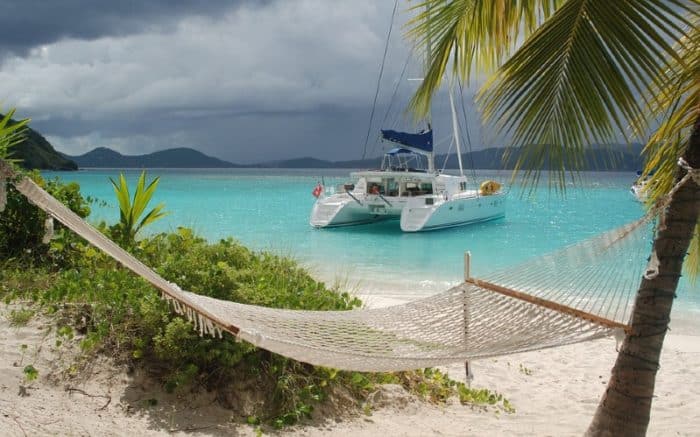
There are three main hull types that you’ll find in sailboats.
- Monohull: This is what most people think of when they think of a sail boat or any boat at all, really. A monohull sailboat has a single hulled structure that gives a boat that traditional boat shape we all instantly recognize. These are far and away the most common hull type for sailboats because they’re some of the oldest, they’re cheaper to produce, and they are fairly easy to maintain compared to the other options. You can do a lot more with the rigger in monohull sailboats and any sailing vessel with multiple masts is invariably going to be a monohull one. The downside of the monohull compared to the others is that they lack the stability.
- Catamaran: The second hull type you’ll find in sailboats is the catamaran . While technically a multihull vessel, they feature two hulls that are located on either side of the boat connected by a deck. Because it’s just the two, they get called catamarans rather than multihull which generally refers to three. Catamarans had been used by ancient peoples for years but never really caught on with “modern” boating for quite a long time. Now that we have fiberglass hulls and other advances, catamarans are much more commonplace than they were a hundred years ago. Catamarans offer great speed and stability but don’t have as much cabin space as a monohull.
- Trimaran/Multihull : This hull style features three hulls in a similar style to the catamaran with the addition of that third center hull. From the side you wouldn’t be able to tell a catamarans from trimaran sailboats. These boats are even faster and more stable than a catamaran and, by extension, a monohull. They have a very low center of gravity and a large beam. Space is still a drawback but the third hull increases room overall. There are also vessels with even more hulls, but they are exceedingly rare and also pretty expensive.
Sailboat Keel Types
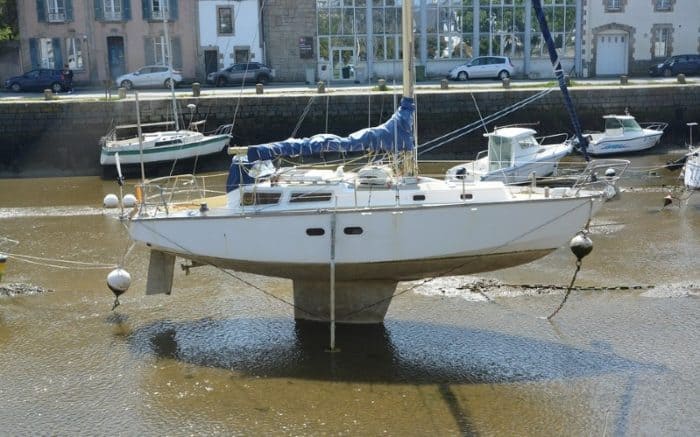
Heading below the hull now and we’ll find the keel, which is what gives your sailboat added stability in the water. While multihull boats find stability in the additional hulls, a monohull boat will get stability from its keel. Though it’s nearly impossible to flip or capsize a trimaran, if it does happen it’s staying flipped or capsized. However, the keel on a monohull boat makes it even harder to flip because of the physics of resistance in the water. That isn’t to say a monohulled boat with a keel is unsinkable, quite the opposite, but you’re just not going to flip one upside down without a real fight. There are six main keel types you’ll find in sailboats.
- Bilge Keel: These are dual keels that can be like fin keels or even full keels extending the length of the vessel. They extend from the sides and can prevent the boat from rolling. They need to be symmetrical on both sides of the boat to work.
- Bulb Kee l: These are a kind of fin keel but they carry ballast in them. That allows them to have a little more stability. They operate like a hydrofoil
- Centerboard Keel: This type of keel actually pivots and can be changed depending on the depth of the water.
- Daggerboard Keel : Another kind of centerboard keel but the daggerboard can actually be pulled up into the hull. This allows you to alter its position for an increase or decrease in speed or stability as needed.
- Fin Kee l: If you’re into racing you’ll probably have a fin keel. They are thin but extend deep below the sailboat. This makes them great for speed but not really ideal for a comfortable ride. You wouldn’t want to be day sailing for fun and relaxation with a fin keel.
- Full Keel: This is the most common type of keel and it spans the entire length of the vessel. There will likely be a rudder built into the keel as well.
- Wing Keel : This is a variant on the fin keel. Wing keels have a small wing at the tip to allow better directional stability by reducing cross flow.
Sailboat Mast Configuration
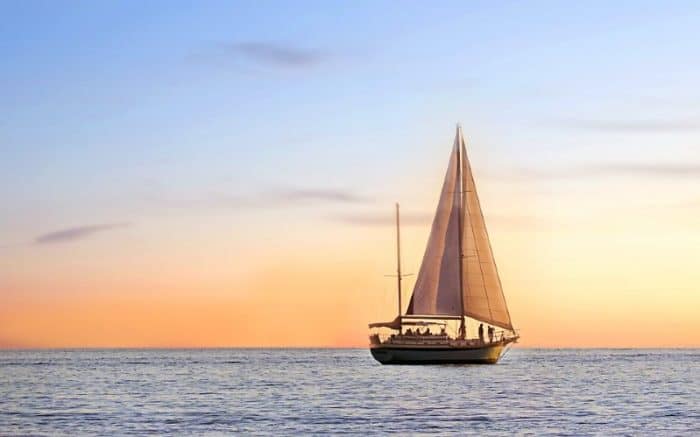
The mast of the sailboat is obviously that large pole onto which sails are rigged. Depending on your boat type you may have one mast, two masts, or more masts. How these masts are configured is where you can start distinguishing sailboat types you may recognize by name. These include:
Sloop: This is arguably the most popular type of sailboat mast type. A sloop has a single mast and two sails – the headsail and the mainsail. Being a single masted sailboat makes them easy to identify. These are probably the easiest to learn how to rig and how to sail. It’s versatile enough for cruising and for racing. Commonly these a gaff rig or a Bermuda rig. Another kind of sloop rig is the fractional rig sloop in which you can find one of the sails below the top of the mast.
Schooner: These can have multiple masts, not just two. The largest sailing vessels you’re likely to see, either in the present or in images from history, were schooners. Giant ships with six masts each bearing over 10 sails were schooners. An important detail is that the first mast on a schooner will always be shorter than the others. They are usually gaff-rigged
Cutter: This type of sailboat is very similar to the sloop and has a centrally located mast supporting three sails. Two headsails, the second called a staysail, is what distinguishes it most easily from the sloop. The rigging makes a cutter a bit harder to manage than a sloop.
Ketch : A ketch is a lot like a schooner but the two masts are arranged differently. On a ketch, the main mast is taller than the aft mast which is called the mizzen mast. The mizzen sail naturally is on the mizzen mast with the mizzen mast positioned aft.
Catboat : Also called a cat, a catboat has a single mast and a large, single gaff sail. The boats are usually short, stout boats that aren’t built for speed or for open seas. Best to be used in coastal waters
Yawl: This vessel is nearly identical to the ketch with one main difference. In a yawl, the helm is forward of the mizzen mast, while that is not the case in a ketch.
Other Types of Sailboats
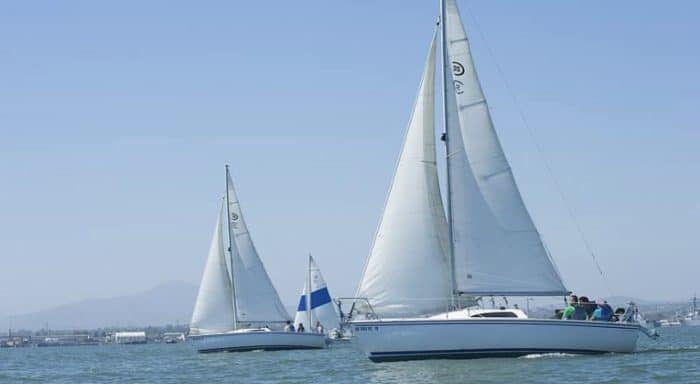
Now that we have the basic configurations out of the way, let’s look at some of the more specific types of sailboats you may find at sea. In some cases you’ll see that these terms are not entirely specific and one term may actually apply to multiple kinds of sail boats in much the same way that something like SUV can describe multiple different vehicles that are similar but not all the same.
Sailing Dinghies
Like any dinghy, a sailing dinghy is going to be a small vessel. Typically made to accommodate just one or two people, they are under 15 feet and the smallest of which are often used by children. Optimist dinghies are raced professionally and must meet certain requirements to be officially registered as true Optimist boats. If you’re totally new to sailing, a sailing dinghy might be a good place to learn the ropes.
Daysailer generally refers to any sailboat that is not intended to either race other boats or keep you out on the water for an overnight stay. As such, it can cover a lot of ground. Typically, a daysailer will probably be between 14 feet and 20 feet. Usually you won’t get more than 4 people on board and there will be room for storing gear but not a sleeping berth. These are great beginner sailboats.
Pocket Cruisers
Like a daysailer, a pocket cruiser is more of a general label for boats rather than a specific kind. In this case, any sailboat under 30 feet could technically be considered a pocket cruiser. Basically it should be trailerable and used for either cruising or racing. They may contain a small cabin or berth. They could be outfitted for long offshore trips.
Trailer Sailer
Very similar to a pocket cruiser, a trailer sailer is a smaller vessel but still larger than a sailing dinghy. There is clear overlap between trailer sailers, daysailers, and pocket cruisers and the same name could technically be used for many different boats. The defining characteristic of a trailer sailer is that it can easily be transported by trailer behind your tow vehicle. Unlike a sailing dinghy, a trailer sailer would likely have a retractable keep like a centerboard or daggerboard.
Racing Sailboats
These boats can be very large, anywhere from 20 feet to over 70 feet, and they are designed to be light and fast on the water. Larger racing sailboats required a skilled crew to operate. These have keels intended to increase speed and even laminate sales to improve performance. Smaller racing boats can be manned by just one or two people. They don’t offer a lot of creature comforts and aren’t meant for relaxing trips at sea.
Beach Catamarans
Beach cats get their name from the fact they’re designed to be beached and can be launched again from the beach if you so desire. They are usually under 25 feet and not meant for extending sailing offshore, rather they are designed for daysailing. They are very agile and fast and take a good foundation of knowledge to control properly.
Cruising Catamarans
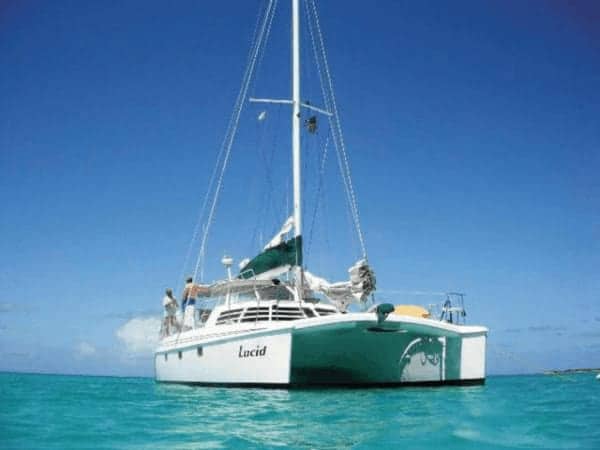
This is the larger style of catamaran designed for more serious boating. Like any catamaran they have a shallow draft but these can be between 25 feet and up to more than 50 feet. They’re designed for extended cruising offshore.
Cruising Sailboats
Boats like schooners quality as a cruising boat and they are typically at least 16 feet in length but may get well over 50 feet as well. Cruising sailboats include cabins for extended stays offshore and, if the boat is large enough, will likely have a fairly large living space below deck which includes a galley and a head in addition to sleeping berths. These are often called liveaboard sailboats .
Cruisers are often monohull but can just as easily be multihull. When properly outfitted they can be used for long, extended stays at sea that last weeks or more. Depending on rigging a cruising sailboat could easily be a sloop, a schooner, a cutter, a ketch or even a superyacht.
Racing Cruisers
This is essentially a hybrid of the cruising sailboat and the racing sailboat. It’s built for more speed than a cruiser but it will have better accommodations than a racing sailboat to allow for stays at sea. The end result is a lighter cruiser ideal for a few days at sea that can get some good speed.
Bluewater Cruising Boats
These are basically the next step up from a cruising sailboat. A bluewater cruiser is meant to sail across oceans, which is where the bluewater part of the name comes from. These are large sailboats and are best only sailed by skilled sailors. They can be outfitted for very long stays at sea and are able to handle rough weather better than smaller vessels.
Motorsailers
You don’t hear this term much anymore but it refers to a sailboat that also has an inboard motor so that they can travel under engine power or wind power. Typically these are larger vessels with accommodations below deck and designed for extended stays off shore. That said, because they mix both styles of boat, they fall somewhere short of either in terms of performance. The engine takes up space and adds weight, limiting your sailing abilities. Obviously traditional sailboats won’t include a motor.
The Bottom Line
There are a number of different kinds of sailboats and the easiest way to distinguish them is by comparing hull types, sail and mast configuration, and keels. Many terms you hear to describe sailboats can describe more than one kind, while others are very specific and the boat must meet certain requirements to merit the name. The only thing that truly unites every type of sailboat is the fact it must be powered by the wind, and even then there are hybrid versions that use motor power sometimes.
Learning the rigging of the different types of sailboats, including things like gaff rigs, standard rigging, and other rig types can be hard work and time consuming as some of these sailing boat rig types are far more complex than others.
My grandfather first took me fishing when I was too young to actually hold up a rod on my own. As an avid camper, hiker, and nature enthusiast I'm always looking for a new adventure.
Categories : Boats
Leave a Reply Cancel reply
Your email address will not be published. Required fields are marked *
Save my name, email, and website in this browser for the next time I comment.
More in Boats

What Is A Gunwale?

131 of the Best Hawaiian Boat Names

167 Patriotic Boat Names

The 138 Best Boat Names for Dog Lovers

The People’s Poncho Review and Ratings

Oru Lake Kayak Review

About Boatsafe
Established in 1998, BoatSafe is your independent guide into the world of boating, fishing, and watersports. We provide expert insights and detailed guides to help you find products tailored to your needs and budget.
Contact Boatsafe
- Address: 4021 West Walnut Street. Rogers, AR 72756
- Phone: (479)339-4795
- Email: [email protected]
Site Navigation
- How We Test
- Corrections Policy
- Privacy Policy
- Terms & Conditions
- Editorial Policy
- Affiliate Disclosure
Our Reviews

All content is © Copyright 2024. All rights reserved.
Types of Sailboats: Essential Guide for Every Sailor
Sailboats have been an essential part of human history, contributing to exploration, trade, and leisure. With a myriad of designs and sizes, these versatile vessels cater to various purposes and preferences. The defining characteristics of sailboats come from their rigging, sails, and hull design.
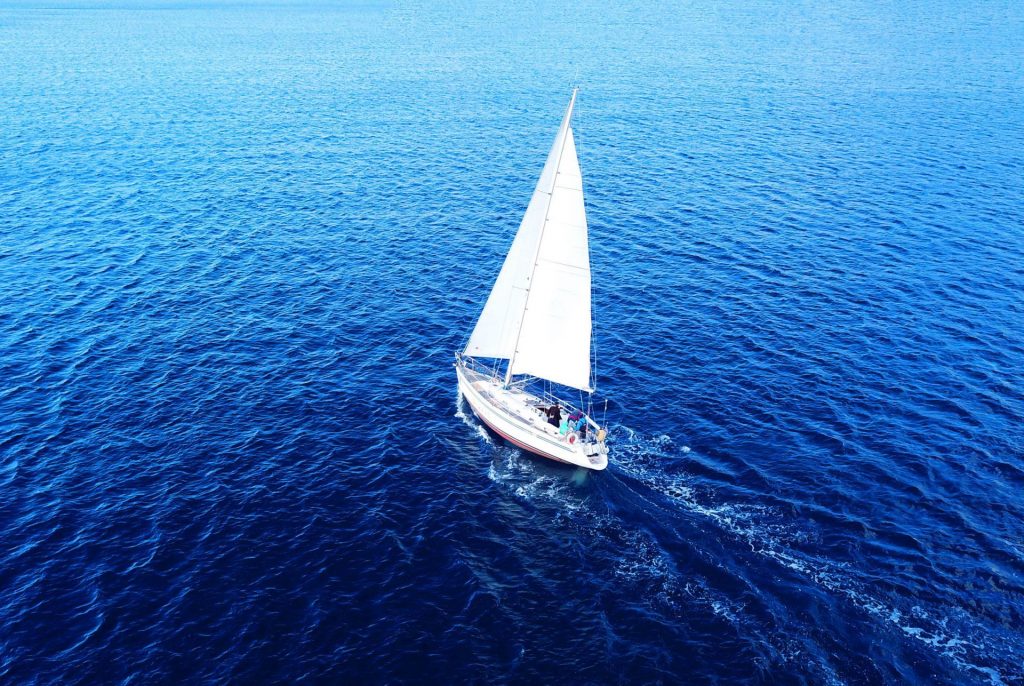
The basics of sailboat design play a significant role in the classification and function of these vessels. Hull shapes, keel types, and construction materials contribute to the speed, stability, and maneuverability of sailboats. Additionally, rigging and sails come in various shapes and sizes, which influence sailing performance and handling.
Key Takeaways
- Sailboats are classified by hull design, rigging, and sails that serve specific purposes.
- Designs and materials have a direct impact on the performance and handling of sailboats.
- A wide range of sailboat types exists, which cater to different needs and preferences.
Basics of Sailboat Design
Sailboats come in various shapes and sizes, designed for different purposes and sailing conditions. One can classify sailboats based on hull types, keel types, and mast configurations. This section will briefly discuss these basic components of sailboat design.
There are mainly two types of hulls: monohull and multihull.
- Monohull : This is the traditional and most common type of sailboat hull. It consists of a single hull, providing stability through the use of a keel or centerboard. Monohulls come in various shapes and sizes, suitable for various sailing conditions.
- Catamaran : Catamarans have two parallel hulls of equal size, offering increased stability and speed compared to monohulls. They are commonly used for cruising and racing.
- Trimaran : Trimarans have three hulls, with a larger central hull and two smaller outrigger hulls. This design offers even more stability and speed than catamarans.
The keel is an essential component in sailboat design, helping with stability and performance. There are various keel types, including:
- Full keel : This traditional design features a long and wide keel that extends along the boat's bottom. It offers good tracking and stability but sacrifices speed and maneuverability.
- Fin keel : Fin keels are shorter and deeper than full keels, providing a better combination of stability and maneuverability. These are common in modern monohull sailboats.
- Bulb keel : A bulb keel features a fin keel with a heavy bulb at the bottom, which concentrates the boat's weight, increasing stability and performance in rough conditions.
- Swing keel or centerboard : Swing keels and centerboards can be raised or lowered, allowing the boat to adapt to different water depths and sailing conditions. They are common in smaller boats and racing sailboats.
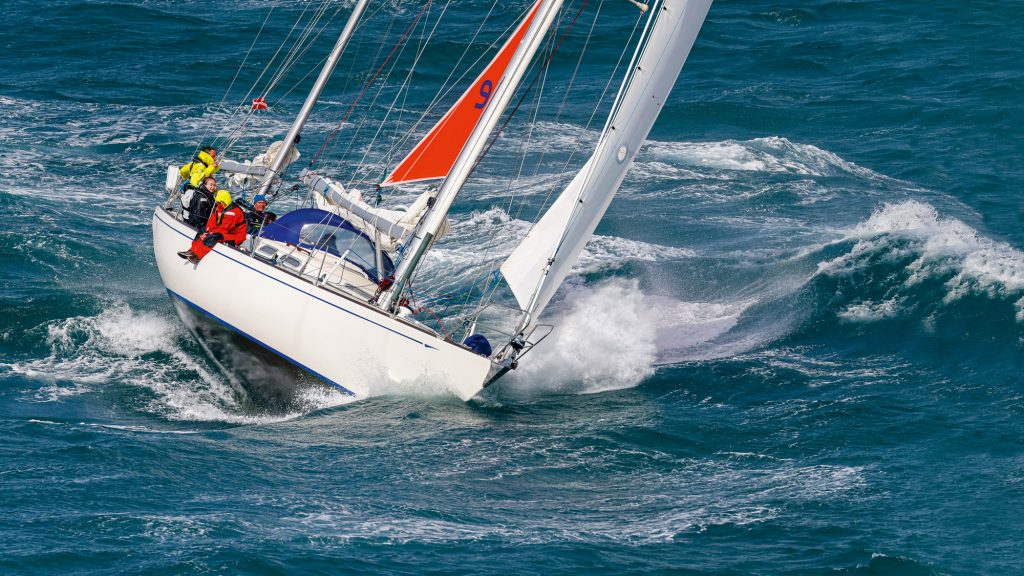
Mast Configuration
The mast configuration affects the sail plan and overall performance of a sailboat. Some common mast configurations include:
- Sloop : This is the most popular mast configuration and features a single mast with a mainsail and a headsail. The simple design makes it easy to handle and suitable for various sailing conditions.
- Cutter : Similar to the sloop, the cutter also has a single mast but carries two headsails, providing more sail area and better performance in heavy weather.
- Ketch : A ketch configuration has two masts: a taller main mast and a shorter mizzen mast. This design offers more flexibility in sail combinations and better balance in different sailing conditions.
- Yawl : Similar to a ketch, a yawl also features two masts but the mizzen is located further aft and is smaller. This design provides better balance and control, particularly in downwind sailing scenarios.
In conclusion, the basics of sailboat design involve selecting the appropriate hull type, keel type, and mast configuration for the desired sailing performance and conditions. Understanding these concepts can help sailors make informed decisions when choosing a sailboat or planning their sailing adventures.
Rigging and Sails
When it comes to sailboats, the rigging and sails play a crucial role in the boat's overall performance and capabilities. This section will briefly cover popular rig types and sail types seen on different sailboats.
There are several types of rigs commonly found on sailboats:
- Sloop : Sloops are the most common type of rig found on modern sailboats. They have a single mast with a mainsail and a single headsail, typically a genoa or jib.
- Ketch : Ketches have two masts, with the main mast taller than the mizzen mast situated aft. They carry a mainsail on the main mast and a mizzen sail on the mizzen mast. Ketches benefit from easier handling and reduced sail area under strong winds.
- Yawl : Similar to ketches, yawls have two masts, but the mizzen mast is smaller and sits further aft, behind the rudder post. Yawls are often chosen for their graceful appearance and improved balance.
- Schooner : Schooners have two or more masts, with the aft mast(s) typically taller than the forward mast(s). Schooners can handle more sails, offering increased sail area for better performance, especially downwind.
- Catboat : Catboats are single-masted sailboats with a single, large mainsail and no headsails. They have a wide beam, which provides stability and ample space for passengers.
- Cutter : Cutters are similar to sloops but carry two headsails, usually a jib and staysail. Cutters may have multiple headsails for increased versatility in various wind conditions.
In addition to the types of rigs, there are also several types of sails used on sailboats, including:
- Mainsail : The primary sail attached to the back of the main mast. It is typically raised on a track or luff groove and managed by a combination of halyard, sheet, and boom vang.
- Genoa : A large triangular sail that overlaps the mainsail, typically used in light winds to provide additional surface area for better performance.
- Jib : A smaller, non-overlapping triangular sail attached to the forestay. Jibs are easier to manage than genoas and are used in a variety of wind conditions.
- Spinnaker : A large, lightweight sail used primarily for downwind sailing . Spinnakers are often brightly colored and shaped like a parachute to catch wind efficiently.
- Staysail : A smaller sail typically used in cutter rigs, positioned between the main mast and the forestay. Staysails provide additional sail area and versatility in varied wind conditions.
Understanding the relationship between sail and rigging can help sailors optimize the performance of their sailboats. With various options for rig types and sail types, each sailboat can be configured to meet the unique needs of its skipper and crew.
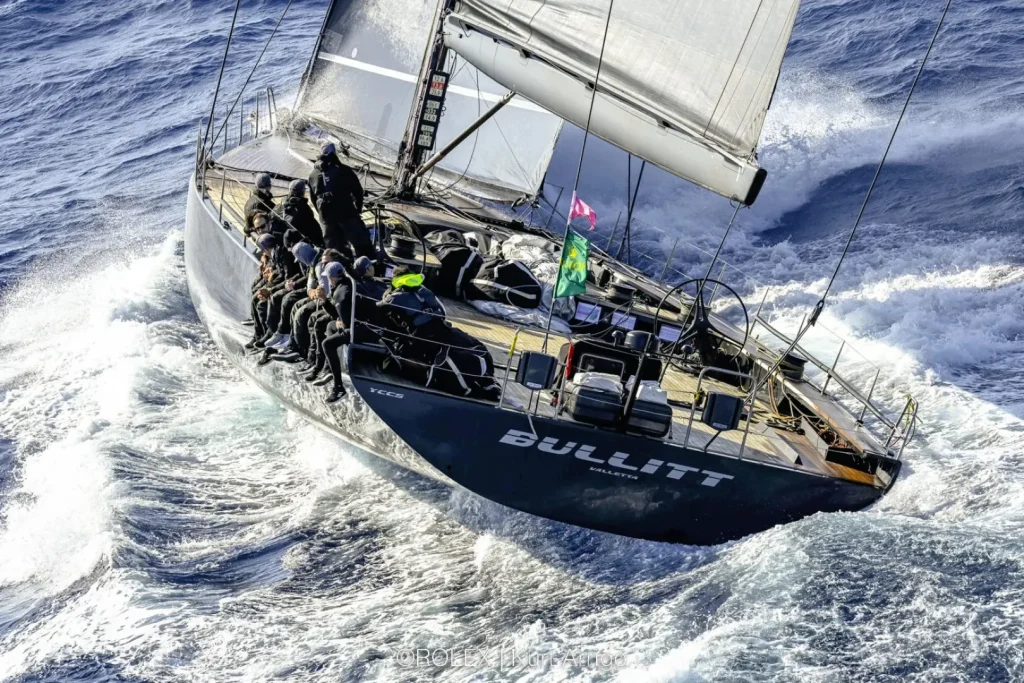
Classes and Types of Sailboats
Monohulls are the most common type of sailboats, consisting of a single hull that provides stability and balance. They come in various sizes and designs, depending on their intended use. Some popular monohull sailboats include the Optimist , Finn, and Sunfish, which are frequently used for racing and recreational sailing. Monohulls tend to have a deeper draft, requiring more water depth than their multi-hull counterparts.
Multihulls, also known as multi-hull sailboats, are a more modern innovation in sailing. They feature two or more hulls connected by a frame or bridgedeck. This design offers increased stability and speed over monohulls. Some common types of multihulls are catamarans (with two hulls) and trimarans (with three hulls). Due to their wider beam and shallower draft, multihulls are particularly suitable for cruising in shallow waters and provide more living space on board.
One-Design Sailboats
One-Design sailboats are a specific class of racing sailboats in which all boats are built to the same design specifications, ensuring that the competition focuses on the skill of the sailor rather than the design of the boat. These boats must adhere to strict rules and standards, with minimal variations allowed in terms of hull shape, sail area, and rigging. Some popular one-design sailboats include the Enterprise and the aforementioned Optimist and Finn sailboats.
Dinghies and Skiffs
Dinghies and skiffs are small, lightweight sailboats that are often used for sailing classes, short-distance racing, or as tenders to larger boats. Dinghies usually have a single mast with a mainsail and sometimes a small jib. Some popular types of sailing dinghies include the Optimist, which is specifically designed for children, and the versatile Sunfish sailboat. Skiffs, on the other hand, are high-performance sailboats primarily used for racing. They have a larger sail area relative to their size and typically include features such as trapezes and planing hulls, which allow for faster speeds and greater maneuverability.
In conclusion, there are various classes and types of sailboats, each with its own unique features and characteristics. From the simplicity of monohulls to the stability and speed of multihulls, and from the fair competition of one-design sailboats to the excitement of dinghies and skiffs, there is a sailboat to satisfy every sailor's preferences.
Sailboat Size and Use
When exploring the world of sailboats, it's important to understand their different sizes and purposes. Sailboats can be categorized into three main types, each with unique characteristics and uses: Day Sailers , Racing Sailboats, and Cruising Sailboats .
Day Sailers
Day Sailers are small sailboats typically ranging from 10 to 24 feet in length. These boats are perfect for short sailing trips and are easy to maneuver for beginners. They have limited accommodations on board, providing just enough seats for a small group of people. Some popular day sailer models include the Laser, Sunfish, and Flying Scot. Lightweight and agile, Day Sailers are often used for:
- Recreation: casual sailing or exploring nearby waters with family and friends
- Training: beginner sailing lessons or practicing sailing techniques
- Competition: local club races or interclub regattas
Racing Sailboats
Racing Sailboats are designed to provide maximum speed, maneuverability, and efficiency on the water. Sizes may vary greatly, from small dinghies to large yachts. Key features of racing sailboats include a sleek hull shape, high-performance sails, and minimalistic interiors to reduce weight.
Career racers and sailing enthusiasts alike participate in various types of racing events , such as:
- One-design racing: all boats have identical specifications, emphasizing crew skill
- Handicap racing: boats of different sizes and designs compete with time adjustments
- Offshore racing: long-distance racing from one point to another, often around islands or across oceans
Cruising Sailboats
Cruising Sailboats are designed for longer journeys and extended stays on the water. They typically range from 25 to 70 feet in length and provide comfortable accommodations such as sleeping cabins, a galley, and storage spaces for supplies and equipment. Sailing cruisers prioritize stability, comfort, and durability for their voyage.
Here are some common types of cruising sailboats:
- Cruiser-racers: These boats combine the speed of a racing sailboat with the comfort and amenities of a cruising sailboat. They are ideal for families or sailors who enjoy participating in racing events while still having the option for leisurely cruises.
- Bluewater cruisers: Designed for handling the world's most demanding ocean conditions, bluewater cruisers are built with a focus on sturdy, self-reliant sailboats that can withstand long-distance voyages and challenging weather conditions.
- Multihulls: Catamarans and trimarans are gaining popularity in the cruising world for their typically more spacious interiors and level sailing characteristics. With two or three hulls, multihulls offer high levels of stability and speed for a comfortable cruising experience.
Understanding the differences between various sailboat types will help potential sailors select the perfect vessel for their sailing goals, skills, and preferences. Day Sailers, Racing Sailboats, and Cruising Sailboats each have their unique features, catering to distinct uses and sailing experiences.
Advanced Sailboat Features
Sailboats have evolved over time, and many advanced features have been developed to enhance performance and safety. In this section, we will discuss some of the key advanced features in modern sailboats, focusing on performance enhancements and safety/navigation.
Performance Enhancements
One critical component that impacts a sailboat's performance is the type of keel it has, which affects stability, resistance, and maneuverability . There are several kinds of keels such as fin keel , wing keel , and bulb keel . Fin keels offer low drag and high efficiency, making them suitable for racing sailboats. On the other hand, wing keels provide better stability at low speeds, while bulb keels provide a lower center of gravity to enhance overall stability and comfort during long voyages.
Another feature that contributes to a sailboat's performance is its sails and rigging. The jib is a triangular sail at the front of the boat, which helps improve its upwind performance. More advanced sailboats use a combination of shrouds , which are the supporting cables running along the sides of the boat, and stays , the cables that help hold the mast in place, to create a stable and efficient rigging system.
A sailboat's performance can also be influenced by the presence of a centerboard or daggerboard , which can be adjusted to optimize stability, maneuverability, and speed. When racing or navigating in shallow waters, retractable centerboards and daggerboards are particularly useful as they provide better performance and versatility.
Safety and Navigation
Safety and navigation onboard a sailboat relies on a combination of advanced gear and equipment. A modern sailboat is usually equipped with:
- GPS and chartplotters to assist with navigation and planning routes
- VHF radios for communication with other vessels and authorities
- Radar to detect obstacles, weather systems, and other vessels
- AIS (Automatic Identification System) which helps monitor nearby vessel traffic
The design of a sailboat's hull, rigging, sails, and hardware also contribute to its safety. The boom , the horizontal pole that extends the sail, should be properly secured and designed to avoid accidents while sailing. The keel , whether it's a fin, wing, or bulb keel, plays a vital role in the overall stability and safety of the sailboat. The choice of keel should be based on the intended use of the sailboat and the prevailing sailing conditions.
In summary, advanced sailboat features significantly improve the performance, safety, and navigation capabilities of modern sailboats. Innovations in keel design, rigging systems, and onboard navigational equipment have undoubtedly contributed to the overall enjoyment and safety of sailing.
Sailboat Ownership
Buying Considerations
When considering buying a sailboat , it is important to understand the different types of sailboats available and the purpose each serves. Sailboats can be broadly categorized into three types:
- Racing sailboats: Designed for speed and performance, with minimalistic interiors and advanced sail systems.
- Cruising sailboats: Built for comfort and longer trips, featuring more spacious interiors and amenities.
- Daysailers: Smaller, easy-to-handle boats that are often used for short trips and recreational sailing.
Prospective boat owners should consider factors such as boat size, type, budget, and intended use (solo vs. family sailing, charter operations, etc.). It's also essential to evaluate the availability of necessary gear and the level of experience required to handle the chosen sailboat.
Maintenance and Upkeep
Sailboat ownership involves maintenance and upkeep to ensure the boat remains functional, safe, and holds its value. Some common maintenance tasks include:
- Hull cleaning and inspection: Regularly inspect the hull for damages and clean off any growth to maintain performance and fuel efficiency.
- Antifouling paint: Apply antifouling paint to prevent marine organisms from attaching to the hull, which can negatively impact the boat's performance.
- Engine maintenance: Check and replace engine oil, inspect cooling and fuel systems, and clean or replace air filters.
In addition to regular maintenance, sailboat owners should also be prepared to replace or repair critical systems and components, such as:
- Sails: Monitor the condition of your sails and replace them as needed to maintain performance and safety.
- Rigging: Regularly inspect and maintain the standing and running rigging, and replace worn or compromised parts.
- Electronics and instruments: Ensure navigation systems, radios, and other electronic equipment are functioning properly.
Taking proper care of a sailboat can be time-consuming, and some owners may choose to charter their boats when not in use as a way to offset ownership costs. Others may opt for hiring professionals to manage routine maintenance, particularly when sailing solo or with limited sailing experience.
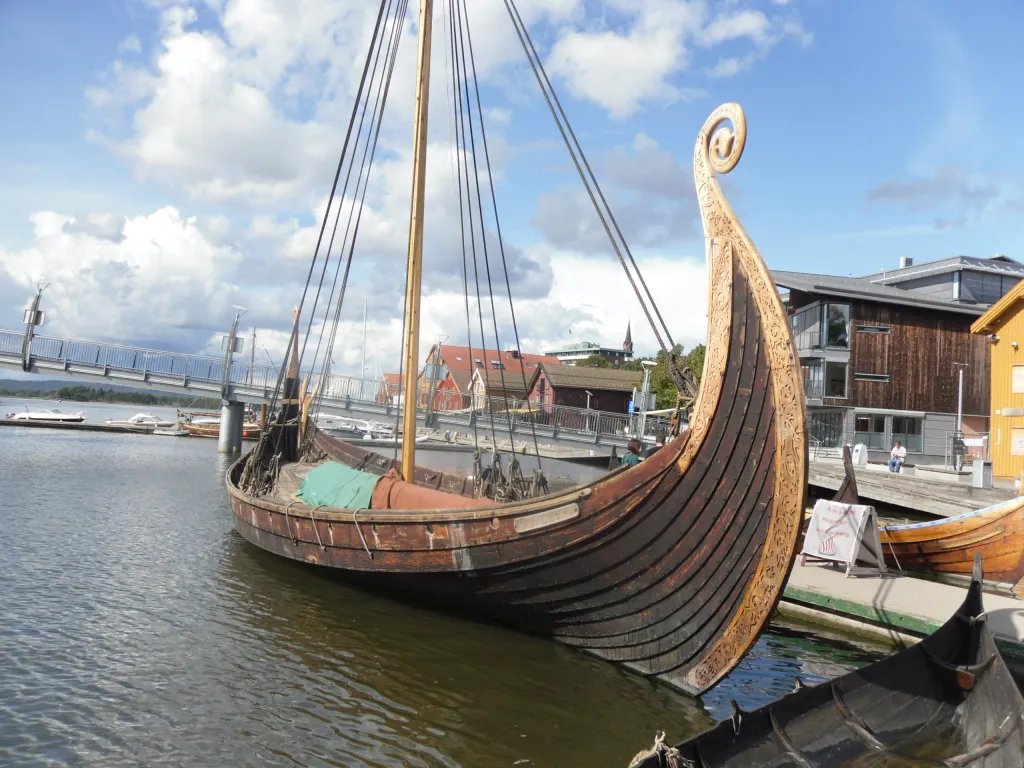
Historical and Special Sailboats
Tall ships and gaffers.
Tall Ships are large, traditionally rigged sailing vessels with multiple masts, typically square-rigged on at least one of their masts. Some examples of these ships include the clipper, brig, and square-rigged vessels. The clipper is a fast sailing ship known for its sleek hull and large sail area, while the brig features two square-rigged masts. Square-rigged ships were known for their impressive sail area and could cover large distances quickly.
Gaffers are a subset of historical sailing vessels with a gaff mainsail as their primary sail type. This gaff-rig is characterized by a spar (pole) that extends the top edge of the mainsail, giving it a quadrilateral shape to optimize wind coverage. Gaff mainsails were commonly used in England and influenced the development of other sailing vessels.
Classic and Antique Sailboats
Classic and antique sailboats refer to older, traditionally designed sailing vessels that have been preserved or restored. They often feature wooden construction and showcase a variety of rigging types, including gaff rigs and square rigs. These historical sailboats have unique designs, materials, and techniques that have since evolved or become rare.
Here are some examples of antique and classic sailboats:
- Sloop : A single-masted sailboat with a Bermuda rig and foresail
- Cutter : A single-masted vessel with a similar rig to the sloop, but with additional headsails for increased maneuverability
- Ketch : A two-masted sailboat with a smaller mizzen mast aft of the main mast
In summary, historical and special sailboats encompass a wide range of vessel types, from large, multi-masted tall ships to smaller, single-masted gaffers and classic sailboats. These vessels reflect the rich maritime history and the evolution of sailing techniques and designs over time.
Sailboat Culture and Lifestyle
Sailboat culture and lifestyle encompass a variety of aspects including racing events, leisurely cruising, and exploring new destinations. The main types of sailboats include racing yachts, cruising sailboats, and motorsailers, each offering a unique experience for sailors.
Regattas and Racing Circuits
A popular aspect of sailboat culture involves participating in regattas and racing circuits . These events create a competitive atmosphere and develop camaraderie among sailors. Racing sailboats are specifically designed for speed and agility , and sailors often team up to compete in prestigious races such as the Rolex Sydney Hobart Yacht Race or the America's Cup. Yacht clubs play an essential role in cultivating this competitive sailing environment.
Sailboat Charter and Tourism
Another facet of sailing culture is the sailboat charter and tourism industry, which allows people to experience the cruising lifestyle without owning a sailboat. Charters are offered for various types of sailboats, from family-sized cruising vessels to luxurious superyachts . Yacht sailing provides tourists with a unique travel experience, as they can explore diverse destinations, immerse themselves in local cultures, or simply relax on the open water.
Cruising sailboats are designed to provide comfortable living spaces and amenities, making them perfect for longer journeys or exploring remote destinations. Motorsailers, on the other hand, are equipped with both sails and engines, offering versatility and convenience for sailors.
Some popular sailing destinations include the Caribbean, Mediterranean Sea, and the South Pacific. These regions offer beautiful scenery, rich cultural experiences, and ideal sailing conditions.
The sailboat culture and lifestyle attract individuals who enjoy adventure, exploration, and camaraderie. From competitive racing events to leisurely cruising vacations, sailing offers diverse experiences that cater to a wide range of interests.
Frequently Asked Questions
What are the distinguishing features of different sailboat classes?
There are various sailboat classes, each with its own distinguishing features. Monohulls, for example, are the most common type of sailboat and have a single hull. Multihulls, such as catamarans and trimarans, have two or three hulls, respectively. These differences in hull design often affect the boat's stability, speed, and maneuverability.
Which sailboat types are best for novice sailors?
Novice sailors often benefit from starting with smaller, more manageable boats. Sailing dinghies and daysailers are popular choices due to their simple rigging and ease of handling. These boats typically have a single mast and a limited number of sails, making them ideal for beginners to learn sailing basics.
What are common types of small sailboats ideal for day sailing?
For day sailing, small sailboats such as sailing dinghies, day sailers, and pocket cruisers are ideal options. These boats usually range between 12 and 25 feet in length and offer simplicity, ease of handling, and portability. Examples of common day sailing boats include the Sunfish, Laser, and O'Day Mariner.
How do the purposes of various sailboat types vary?
Sailboats serve different purposes based on their design, size, and features. Daysailers and dinghies are ideal for short trips, sailing lessons, and casual outings. Racing sailboats, with their lighter weight and streamlined design, are built for speed and competition. Cruising sailboats, on the other hand, are designed for longer voyages and often include living quarters and additional amenities for comfortable onboard living.
What is considered the most popular class of sailboat for recreational use?
The most popular class of sailboat for recreational use often varies depending on individual preferences and local conditions. However, monohulls are commonly preferred due to their widespread availability, versatility, and affordability. Within the monohull class, boats like the Sunfish, Laser, and Catalina 22 are popular choices for their ease of use and adaptability to various sailing conditions.
Could you describe a sailing dinghy designed for two people?
A two-person sailing dinghy typically has a simple rig with a single mast and one or more sails, making it easy to handle for both experienced and novice sailors. The RS Venture , for example, is a popular choice for two-person sailing. It features a spacious cockpit, durable construction, and simplicity in its rigging and control systems. These characteristics make it an excellent option for recreational sailing, training, and even racing.
Related Articles

Bassboatcentral: The Ultimate Hub for Bassboat Enthusiasts and Connections

Deepest Part of the Ocean: Exploring the Abyssal Zone Secrets

Boating Tubes: Ultimate Guide for Thrilling Water Adventures

Boat Blue Book Value: Comprehensive Guide for Accurate Assessments
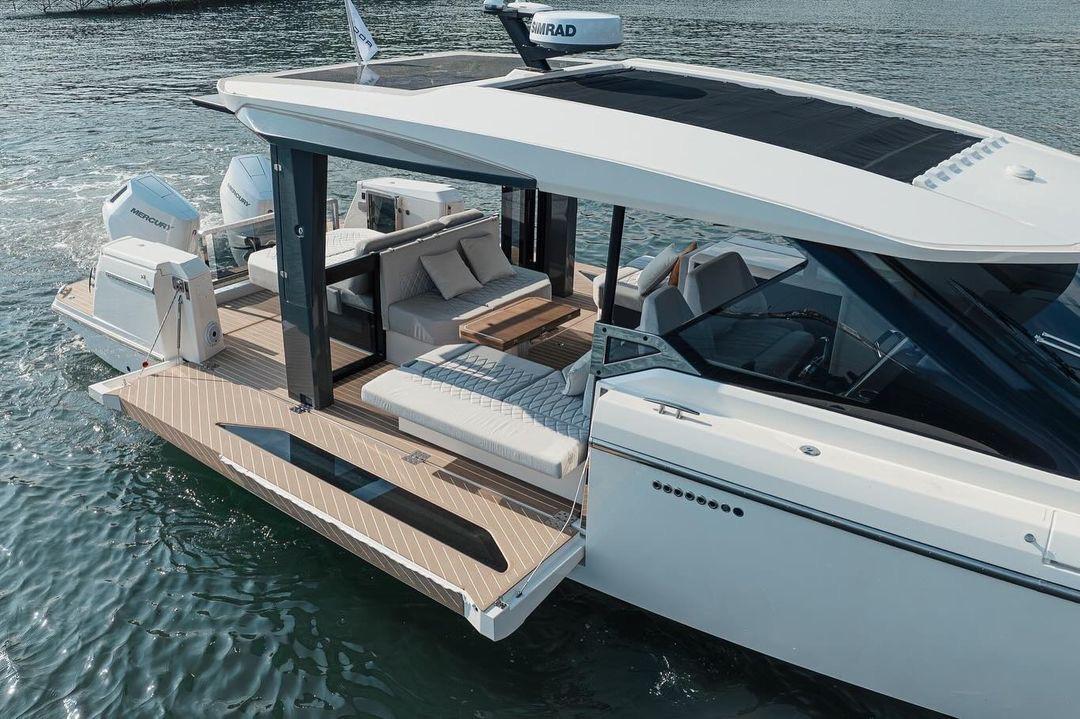
Saxdor 400 GTC- Price Breakdown: Unveiling True Value and Features
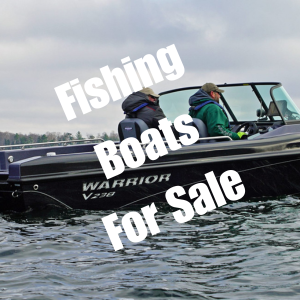
Fishing Boats for Sale: Expert Guide to Top Choices

De Antonio Yachts: Exploring Luxury and Innovation on the Water
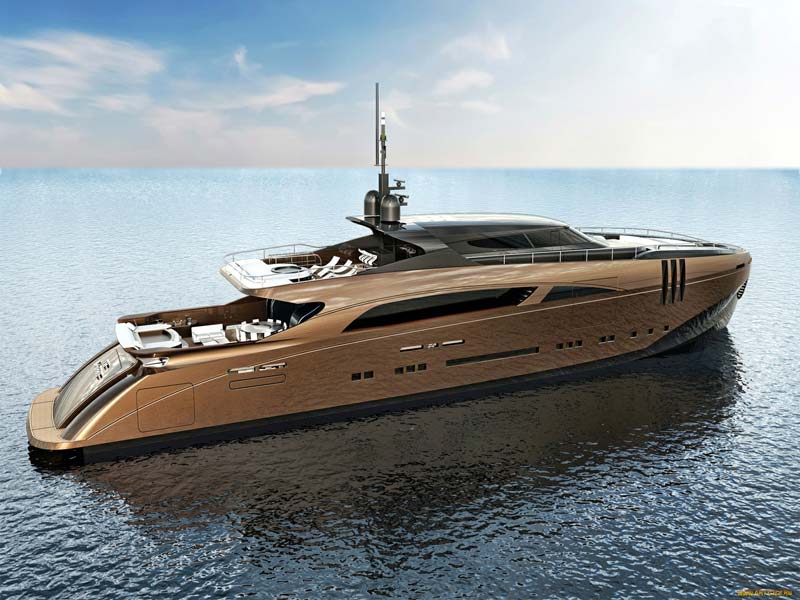
History Supreme Yacht Most Expensive: Exploring the Ultimate Luxury Vessel

My Cruiser Life Magazine
Sailboat Types: Full-Guide
For generations, sailing has been a mode of essential transportation, a rewarding hobby, an active and competitive sport, and a lifestyle. Sailing appeals to all, and there are dozens and dozens of types of sailboats.
Small sailboats are perfect for kids to sail on, and massive sailboats are used to cross oceans in style. In between, there are daysailers, racers, and cruisers.
Table of Contents
- What Does a Sailboat Look Like?
Small Sailboats
Cruising boats, cruising catamarans, cruising trimarans, full keel boats, fin keel boats, centerboard keel.
- Hydrofoil Sailboats
A Purpose for Every Type of Sailboat
Faqs (frequently asked questions).
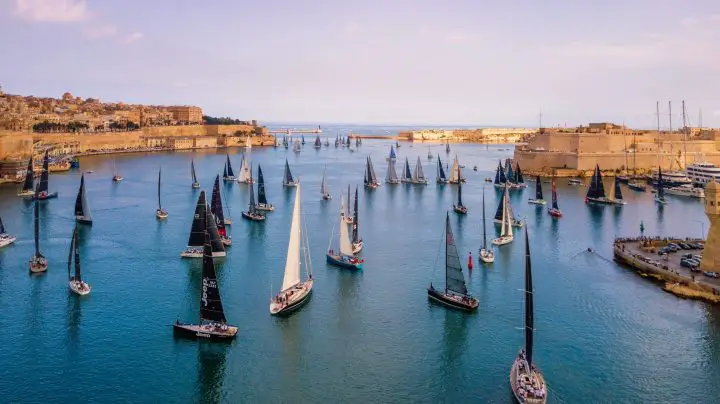
What Are Sailboat Types?
Sailboats are boats that are propelled by the wind. Sailboats use wind power instead of a motor or oars to move the boat. It should be noted, though, that nearly all modern sailboats have a motor as well. It comes in handy when docking in tight marinas and if the wind dies!
A sailboat has one, two, or three hulls. It has at least one mast, or tall vertical spar, that holds up one or more sails. The sails harness the power of the wind to move the boat forward.
To get started, here are some sailing boat types and terms to give you an idea of the sorts of boats that are out there.
- Dinghies — a small open boat, usually for only one or two people
- Daysailors — boats designed to go out for a day trip
- Cruising Sailboats — boats designed to travel long distances that have accommodations for their crew to live aboard a long term
- Sloop — the most common type of sailboat, with one mast and two sails (a jib and a mainsail)
- Ketch, yawl, or schooner — types of sailboats with two or more masts
- Monohull — a boat with only one hull
- Catamaran — a boat with two equal-sized hulls in the water that are connected together by a bridge deck
- Trimaran — a boat with three hulls in the water, the center of which is much larger than the outer two
What Does a Sailboat Look Like?
There are many different types of sailboats, so they look a little different from each other. The basics, however, are the same.
Each sailboat has at least one hull that sits in the water. Part of the hull is visible above the waterline. Part of the sailboat hull sits below the waterline.
The part beneath the waterline might be relatively small, or it can be quite large. The rudder, the mechanism used to steer the boat, is also underwater.
The cockpit is where the helmsperson sits and steers the boat. On small boats, the cockpit takes up the entire boat. Cruising boats have interior accommodations as well as a safe cockpit.
Sailboats have at least one mast and at least one mainsail. As you get to know the different types of sailboats, you’ll see many different hull and sail configurations.
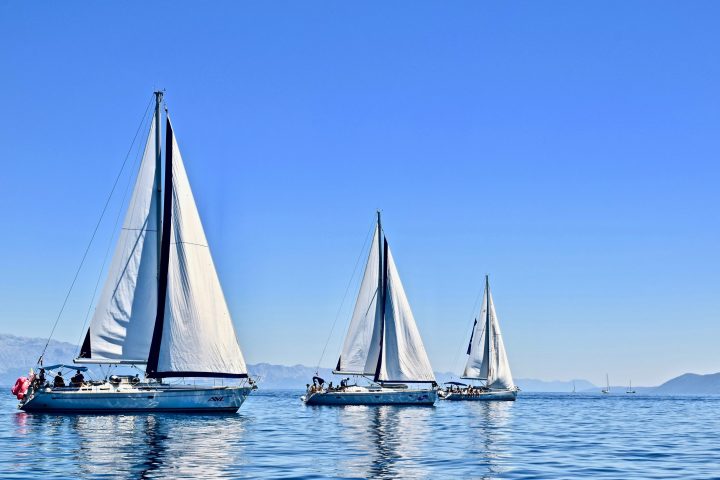
Different Types of Sail Boats
Sailboats come in all types of sailboat shapes and sailboat sizes . Sailboats can be classified by their hull shape, size, or sail plan. The sail plan is how many sails they carry on how many masts.
Hull shapes include monohulls, catamarans, trimarans, and sailing hydrofoils. A monohull has just one hull, a catamaran has two hulls, a trimaran has three hulls, and a hydrofoil lifts out of the water.
Sizes range from eight-foot sailboats to megayachts that are hundreds of feet long. Some sailboats are so small they are only suitable for one child who wants to go skimming across the lake. The largest pure sailing yacht in the world is the Black Pearl at 350 feet long (106.7 meters) long. Visit our Yacht vs Sailboat guide for a more definitive difference between the two and their sizes.
Sailboats also have different sail configurations or sail plans. For example, a sailboat with just one big sail on a forward-mounted mast is called a catboat. A boat with dozens of different sails on three masts is called a three-mast schooner.
Small sailboats are extremely popular and offer a lot of fun to the young and old. Most of the time, these boats are just used for daytime use in pleasant weather conditions. Kids often learn to sail in small monohull sailboats. Families might go for a picnic in a Hobie catamaran.
Yacht club members might race their 16-foot daysailors, while adventurous souls might take their 19-ft weekender and anchor in a calm cove for the weekend.
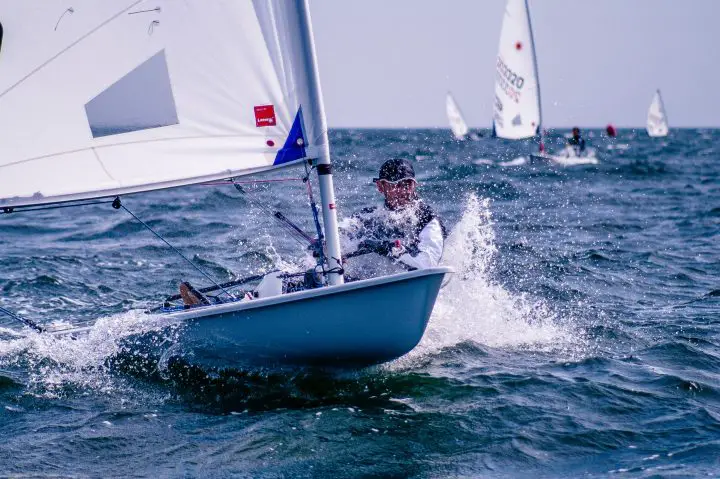
What is a Small Sailboat Called?
Small sailboats have different names, depending on the type of sailboat and the number of sail boat hulls. For example, the boat might be a monohull dinghy, small catboat, small catamaran, or daysailor.
Additionally, like every car on the road, every boat on the water is identified by its make and model. In small boats that are commonly raced, a certain make and model may set up a class of racing boats. Class racing means that all of the boats are identical, so the race is based solely on the skills of the skippers.
Sailing Dinghies
Kids and adults often learn to sail on sailing dinghies. Sailing dinghies can be as small as eight feet long. This small size makes it easy for kids to handle.
Some common sailing dinghies are Optis, Lasers, and Sunfish.
This size sailboat is also functional. They can be used to ferry sailors from their larger anchored boats to shore. The small size also helps sailors easily store their dinghy on larger boats. The word dinghy is often used to refer to any small boat used as a tender for a larger vessel, even if the tender is a motorboat.
Cat Rig Boats
A cat rig boat, or cat boat, is a type of sailboat that usually just has one large mainsail and a forward-mounted mast. Many smaller dinghies and training boats are catboats. A catboat has a free-standing mast with no standing rigging.
Small Catamarans
A catamaran is a boat with two hulls. The Hobie brand is synonymous with small catamarans, which are popular with families looking for a fun hobby. Hobie Cats are seen on the sand at beach resorts all over the world—they’re safe, fun, and fast.
Catamarans are faster than monohulls, and these boats are fun to race. Small catamarans are often used by families that live on the waterfront. Their lightweight makes them easy to drag to the waterfront and launch.
Small catamarans are also popular on beaches. Many beach resorts offer Hobie cats for rent. Small catamarans are between 12-20 feet in length. The hulls are joined only with spars and netting, so these fast and light open boats are not set up to carry a lot of people or supplies.
Daysailors are the ultimate fun boat. As the name implies, this type of sailing boat is used for day sailing. These boats are usually between 12 to 20 feet long. Some use these smaller boats for racing or overnight camping, but most sailors use daysailors for a leisurely sail.
Small Sailboats with Cabins
While most small sailboats just have a large open cockpit, several small yacht types have cabins. These cabins offer a chance for sailors to use a porta-potty or get out of the sun. Some small sailboats even have sleeping accommodations for overnight stays.
An excellent example of this is the Cape Dory Typhoon Weekender. This small sailboat is known as “America’s Littlest Yacht.” Down below, there are two small bunks for sleeping and enough space to have a small stove and a porta-potty. Most owners don’t stay aboard long-term, but the cabin is a useful place to stow items while sailing or to hide during a rainstorm.
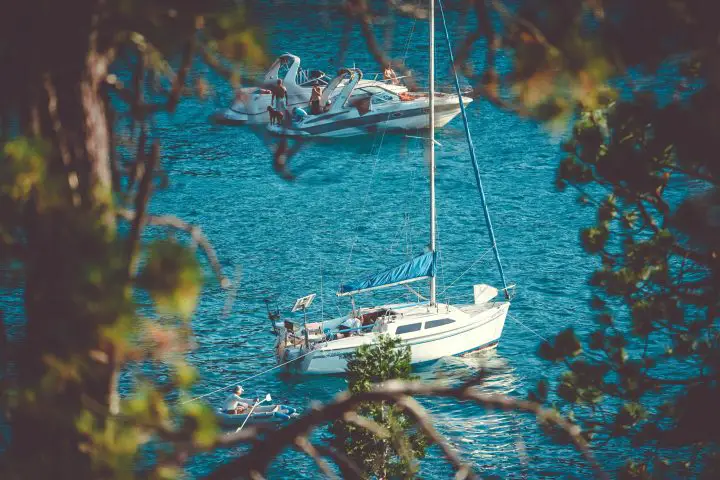
Cruising boats are boats that are capable of traveling long distances. Cruising boats have sleeping accommodations, cooking facilities, and bathroom facilities. These boats are like RVs for the waterway.
Cruising boats offer sailors the chance to live on their boats while sailing. Like RVs, cruising sailboats travel to different ports of call. Cruising sailboats are one of the more popular types of sailing boat. They offer adventurous sailors the chance to enjoy sailing as a sport while seeing new things.
Cruising boats are usually 30 to 50 feet long. Most cruising couples prefer a boat that is around 40 feet long since this provides enough space to live comfortably and enough storage space for all of their gear.
Monohulls are very popular cruising boats. These boats offer good storage, are safe, and are easy for a couple to handle together. Monohulls have different types of sail configurations.
Cruising Bermuda Rigged Sloops
Most monohulls are Bermuda rig sloops. This sail plan features one mast with a mainsail and a headsail. Bermuda rig sloops are easy to single-hand and very versatile. How many sails does a sloop have? A Bermuda sloop flies two sails at a time, which are the mainsail and a headsail.
However, the boat might have other sails onboard. For example, the captain might take down the jib in light winds and use a bigger genoa to capture more wind power. During a downwind sail with light winds, the captain might rig a large spinnaker, which looks like a huge kite, to keep sailing even in little wind.
Even within the sloop category, there are many variations in the design. A masthead sloop is one whose forestay (headsail) goes all the way to the top of the mast. In contrast, a fractional sloop’s forestay connects at some point lower. So a 3/4 fractional rig has a headsail that only goes up three-quarters of the way to the top.
Riggers and boat designers have a lot of tools in their toolbox from which they can make a boat faster or more user-friendly. The type of rigging and sail plan a boat is equipped with offers it performance improvements as well as functionality.
Cruising Cutter
A cutter is a sailboat with one mast, one mainsail, and two sails forward of the mast. The sail at the front of the boat is the jib, genoa, or yankee depending on its size and cut. The next sail in, the inner headsail, is called the staysail. Island Packets are popular boats with this sail plan.
Cutters are popular choices as cruising and bluewater cruiser boats because the staysail provides the skipper with many different sail options. They could fly all three sails fully, or they could fly a small partial mainsail and just the staysail for heavy winds.
Cruising Ketch With Mizzen Sail
Some cruising monohulls are ketches. A ketch can be easily identified by its two masts. The forward mast is the main mast with a mainsail. The aft mizzen mast is shorter and has a mizzen sail. This sail plan can make it easier to carry a big sail area and configure the sails for various sailing conditions.
A boat with more than one mast is called a split rig because the rig is split between two shorter masts instead of all mounted on one tall one. The advantage of a split rig is that there are more sails, each of which is smaller. That makes them easier to handle, and important consideration when you are sailing alone or with only one other person.
Cruising Yawl
A yawl is similar to a ketch and has two masts. However, the mizzen mast on a yawl is aft of the rudder post, whereas it is forward of the rudder post on a ketch. This mizzen mast location is even further back than a ketch’s. Yawls are one of the less popular types of sailboats. However, like the ketch, they offer diverse sail options and can keep sailing in many different types of weather.
On both ketches and yawls, the mizzen mast is shorter than the main mast. If the two masts are of equal height, or the forward mast is shorter, then you are looking at a schooner.
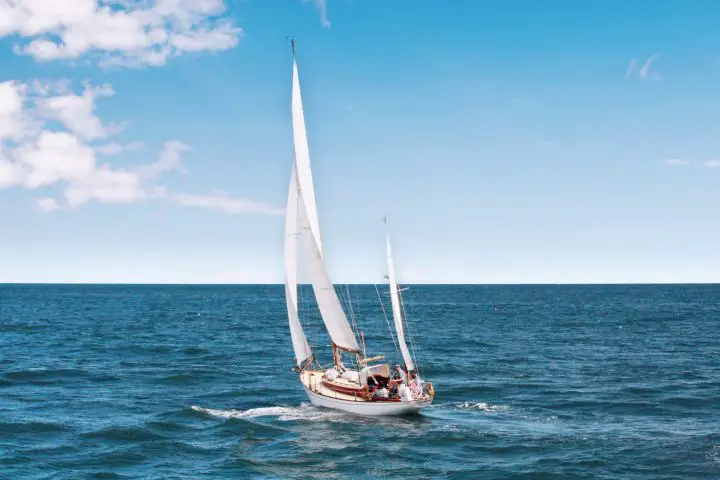
Cruising catamarans are one of the most popular classes of sailboats right now. This type of sailing boat has two hulls and offers sailors speed, space, and comfort. A cruising catamaran is usually between 40 and 60 feet long and 20 to 30 feet wide. The additional width offers cruise sailors huge amounts of space.
Cruising catamarans have excellent storage space and ample living accommodations if you intend to living on a boat . These boats are popular with couples and families and are often used to sail around the world on circumnavigations.
Cruising catamarans are usually fractional sloop rigs. They have one mast, a large mainsail, and a jib or genoa. In general, these boats are designed to be easy to sail and minimize complications.
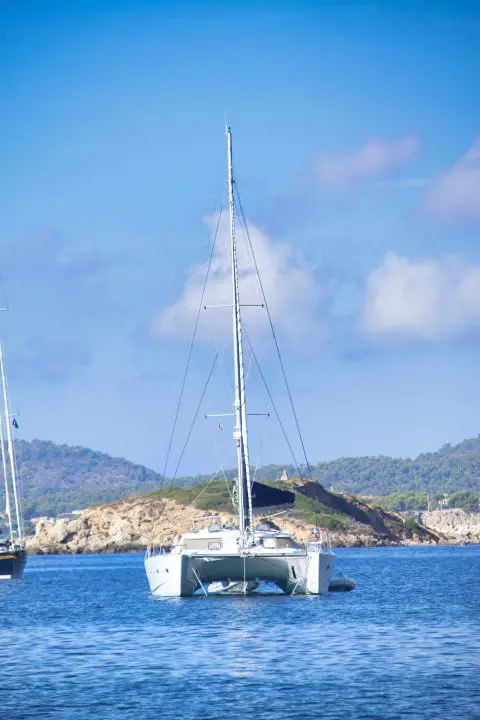
Trimarans are a type of sailboat with three hulls. Trimarans are known to be fast and are popular with racing sailors. However, they are also gaining popularity as cruising boats. These boats usually have fewer accommodations than cruising monohulls and catamarans. However, more modern trimarans like the Neel Trimaran have luxurious living spaces.
Types of Keel
Another way to classify the different types of sailing boats is by looking at the boat’s keel type. You can easily get an idea of different keel designs by walking around a boatyard. When a sailboat is in the water, it is hard to tell the shape of its keel.
The keel is the bottom part of the hull and is underwater. The keel is structurally essential. The keel’s weight helps the boat sail evenly and uprightly. The force created by the water moving over the keel counteracts the effects of the wind on the sails.
So a keel does two jobs for a sailboat. First, it provides a force that allows a sailboat to sail into the wind. Second, it provides stability. If storm-force weather conditions cause a monohull boat to roll, the weight in the keel will help the boat right itself.
Many older cruising boats had full keels. The keel shape runs the entire length of the boat. A full-keel boat is strong and easy to manufacture. Full-keel boats often have deeper drafts. The boat’s draft refers to the amount of water it needs to float. Full-keel boats can’t go into the shallow anchorages that catamarans or swing-keel boats can access.
Captains often report that full-keel boats are harder to maneuver in tight places such as marinas. Full-keel boats lack quick maneuverability. They have a reputation for being slower than more modern designs, but they make up for this by providing a very comfortable and safe ride in rough weather.
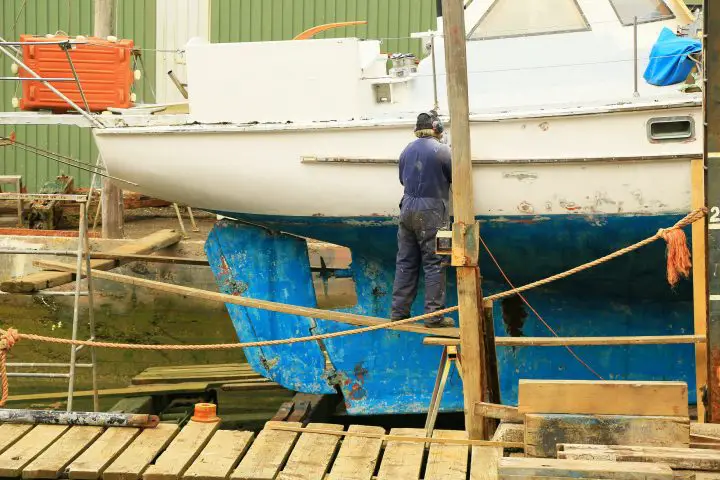
A boat with a fin keel has a smaller underwater profile than a boat with a full keel. This smaller keel resembles a fish fin. Captains find fin keel boats easier to maneuver. Fin keels use their shape to create very effective forces underwater. That makes them very good at countering the forces on the sails, meaning that fin keels sail upwind very well.
A boat with a bulb keel has a torpedo-shaped bulb on the bottom of a fin keel. Bulb keels offer improved stability. Bulb keels have shallower keels than a fin keel boat. The bulb also lowers the center of gravity in the boat, making it more stable overall.
A wing keel features a keel with a small wing on either side of the keel. Viewed from above, the keel looks like it has a set of small airplane wings.
Similar to a bulb keel, wing keel boats often have a shallower draft than fin-keel boats. However, the additional shape causes drag and can reduce sailing performance in some circumstances.
A centerboard is common on small daysailors that are launched and retrieved from trailers. Deep keels make getting those boats in and out of the water difficult. By chopping off the keel, you can make a sailboat as easy to launch as a powerboat.
Related: Best Trailerable Sailboats
But of course, a sailboat needs to have a keel. A centerboard is a simple swinging fin keel that can be raised or lowered. This provides some excellent benefits if the sailor on board likes to explore areas with shallow water.
Many bigger boats have centerboards, too. A boat with a centerboard can be seen as the best of both worlds. A centerboard boat has a fixed shallow draft keel. However, the captain can deploy the centerboard when sailing in deeper waters. The centerboard adds depth to the keel and offers increased stability and performance.
A modification of the centerboard is the swing keel — a ballasted keel that can be retracted like a centerboard . These are rare. They’re used on large cruising boats where the crews want the option of accessing shallow waters. In England, this type of boat is used and can be dried out when the tide goes out.
Racing Sailboats
Yacht racing is a popular sailing sport. It’s a great way to get out on the water while competing. In fact, racing is a great way for sailors to hone their sailing skills. Sailors have to pay close attention to weather conditions and manage their sails effectively to maximize their speed.
Sailors can race any boat with sails. Kids race sailing dinghies against each other. Club racers sail daysailors or catboats. Catamarans and trimarans are also popular race boats. Several classes of boat races in the Summer Olympics.
Hydrofoil Sailboats
A hydrofoil is a unique and modern type of racing sailboat. A hydrofoil can be a monohull, catamaran, or trimaran. A hydrofoil has wing-like foils on the hull’s underside.
As the sailboat speeds up, the hydrofoils lift the hull out of the water, and the hydrofoil sailboat almost appears to be flying above the water.
Because the hull is now out of the water, drag, and resistance are minimal, and the sailboat can sail even faster. For example, a dinghy that usually goes four knots can accelerate to 12 knots when fitted with a hydrofoil.
Most hydrofoil sailboats are catamarans and trimarans. The added width of these multihull sailboats gives the hydrofoil sailboat more stability.
Traditional Sailboats
Traditional sailboats are the type of sailboats used to transport people and goods before modern transportation options were available. Before the railway, cars, and airplanes, a tall ship sailboat was used to ship cargo and people across oceans and from port to port.
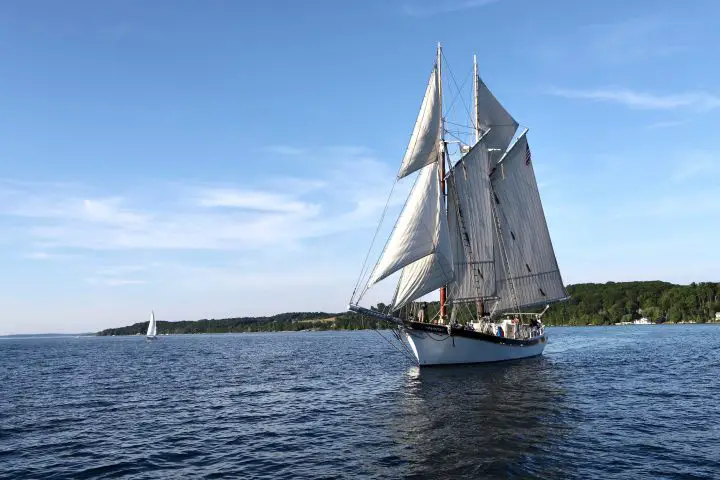
A gaff rig refers to the gaff, which is the upper spar on a square-shaped sail. Gaff rigs can be used with any mast configuration, but this feature is usually seen on traditional boats like a catboat, tall ship, or schooner.
A schooner has at least two masts. They are different from other mast configuration designs with two spars in that both masts are equal in height, or the forward mast is shorter. Schooners are faster than most traditional boats and were often used to transport perishable goods such as fruit.
Schooners were also popular race boats in the early 20th century. For example, first America’s Cup races were won by schooners.
Today, schooners are usually used as charters for vacations or youth sail training programs. But there are a few cruising boats out there that feature schooner rigs.
Any way you divvy it up, there are tons of different types of sailboats out there. With a little research and a little looking, you’re sure to find one that suits your style and boating plans.
What are the classes of sailboats?
Sailboat styles can be classified by hull type, use, or sail plan. The types of sailboat hulls include monohulls, catamarans, and trimarans. You can also categorize the kinds of sailboats by their use. For example, sailors use their boats for daysailing, cruising, and racing. Finally, different kinds of sailboats have different sail plans. A sailboat might be a sloop, ketch, yawl, catboat, or schooner. The term “classes” has a particular meaning in sailing, however. Class racing is the competitive racing between boats of the same make and model—boats of the same “class” or of “one design.” There are hundreds of different classes of sailboats out there. Some of the most popular classes include the Laser and Sunfish classes.
What is a small 2 person sailboat called?
A small two-person sailboat is a dinghy. These small boats are fun to sail on protected waters. Many kids learn to sail in a sailing dinghy. There are dozens of makes and models of sailing dinghies available, some are used in Olympic sailing racing while others are just rowboats with sail rigs attached.
Matt has been boating around Florida for over 25 years in everything from small powerboats to large cruising catamarans. He currently lives aboard a 38-foot Cabo Rico sailboat with his wife Lucy and adventure dog Chelsea. Together, they cruise between winters in The Bahamas and summers in the Chesapeake Bay.
Leave a comment
Your email address will not be published. Required fields are marked *
Save my name, email, and website in this browser for the next time I comment.
The Ultimate Guide to Small Boats: What Are Your Options?
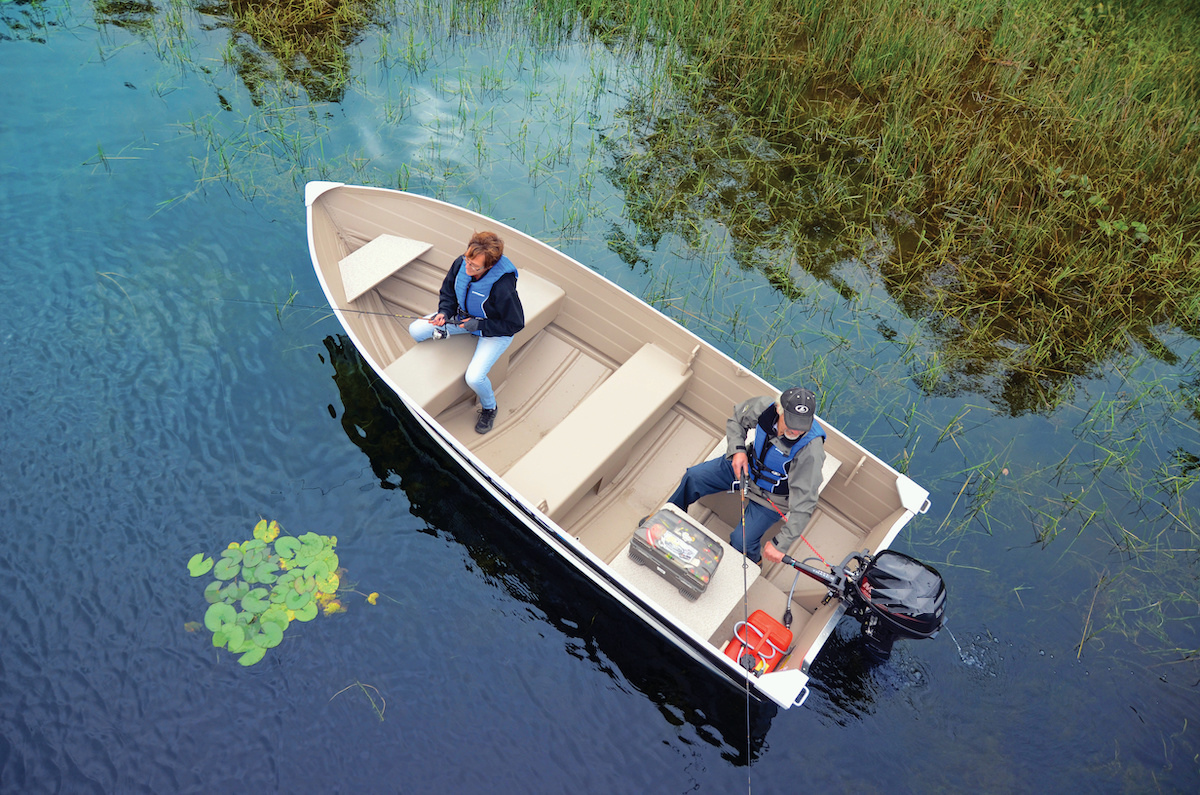
Small boats are where many people discover a love for the water, and if you’ve been browsing our Boat Finder Tool looking for small boats that would be ideal for your needs, you’ve surely encountered many options.
Small boats are less expensive to buy and operate than large ones, are easier to tow or load on a trailer, and can sneak into tiny waterways that bigger boats can’t access.
Small boats also have an esoteric value that’s difficult to pin down. There’s something special about being physically closer to the water, surrounded by nature without all the extra tools and features found on larger, more complex boats.
In fact, many boat lovers who own large boats also have a small boat or two that they love and enjoy just as much as their bigger craft. But which small boats would be best for you? To make the search easier, we'll review the top 10 small boat contenders.
Types of Small Boats
Inflatable boats, aluminum fishing boats.
- Pontoon Boats
Car-Toppers
Canoes and kayaks, personal watercrafts (pwcs).
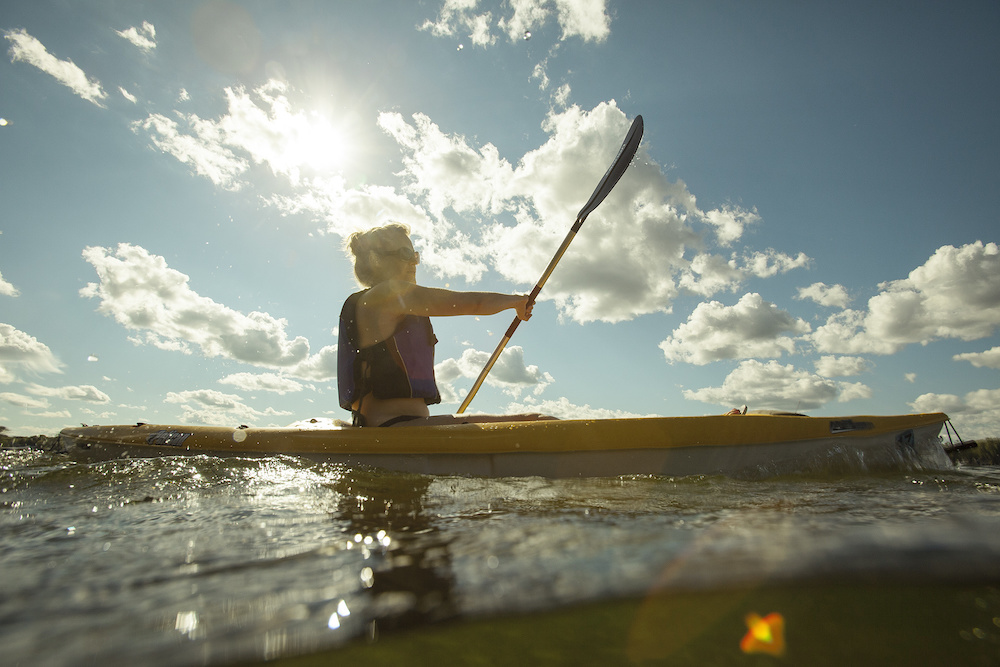
Jon Boats are among the simplest and most popular boats around. Many consist of little more than an aluminum hull with a flat bottom and a squared-off bow, bench seats, and an outboard or electric outboard engine. They’re incredibly easy to launch, load, and store and are among the least expensive options for buying a boat .
Skiffs are another form of very simple, basic, all-purpose utility boats. What exactly makes a boat a skiff? This is a catch-all term often used to describe any relatively small and open boat. Due to this, there’s an extensive range of candidates.
Dinghies come in many shapes and sizes and in different versions that can be rowed, motored, or sailed. But they all share a few common traits: they’re usually very small (eight or 10 feet is standard) and are often used as tenders to transport people and gear from a boat to shore.
Inflatable boats come in two basic styles: those that are completely inflatable and those that have a rigid hull surrounded by an inflatable “collar” or ring (usually called a “RIB,” short for rigid inflatable boat).
Most inflatables are made of materials like Hypalon or PVC fabrics. Their main advantage is the ability to bounce off anything they might hit. Still, RIB versions are also considered seaworthy and used in many commercial and search-and-rescue applications and for recreational purposes.
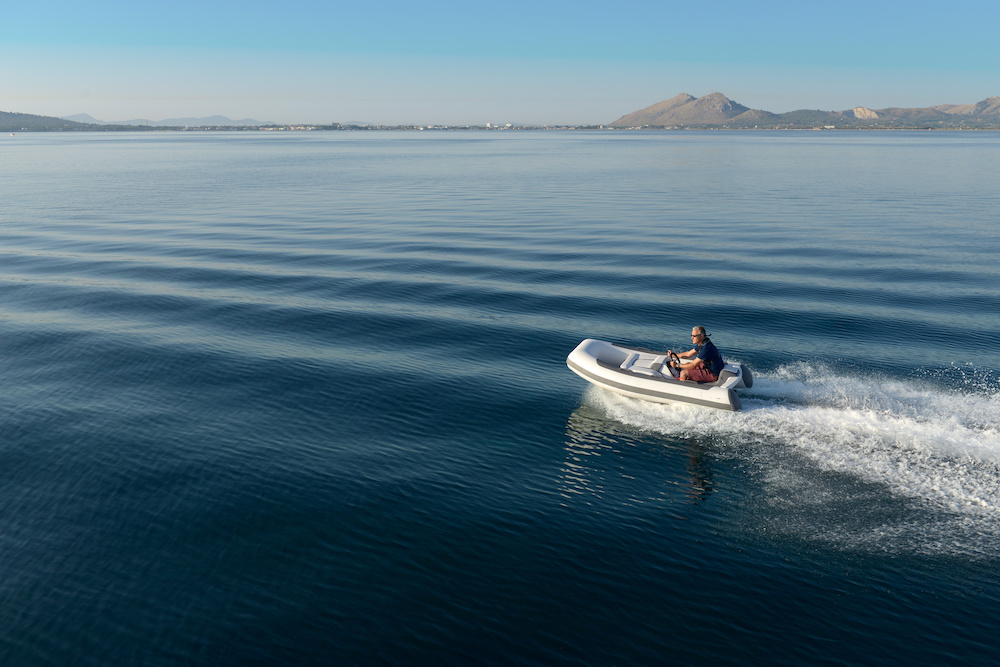
Aluminum fishing boats come in all shapes and sizes, the only common denominator being that they’re constructed of aluminum. Aluminum boats tend to be light, relatively inexpensive, and fuel-efficient.
Small Pontoon Boats
Although there are some very large and costly pontoon boats on the water, plenty of small models are available that are easy to trailer, easy to afford, and still get you a taste of luxury on the water. There are even different models and designs ranging from mini fishing pontoons to small performance pontoon boats.
Learn more in Buying a Pontoon or a Deck Boat?
This is another catch-all category of boat, with one common denominator: if a couple of people can lift it up and secure it to a roof rack on a car, the boat’s officially a car-topper. Usually, these are very small, simple boats, like Jon boats and dinghies.
These small crafts are popular, and even though most don’t have any mechanical propulsion, they’re still boats. In fact, there are some shockingly advanced models designed for specific purposes (such as fishing or maximum speed). Many boaters develop their initial love for the water while paddling or pedaling on a canoe or kayak.
While there are some large and rather complex jet boats , some small ones can be pretty thrilling to drive. Most have inboard jet engines that create thrust by blasting high-pressure water through a nozzle rather than spinning a propeller. However, there are outboard versions of jet engines, too.
Many people think of personal watercraft (PWCs) more like motorcycles of the water, which has led some to refer to them as waterbikes, or boatercycles. But despite their small size and limited passenger capacity, these are still boats in every sense of the word. They’re also among the most exciting to drive, and many are capable of neck-snapping acceleration, hair-raising high speeds, and exhilarating hairpin turns.
So—have you made up your mind as to which small boat you’d like to own? With all these options, it’s no surprise if you’re still trying to determine which one is right for you. No matter which ones you may be considering, however, one thing is a sure bet: whether it’s the only boat you have or it’s one of several in the family fleet, your love of the water is only going to grow when you spend time on your own small boat.
Read Next: Choosing the Right Boat Type for You
Editor’s Note: This article was updated in December 2022.
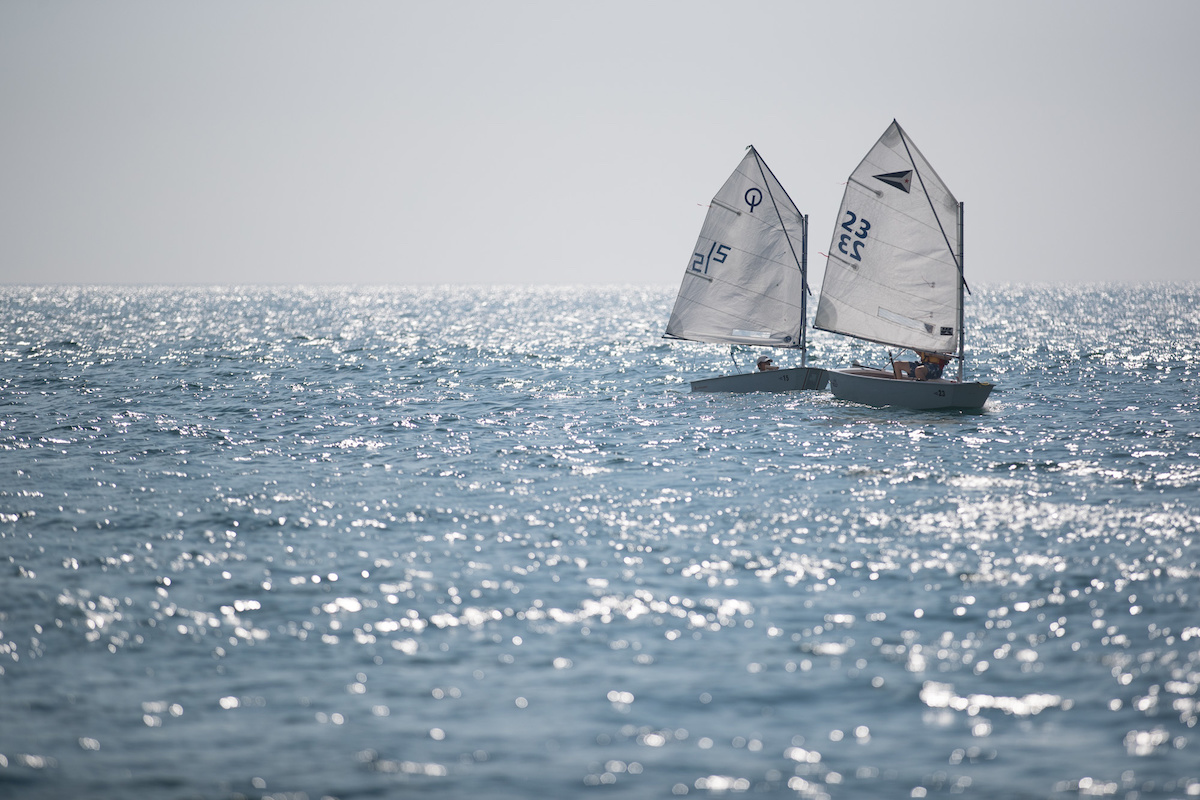
Join Our Newsletter!
Get community news, buying bargains, and how-to guides at your fingertips.
Discover the Best Types of Small Boats for Every Water Adventure
In the realm of miniature vessels, a unanimous chorus sings the praises of small boats. These compact aquatic conveyances hold sway with a multitude of compelling arguments .
- Initially , their allure stems from their cost-effectiveness, offering a wallet-friendly gateway to the aqueous wilderness.
- Secondly , their unparalleled ratio of time spent afloat to maintenance time sets them apart from their larger counterparts.
- Thirdly , their lightweight design and portability make them effortlessly reachable, truck-fittable, and stowable in remote alcoves.
- Lastly , they serve as exceptional tutors for honing boat handling proficiency, whether in the hands of the youthful or the mature; skills cultivated in small vessels readily translate to their larger brethren.
Amidst this favorable backdrop, the greatest appeal of small boats lies in the abundance of diverse options available. A cornucopia of small boat types caters to an array of aquatic activities . Even those with substantial vessels often keep a small counterpart on standby for specific tasks or when the grandiose boat's logistics prove daunting.
Which variety of small boats aligns with your aspirations ? The ensuing guide categorizes them into a dozen distinct genres, encompassing rowing dinghies, sailing boats, kayaks, and petite powerboats, to name a few.
📢Read also: Best Liveaboard Boats to Live On Full-Time
Types of Small Boats

Defining a precise threshold for small boats remains a subjective endeavor. However, consensus typically pegs them at under 30 feet in length and, in some circles, considerably shorter . Your ideal choice among small boats hinges on the intended aquatic pursuits and launch locations. Herein, an overview of the fundamental small boat types awaits your exploration.
Flat-Bottomed Jon Boats

Characterized by their aluminum construction, flat hulls, squared bows, outboard engines, and bench seating, Jon boats emerge as uncomplicated and economical options. Their simplicity extends to ease of launching, loading, and maintenance . The cost of the engine bolsters the affordability of these boats.
The Versatile Skiff

Skiffs, occupying the midrange in cost and complexity, beckon those seeking simplicity at a reasonable price. Typically featuring uncomplicated hulls, outboard engines, and seating, skiffs may sport center console helm stations in contemporary iterations . Maneuvering a boat proves relatively straightforward, with minimal maintenance requirements, and their compact size facilitates diverse launch locations.
Diverse Dinghies

The term " dinghy " encompasses various vessels, including sailboat racing classes. Dinghies generally measure up to 10 feet, though sail-equipped variants may extend to 15 feet or more. They derive propulsion from sails, motors, oars, or paddles and boast varied materials, such as fiberglass, aluminum, wood, or inflatable construction. Some serve as tenders for larger vessels, enabling access to shallow waters and shores .
Inflatable Options

Inflatable boats come in two primary forms. The first type is entirely inflatable and collapsible, allowing for convenient storage within larger vessels . The second variant combines a rigid fiberglass hull with inflatable sides. Inflatables span from 6 to over 40 feet, often serving as tenders for sailboats. Their versatility makes them adaptable to a range of scenarios.
Lightweight Aluminum Fishing Boats

Aluminum fishing boats excel in practicality, offering lightweight construction, ease of transport, and minimal upkeep. They typically cost less than their counterparts and exhibit commendable fuel efficiency . Lengths vary from 8 to 24 feet, with shorter models resembling Jon boats and longer versions boasting sophistication and speed.
💥See also: Best Catamaran Fishing Boat Brands 2024
Pontoons Boats

Pontoon boats come in diverse sizes and shapes, from compact fishing pontoons to performance-oriented cruisers. Ranging from 15 to 30 feet, they flaunt a spacious, flat profile accommodating numerous passengers . Affordability, easy trailering, and launch capabilities enhance their appeal.
👀Look at this: 12 Best Pontoon Boat Brands for Your Money in 2024

Canoes endure as a cherished traditional choice, celebrated for user-friendliness, low maintenance, and portability. These paddle-powered vessels navigate various shallow waters and typically accommodate multiple passengers . Canoes adopt diverse shapes, catering to speed enthusiasts, leisurely cruisers, and avid anglers alike.
The Modern Appeal of Kayaks

Modern kayaks garner popularity for many of the same reasons as canoes. Designed primarily for one or two occupants, kayaks propel through water with double-bladed paddles. Some feature enclosed cockpits, distinct from open-canoe designs . Innovations include foot pedal propulsion and submerged fins for efficient navigation.
Jet Boats for Thrills

Jet boats come to the fore for enthusiasts seeking exhilarating speed and maneuverability. Ranging from 14 to 24 feet, these vessels prioritize velocity and excitement . Jet engines generate thrust by directing high-pressure water through a nozzle, with options for both inboard and outboard configurations.
Personal Watercraft: Compact and Speedy

Personal watercraft, often known by brand names like Jet Ski, represent some of the smallest and swiftest boats available. Designed for one or two occupants, they zip across the water's surface at impressive speeds . Available in sit-down and stand-up variations, these water bikes and water scooters offer a broad selection from various manufacturers.
Deck Boats: Space and Power

Among the larger small boats, deck boats stretch up to 26 feet, affording ample room for passengers and gear. Their open deck layout , forward and aft seating , and powerful engines cater to family outings and recreational activities on the water.
Bowriders: Versatile Watercraft

Bowrider boats, while occasionally extending beyond 30 feet, offer smaller versions measuring under 20 feet . Featuring V-shaped hulls for wave-cutting efficiency, they excel in maneuverability and adapt to diverse aquatic settings, accommodating various activities.
🚨You may be interested in: 12 Best Bowrider Boat Brands to Buy for Your Money
Types of Small Motorboats

Small motorboats, collectively known as cruisers and runabouts, encompass various powerboats . These boats may employ inboard or outboard motors, with representations like bowriders, deck boats, and jet boats.
Types of Small Sailing Boats

Small sailboats, usually under 25 feet long, embrace masts, rudders, and sails. Varieties include daysailers, small sloops, " cat " rig boats, and multihulls with two or three hulls for stability. Expect the possibility of a lively journey when the wind picks up.
⚡️Another article: Small Sailboat Types: Your Guide to the Perfect Vessel
Types of Small Fishing Boats

While most small boats can serve as fishing vessels, aluminum fishing boats and jon boats are especially well-suited for anglers. Their versatility extends to diverse waters, including narrow inlets, bays, flats, and shallow shores . From kayaks to skiffs, these boats can come equipped with angling-specific features.
👀Look at this: The Best Small Fishing Boat Brands
Types of Small Boats for Lakes

Selecting the ideal small boat for lake navigation hinges on seamless travel around the lake . Options span from manually powered canoes and kayaks to larger powerboats like deck boats, tailored to match the lake's wave conditions and size.
🚨You may be interested in: Exploring the Most Popular Types of Lake Boats
Types of Small River Boats

River boating mandates constant downstream drift, necessitating motor-equipped boats for returning upstream. Small river boats, including Jon , pontoon , deck , and jet boats , accommodate this requirement, enabling fluid river exploration.
In embracing the diversity of small boats, one can embark on aquatic adventures that align with their desires and the water's character. The world of petite vessels beckons, promising memorable journeys on the open water .
Was this page helpful?
Save my name, email, and website in this browser for the next time I comment.

IMAGES
VIDEO
COMMENTS
Catalina 16.5. jlodrummer. Catalina Yachts are synonymous with bigger boats but they have some great and smaller boats too such as Catalina 16.5. This is one of the best small sailboats that are ideal for family outings given that it has a big and roomy cockpit, as well as a large storage locker.
one mast. triangular mainsail (called a Bermuda sail) a foresail (also called the jib) fore-and-aft rigged. medium-sized (12 - 50 ft) Fore-and-aft rigged just means "from front to back". This type of rigging helps to sail upwind. Any sailboat with one mast and two sails could still be a sloop.
Learn about the different types of small sailboats, such as sailing dinghies, daysailers, small sloops, and small catamarans. Find out their advantages and disadvantages, and how to choose the best one for your needs and budget. See photos and examples of each type of small sailboat.
Rotomolded Boats. Small rotomolded boats are very forgiving due to their durable construction. Unlike fiberglass or wooden boats, rotomolded (a type of plastic construction technique) trainers can bounce off docks or other boats and cause or sustain little damage. Dinghies and catamarans can both be made via rotomolding. Trailerable Sailboats
Its enduring popularity, strong class association, and supportive community make it a beloved classic in the world of small sailboats, embodying a perfect blend of performance, comfort, and inclusivity for sailors of all levels. 8. Hobie Cat. Start a fun hobby with the Hobbie Cat. Length: 16.7ft / 5.04 m.
With quick rigging, it can be sailed solo, but is also able to accommodate small groups, making it a capable and hugely versatile pocket cruiser. Photo credit: Cape Cutter 19. Daysailer: Swallow Yachts' BayRaider 20. Classic looks with modern performance are combined in Swallow Yachts' beautiful BayRaider 20.
Small sloop is a classic and versatile small sailboat option. A sloop is a type of sailboat that has a single mast and a fore-and-aft rig. This means that the sails are set parallel to the centerline of the boat. Sloops are one of the most popular types of sailboats because they are easy to handle and can be sailed by just one person.
Catalina 22. If you're looking for the minivan of small sailboats—functional, family-friendly, and reliable—the Catalina 22 is for you. Ideal for weekend trips with the family, this boat offers a cabin for shelter, a cooking space, and even a small toilet. It's a floating home away from home.
Learn the most common kinds of sailboats, their origins, and what they're used for. Find out how to distinguish them by hull type, rig, and configuration. Compare the strengths and weaknesses of each design, and when they're most useful.
A small sailboat is a type of sailboat that is typically smaller than other sailboats and usually requires fewer crew members to operate. It is typically used for leisure and recreational activities such as fishing, cruising, and racing. Small sailboats are typically easier to maneuver and require less maintenance than larger sailboats.
Types of Small Sailboats. The "small sailboats" classification encompasses an expansive spectrum of sailboat models. Generally, a vessel measuring under 25 feet, equipped with a mast, rudder, and sail, falls within the purview of small sailboats. Each variant of petite sailboats possesses unique attributes tailored to distinct sailing experiences.
If you want a personal sailboat ideal for solo sailing, the Sun Can is a great choice. Belowdecks, the twin 6-foot-5-inch berths and many other features and amenities make this cat a willing weekender. $19,800, (727) 443-4408, com-pacyachts.com.
Small sailboats are generally under 20 feet in length, come in a variety of designs, and have different hulls. These include monohulls, catamarans, and trimarans. As long as they have a mast, rudder, sail, and are under 20 feet, it is considered a small sailboat. According to experienced sailors that use a smaller boat, it is best to have one ...
For beginners and kids, small boats like sailing dinghies are a good way to start because they are light and responsive to wind and maneuvers and will reward or punish the sailor quickly, providing immediate feedback and a great learning platform. ... Less a type of sailboat and more a specific mentality are antique or classic sailboats. These ...
It is nice to use even in rough waters. 7. West Wight Potter. This has a specific model, the P19, which is one of the best small sailboats. It is only just under 20 ft and has a galley, dink, 4 berths, stove, and a cooler. It is also in a closed-cell form on the aft and fore which makes it nearly unsinkable. 8.
Keep scrolling to read on for the best small sailboat picks. Hunter 22. Hunter 22 is a clever boat for a very fair price. It retains the hull of its predecessor- Hunter 216, featuring an open transom and a large cockpit. However, it is made of fiberglass with balsa-cored topsides and a solid bottom section.
They are usually gaff-rigged. Cutter: This type of sailboat is very similar to the sloop and has a centrally located mast supporting three sails. Two headsails, the second called a staysail, is what distinguishes it most easily from the sloop. The rigging makes a cutter a bit harder to manage than a sloop.
For day sailing, small sailboats such as sailing dinghies, day sailers, and pocket cruisers are ideal options. These boats usually range between 12 and 25 feet in length and offer simplicity, ease of handling, and portability. Examples of common day sailing boats include the Sunfish, Laser, and O'Day Mariner.
Small Sailboats with Cabins. While most small sailboats just have a large open cockpit, several small yacht types have cabins. These cabins offer a chance for sailors to use a porta-potty or get out of the sun. Some small sailboats even have sleeping accommodations for overnight stays. An excellent example of this is the Cape Dory Typhoon ...
Small sailboats (28-36 feet) often favor inflatables between 8 and 10 feet long. The most popular tender type is the RIB, or Rigid Inflatable Boat. This vessel has a fiberglass or aluminum hull and inflatable air chambers built on the sides. They are extremely stable, fast, and can carry a big load safely.
Small boats are less expensive to buy and operate than large ones, are easier to tow or load on a trailer, and can sneak into tiny waterways that bigger boats can't access. Small boats also have an esoteric value that's difficult to pin down. There's something special about being physically closer to the water, surrounded by nature ...
Types of Small Sailing Boats. Small sailboats, usually under 25 feet long, embrace masts, rudders, and sails. Varieties include daysailers, small sloops, " cat " rig boats, and multihulls with two or three hulls for stability. Expect the possibility of a lively journey when the wind picks up.